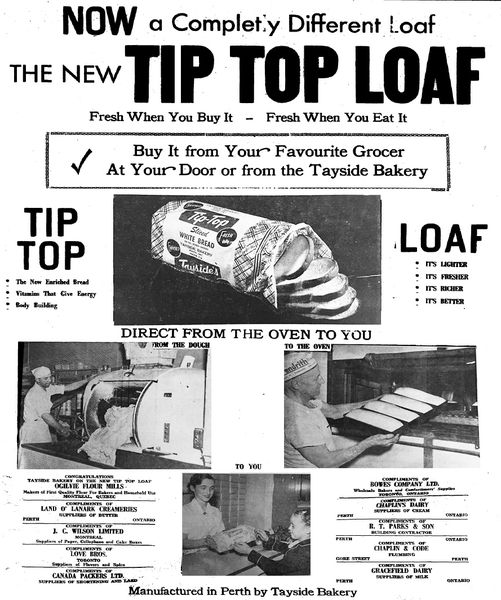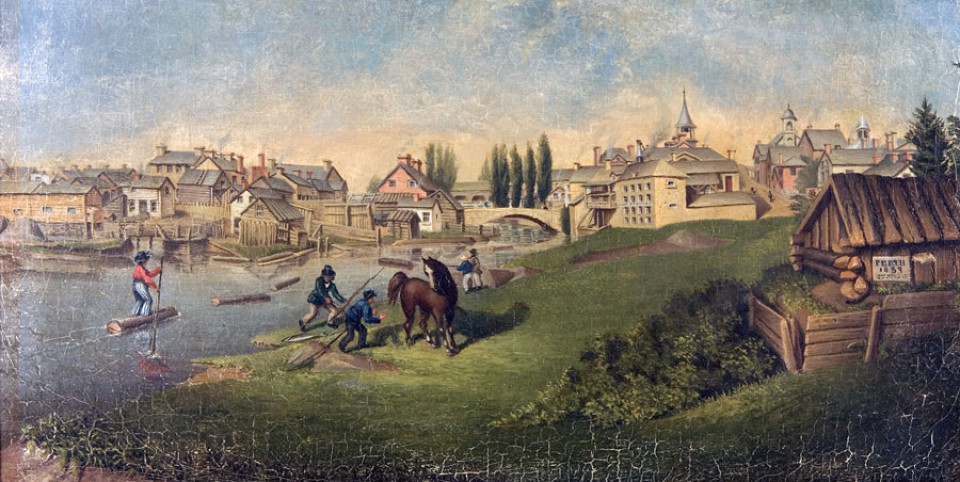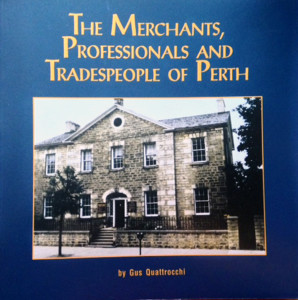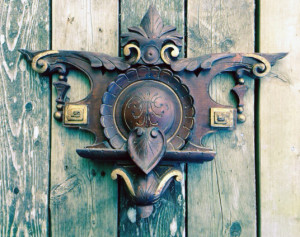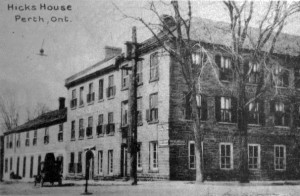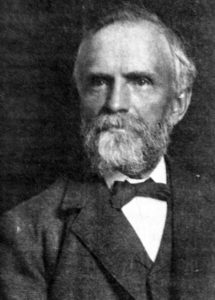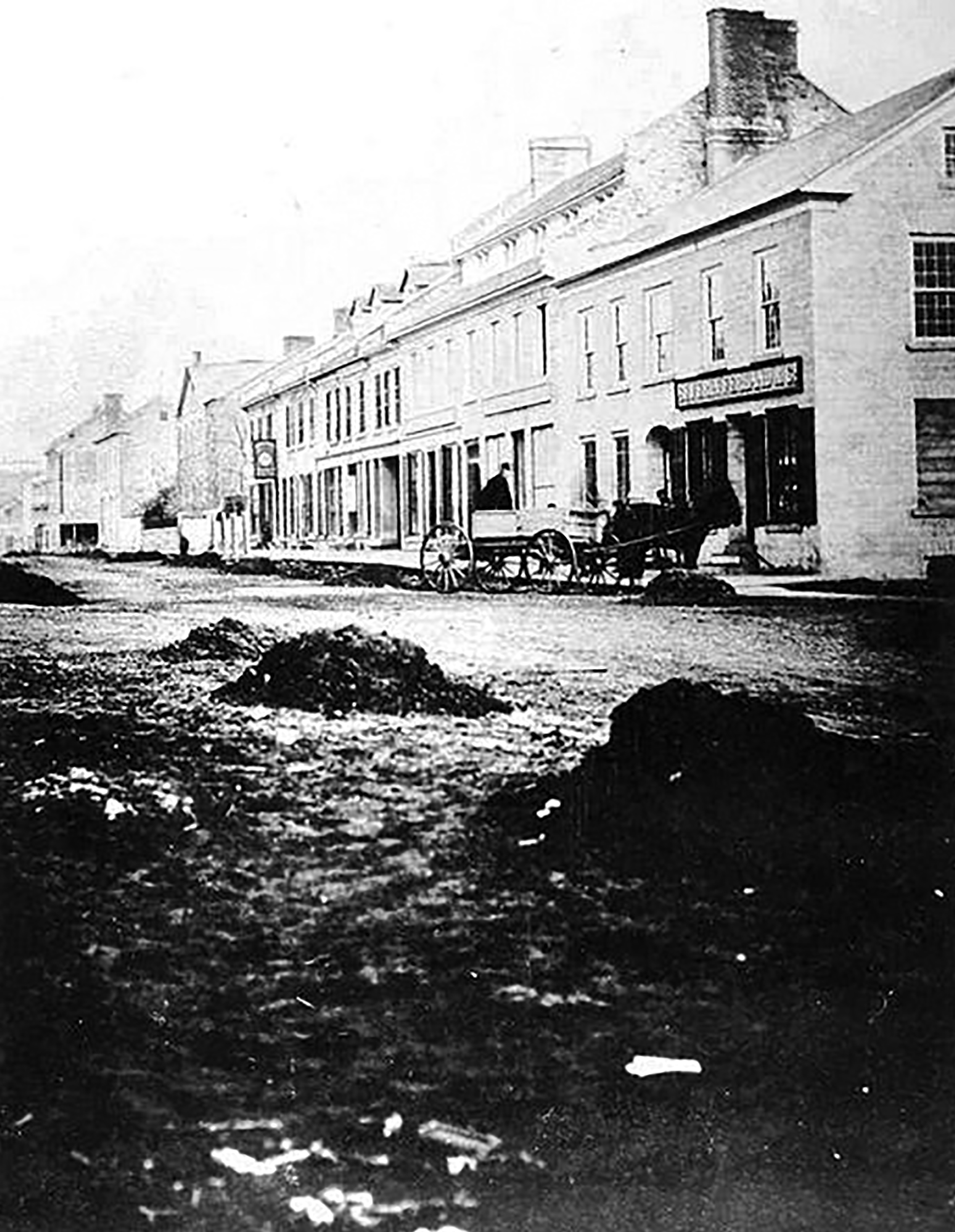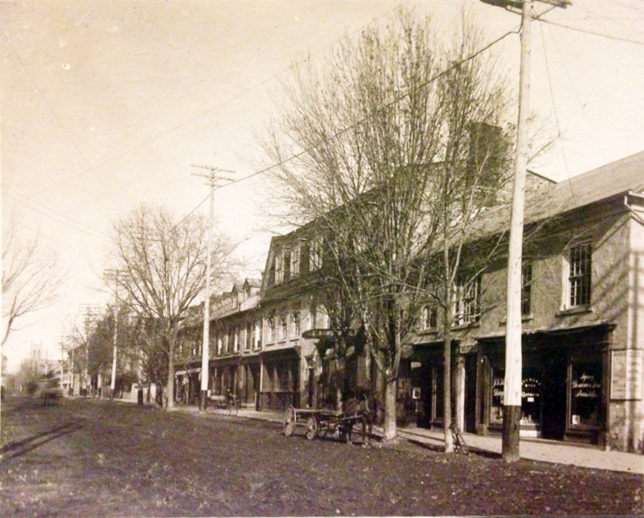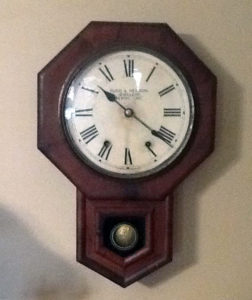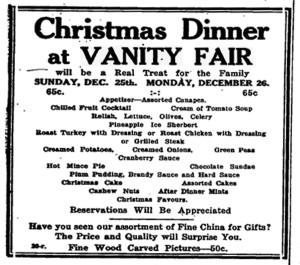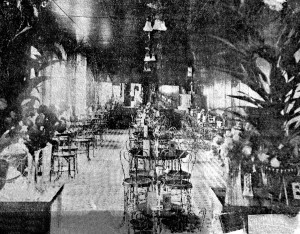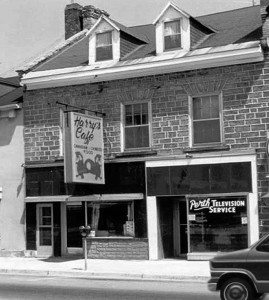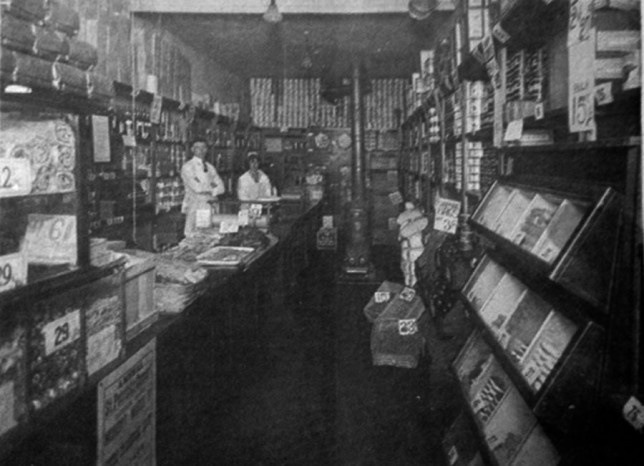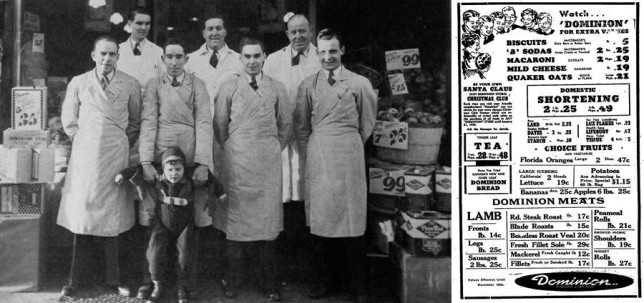This page only gives a glimpse of some to the merchants and businesses in the late 1890’s into the early 1900’s. For a complete history of the Merchants of Perth a must read and reference is:
The Merchants, Professionals and Tradespeople of Perth, Gus Quattrocchi, Perth (1997)
The Merchants, Professionals and Tradespeople of Perth by Gus Quattrocchi. This book is a record of 180 years of history of the merchants of Perth. This book is available at the Museum and other merchants in downtown Perth. All proceeds from the sale of this book are directed to the continued good works of the Perth Museum.
To purchase this book: The Perth Museum
THE GRAHAM BLOCK c. 1910
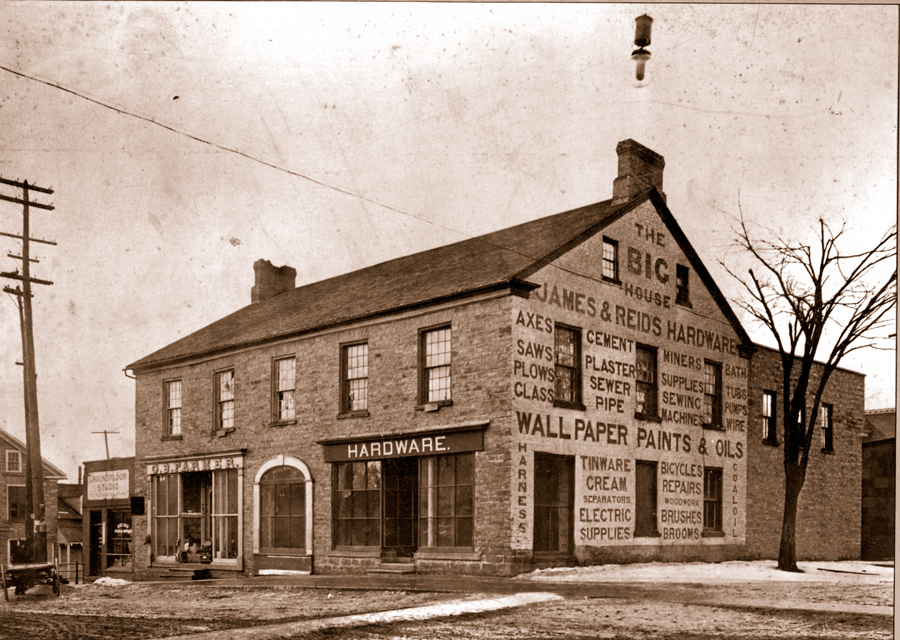
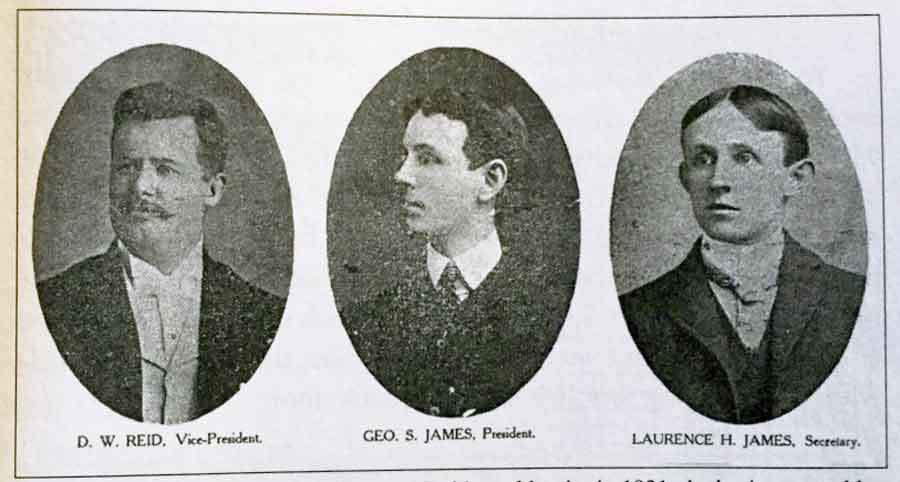
JAMES & REID STAFF 1904
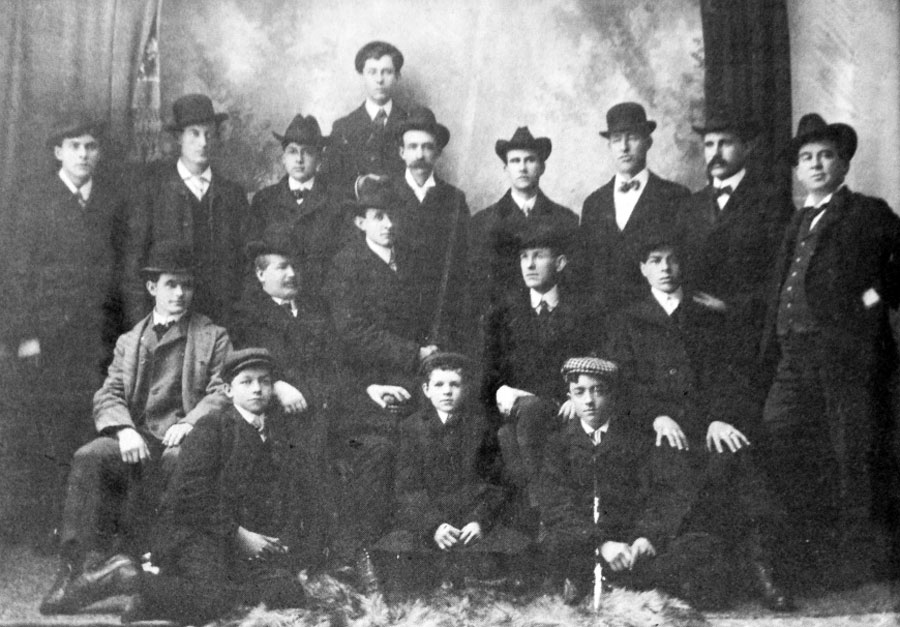
Front row; George Fraser, _?_, Eddie Byrnes. Second row; John Enright, D. W. Reid, L. H. James, George S. James, jack Hogan, George King. Third row; Alex Gaudreau, William Wright, George Kennersley. Top; Fred Bolton.
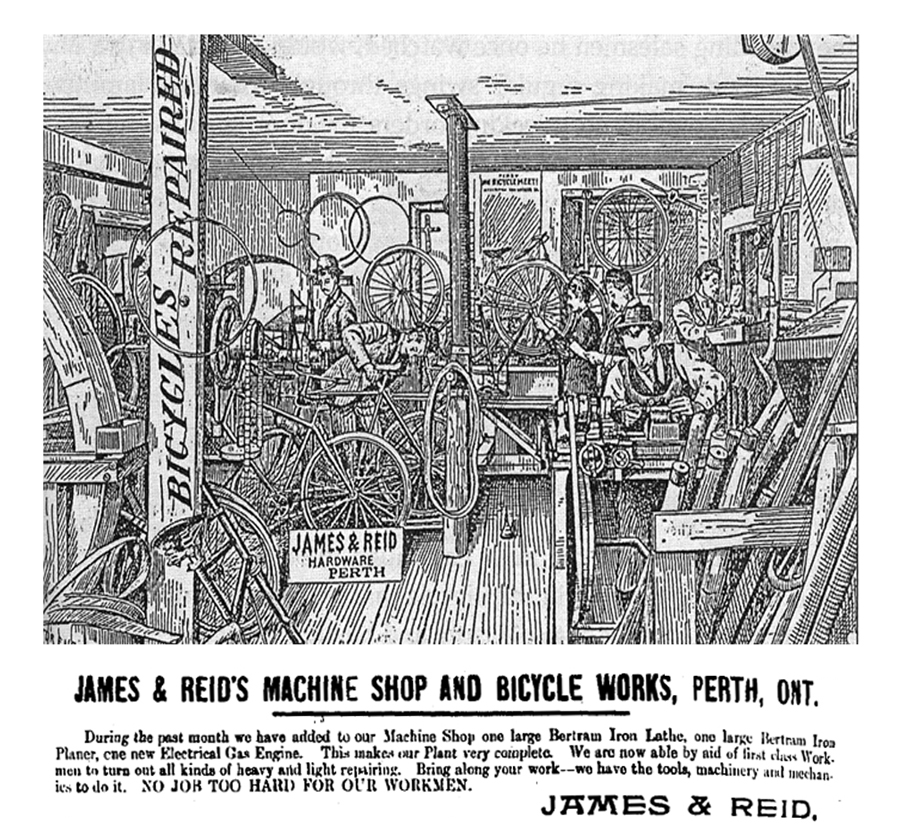
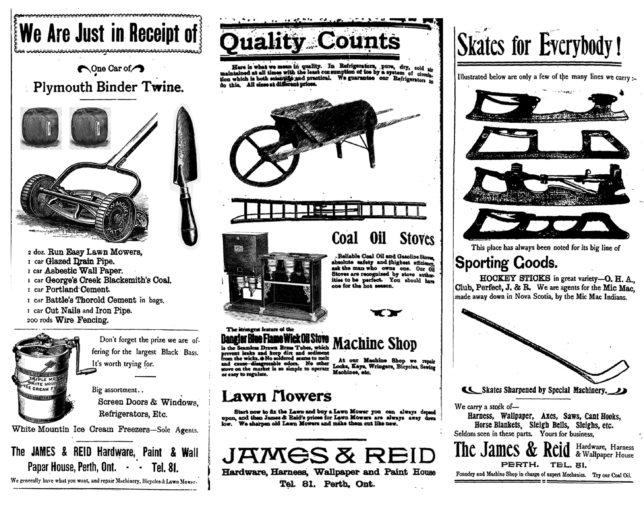
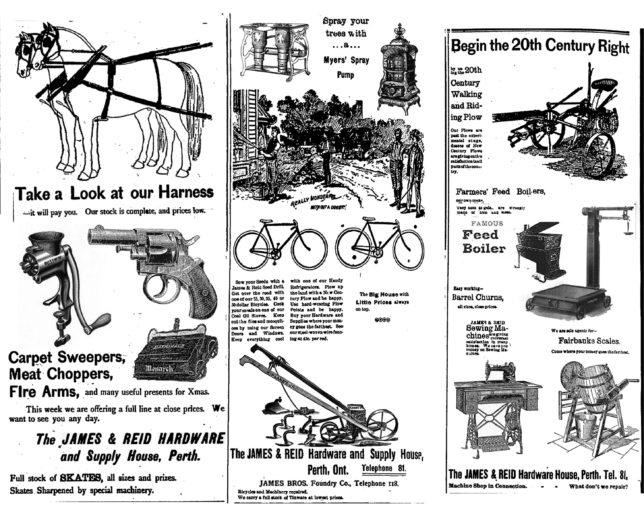
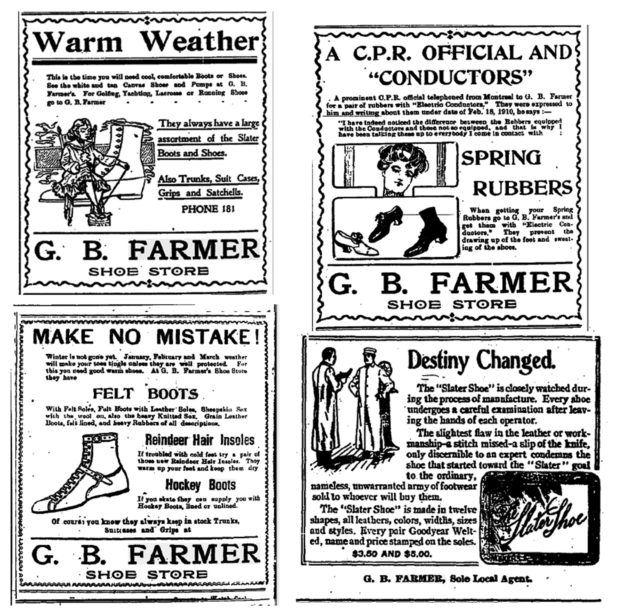
JAMES & REID HARDWARE 1910-1921
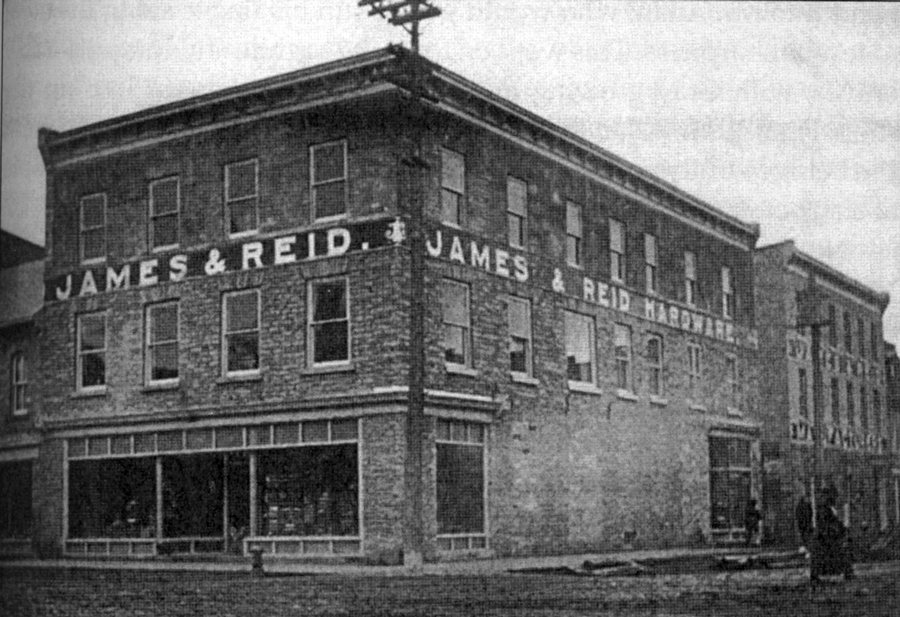
James & Reid Hardware c.1912. Building rebuilt in 1910 by James & Reid and was home to James & Reid Hardware and then James Brothers Hardware corner of Foster and Gore Streets. Photos: Courtesy The Perth Museum
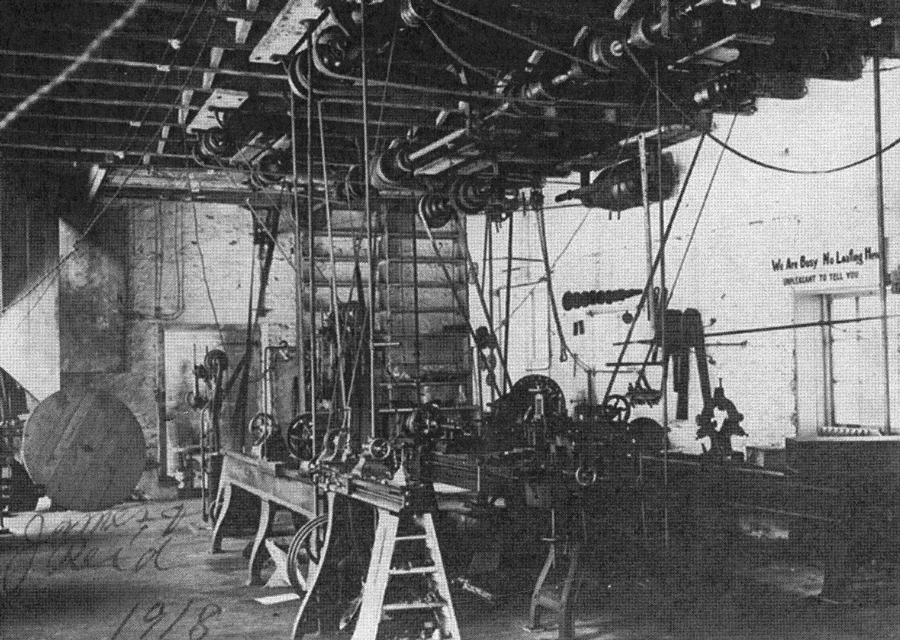
Inside the machine shop at James & Reid, 1918
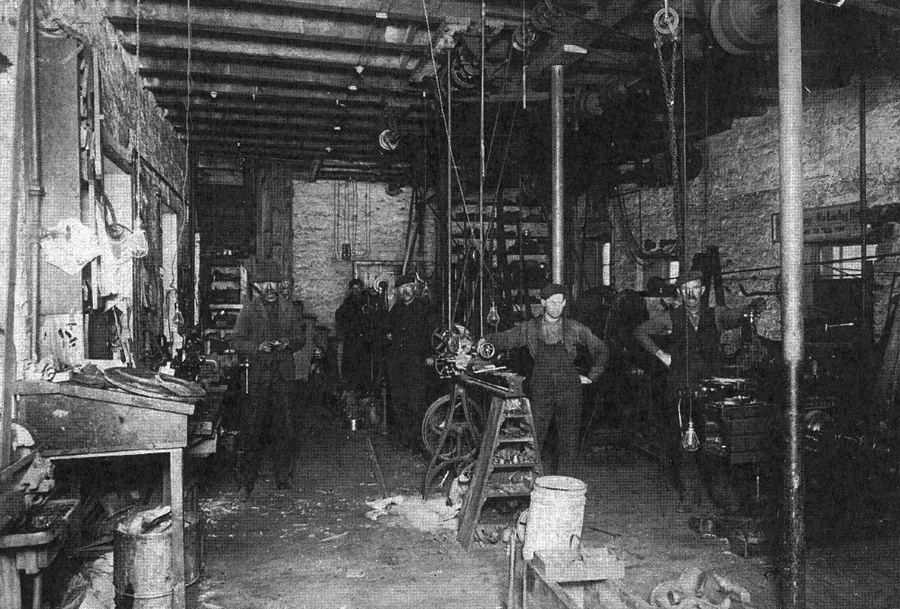
Inside the machine shop at James & Reid, 1918
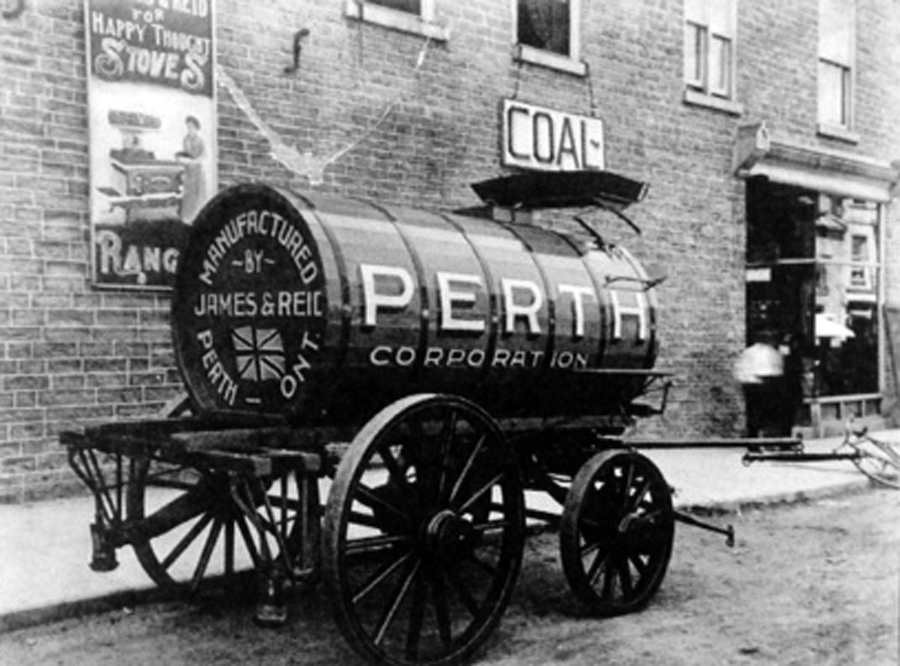
Perth Water Tank used to keep the dust down on the town streets, manufactured by James & Reid. Photo: Perth Museum
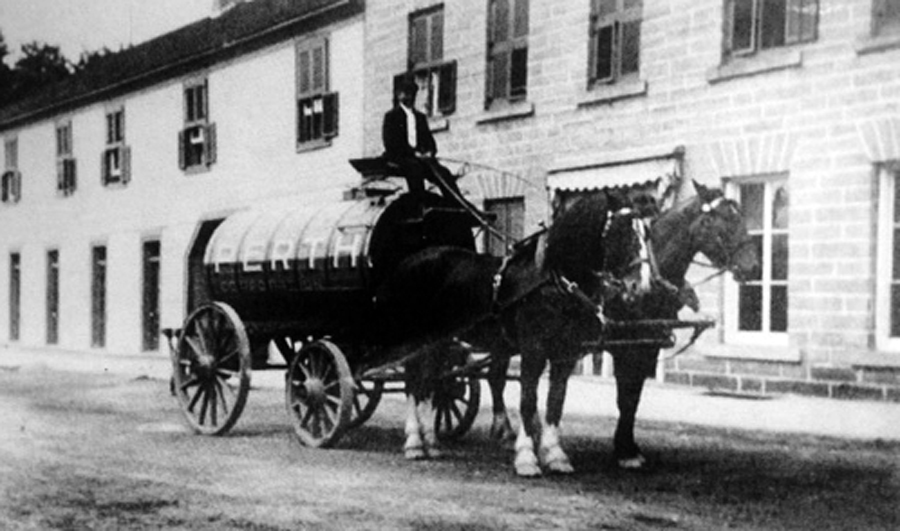
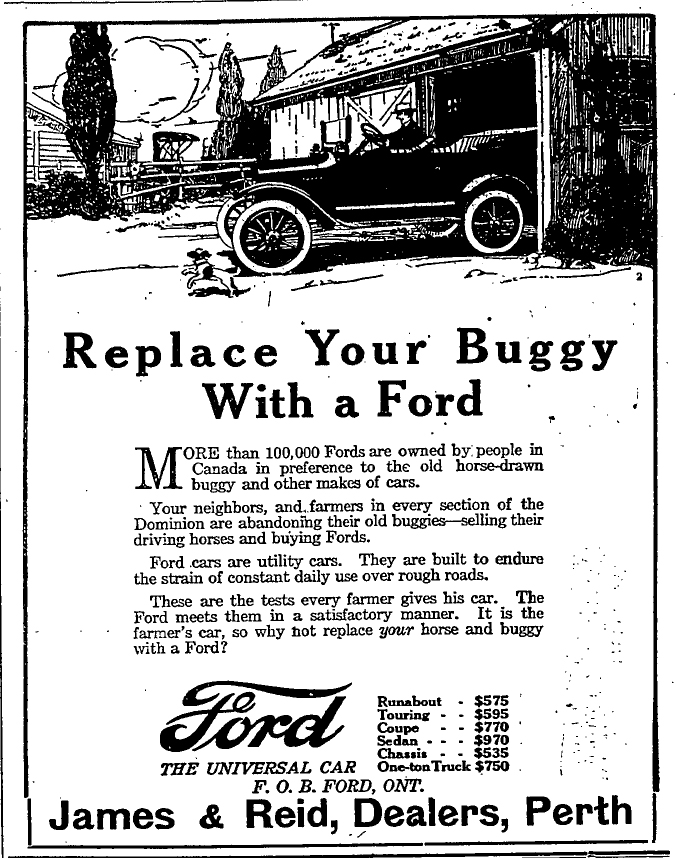
Picture taken on Gore Street beside the Perth Hotel
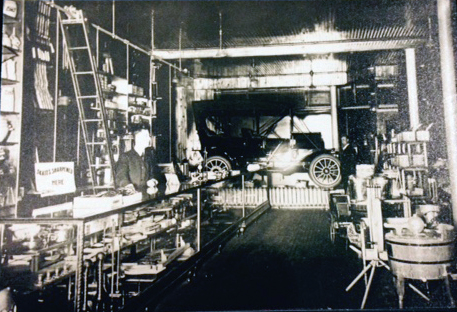
George James at the counter c.1920. Photo courtesy The Perth Museum.
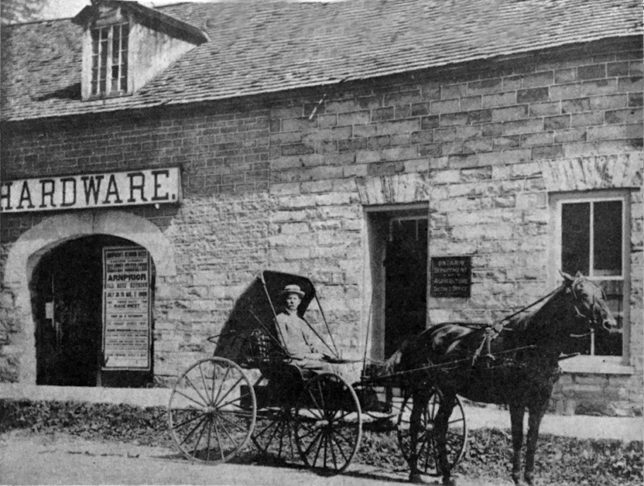
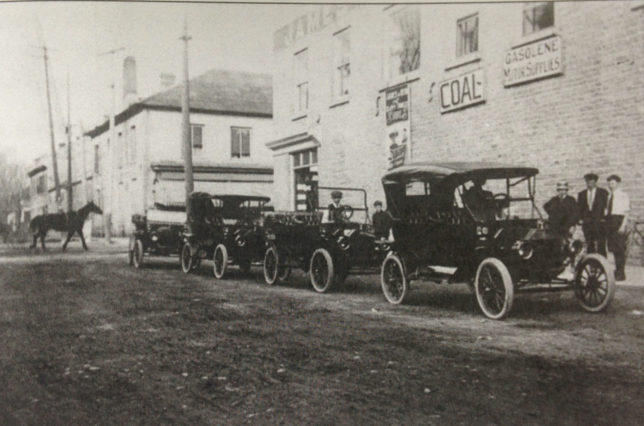
JAMES BROTHERS HARDWARE 1921
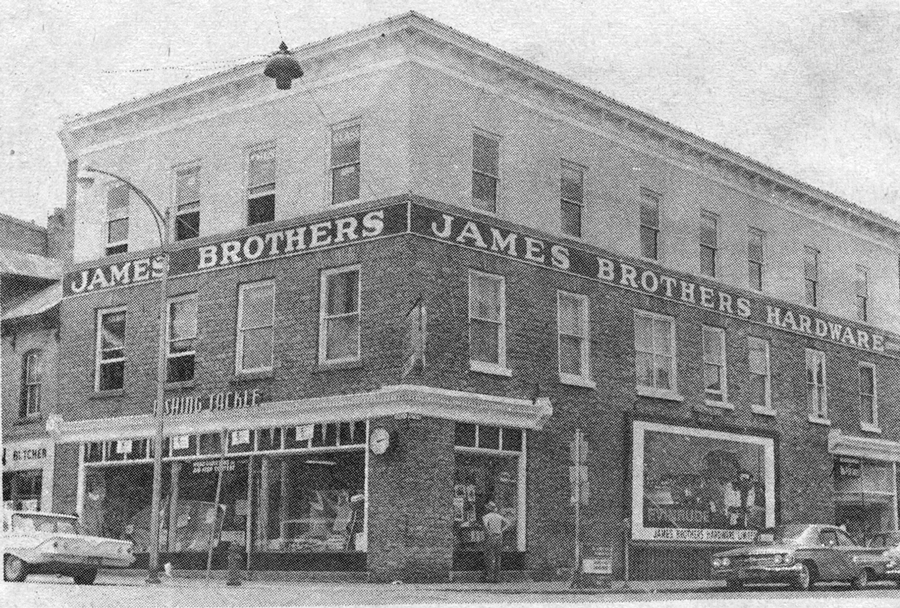
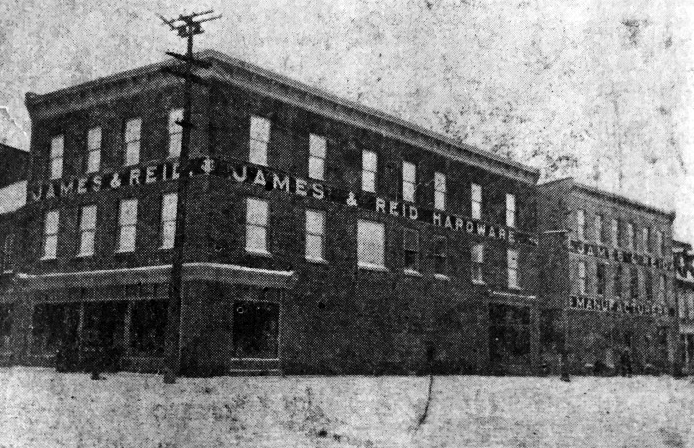

James Brothers Machine Shop on Foster Street 1963. Photo: The Perth Courier
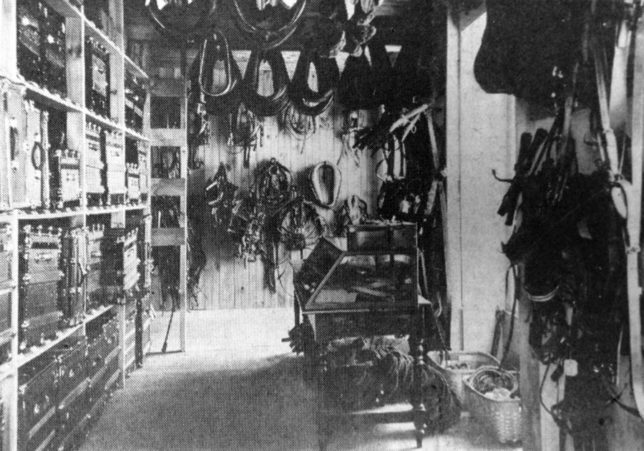
Storage room at James Brothers
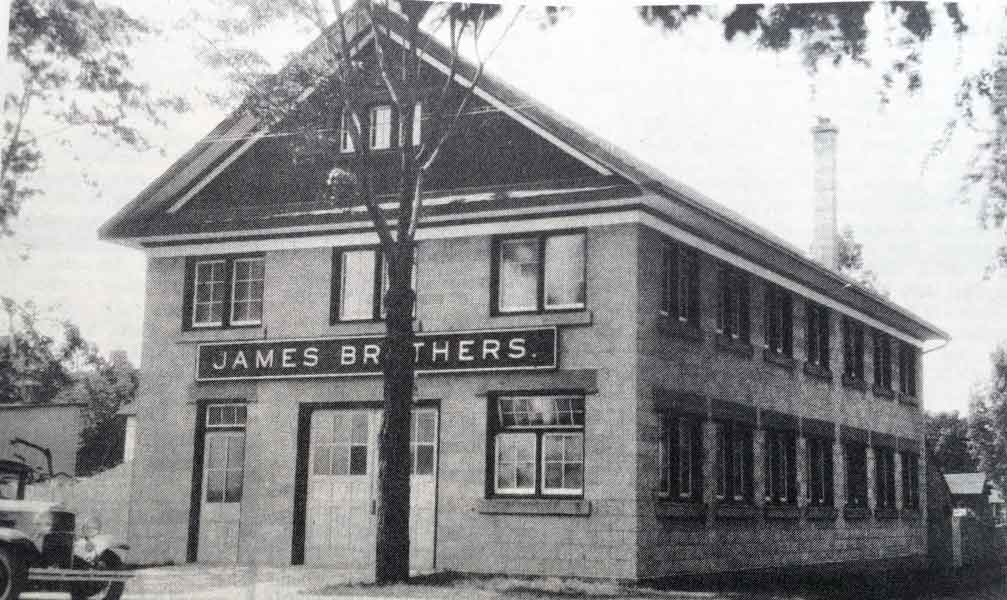
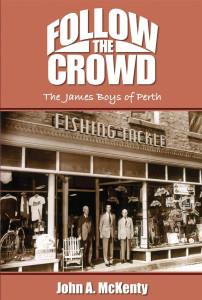
James Brother’s new building on Herriott Street that replaced the old foundry. c.1930For more in-depth history of James Brothers and a great read is Follow The Crowd by John McKenty. For this and other books by John McKenty go to:
WARREN & McCARTHY HARDWARE 1888
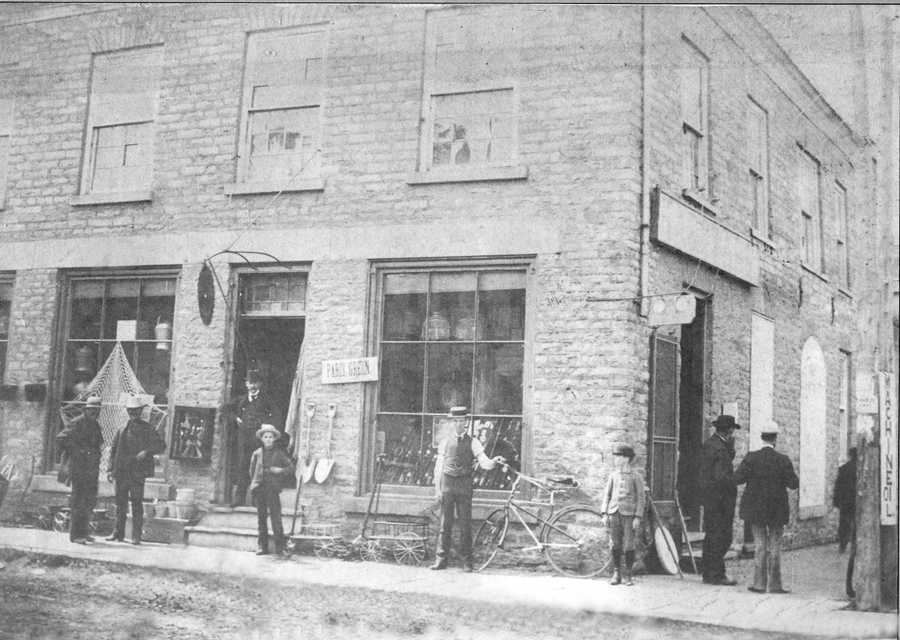

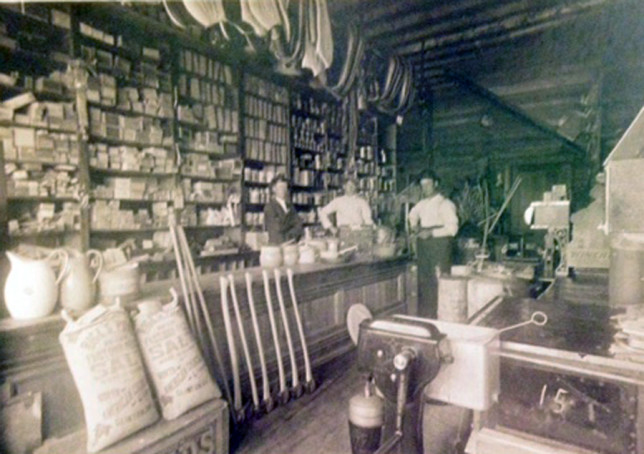
BLACK SANDY FERGUSON HOTEL 1835 – REVERE HOUSE 1869
Alexander (Black Sandy) Ferguson built one of the first stone buildings in Perth (1920’s) on the site of what is the present day Red Fox. It was used as a store, but in 1835 it was rebuilt into a 1 ½ storey building to be used as a hotel. His son John ran the Waterloo Hotel, and in the back (about where the parking lots are today) he had a licenced distillery from 1835 until 1839. The distillery housed a 40 gallon copper still. He distilled a Scotch style whiskey which he called “Craigdarroch of Perth”. The distillery may have operated before 1835, as in John Mactaggart’s book “Three Years in Canada” he reminisces about sampling Mr. Ferguson’s product in the late 1820’s, saying he sampled “a whiskey made after the Glenlivet mode by Mr. Ferguson of Foster Street called Craigdarroch of Perth. The flavour is very good: it is by far the most excellent spirit distilled in this country” he goes on to say “A distillery is a thing quite indispensable so that raw grain whiskey may be produced at a couple of shillings per gallon, the flavour of which is qualified by frosty potatoes, and yellow pumpkins. Such aqua is extremely delicious …”. He then goes on to bemoan the common practice of making potato whiskey out of “frosty potatoes, hemlock, pumpkins and black mouldy rye”. Sounds very appetizing.
In 1838 Alexander took over running the hotel, and in 1840, he acquired the Still Licence, which he continued until 1844 (this info taken from licence returns published in the Bathurst Courier and supplied to this page by Jim Winton)
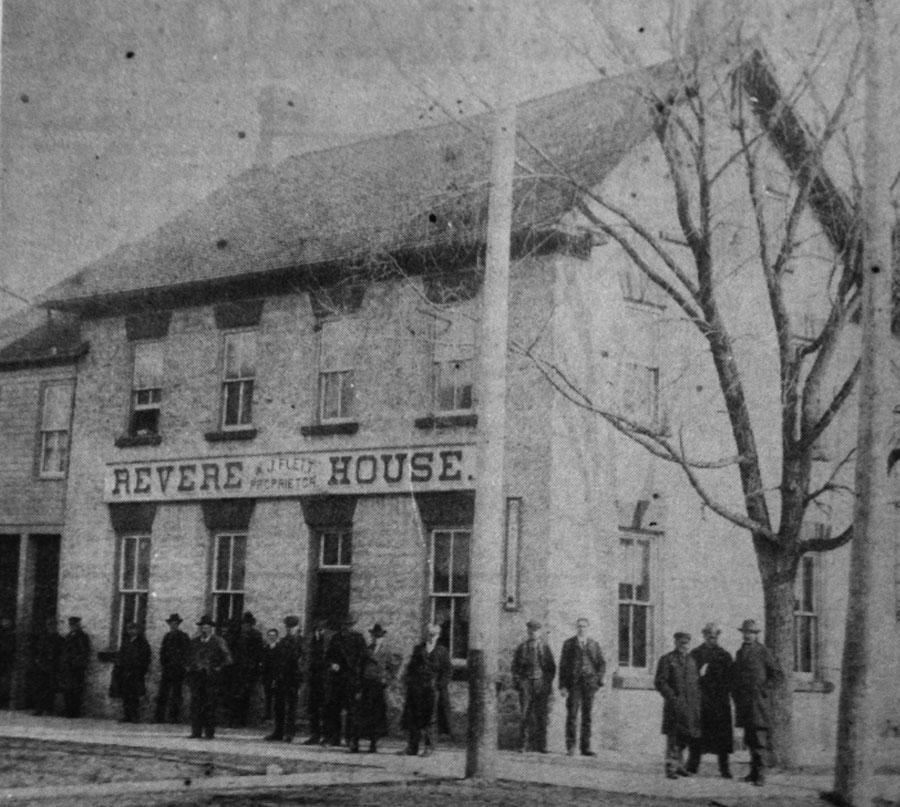
The Revere House before 1901
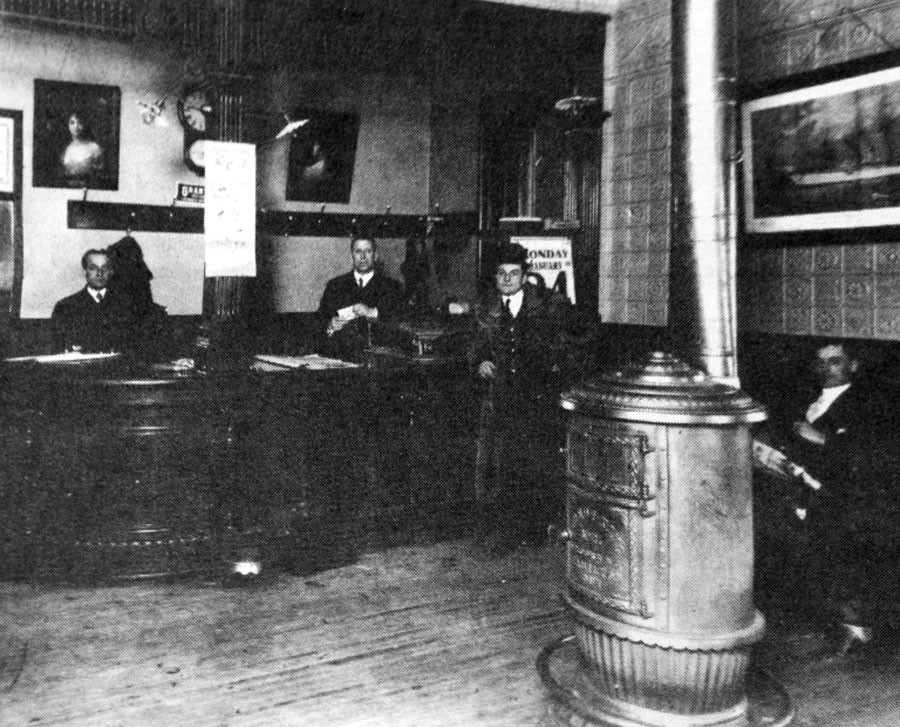
Lobby in the Revere House c.1904.
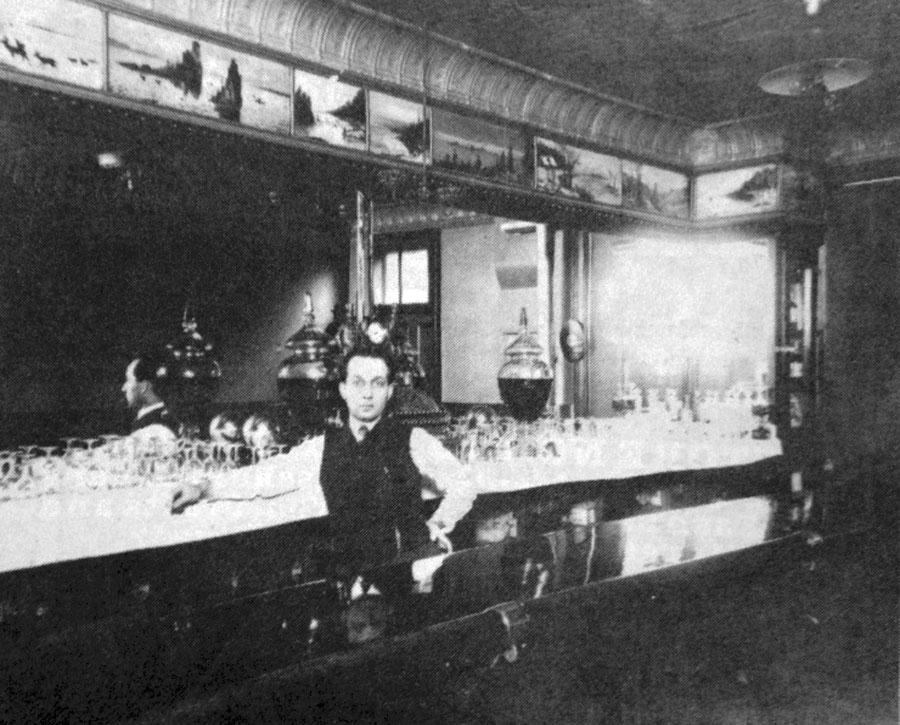
Inside the bar with bartender Pete Kehoe who later became the owner of the hotel. c.1904.
R. E. Borrowman Collection, Negative No. PA-079239. Public Archives of Canada.
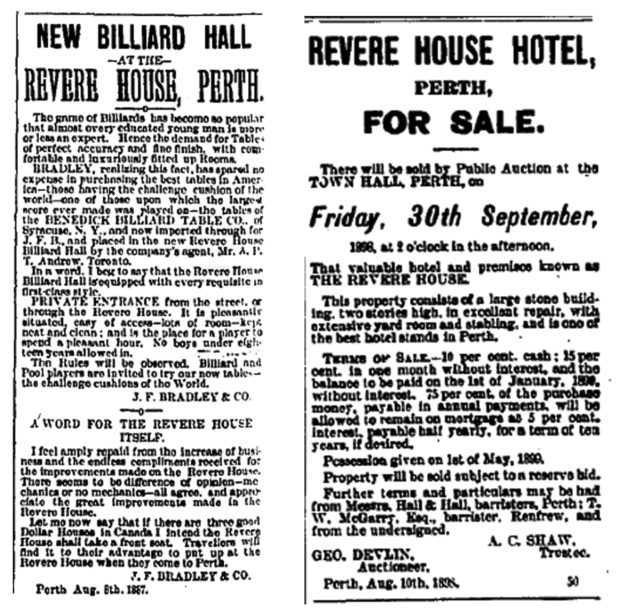
This wooden crest hung over the bar in the Men’s Bar at the Revere Hotel
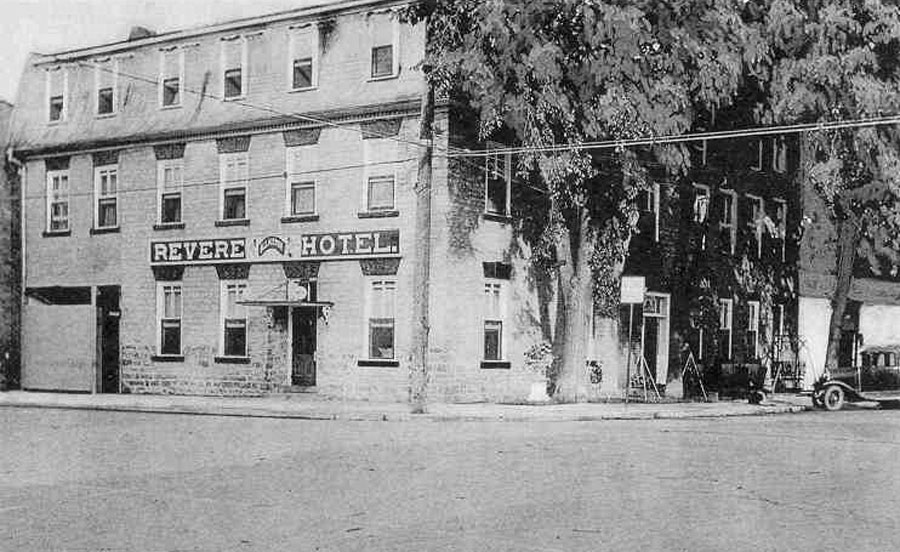
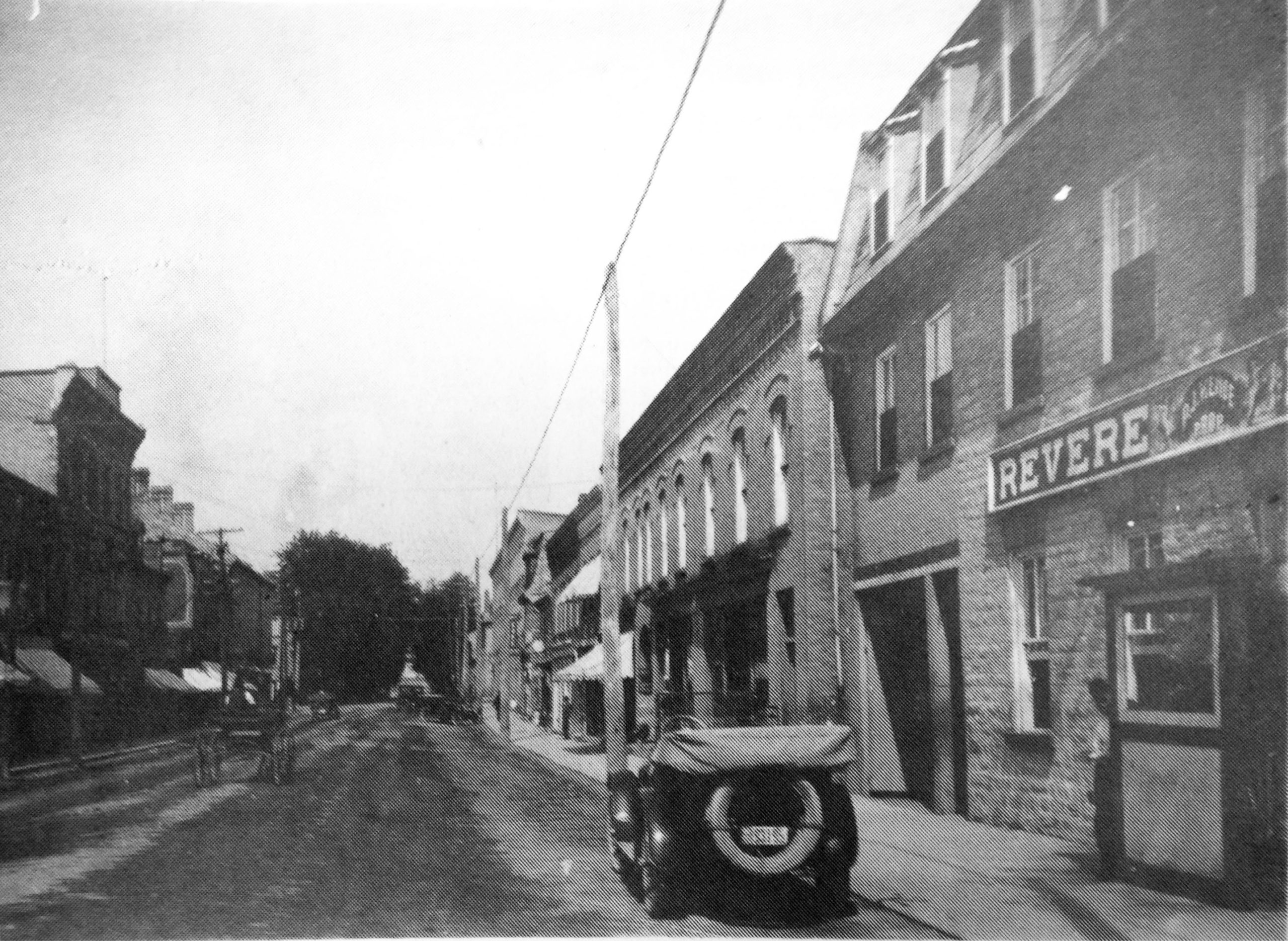
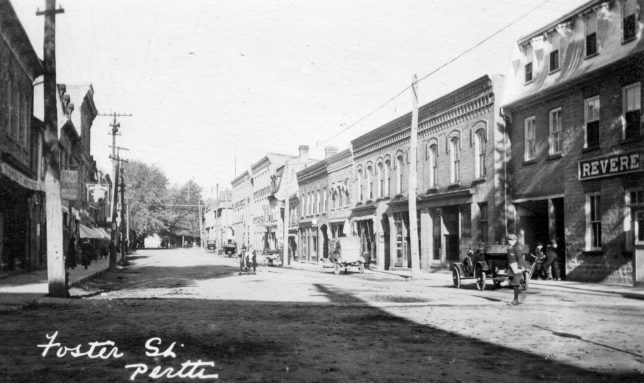
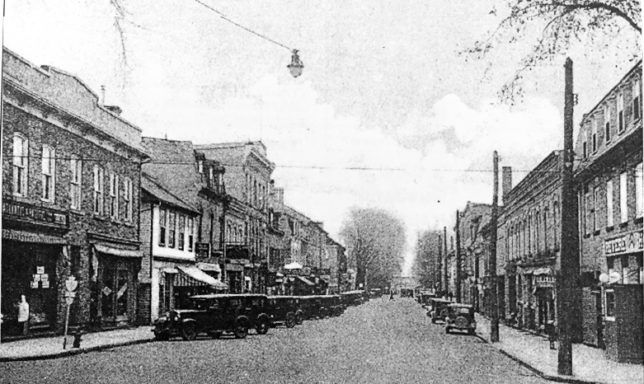
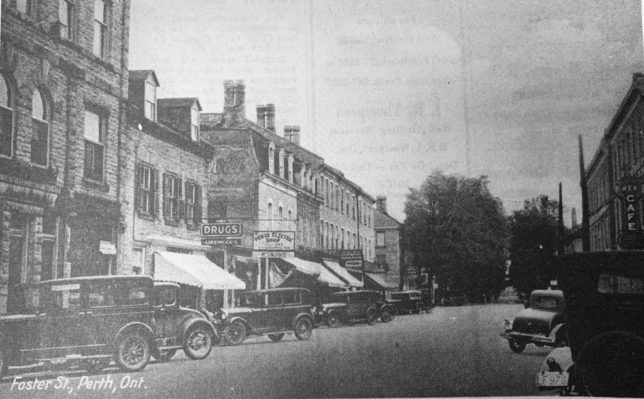
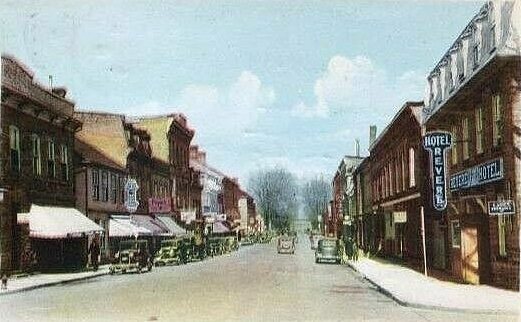
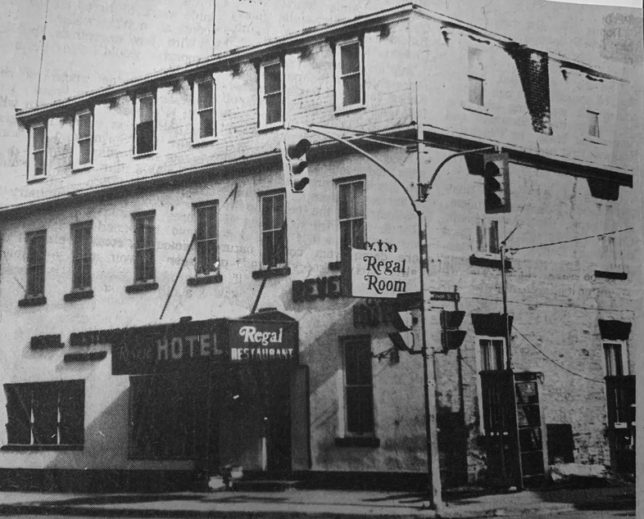
RATHWELL’S HOTEL
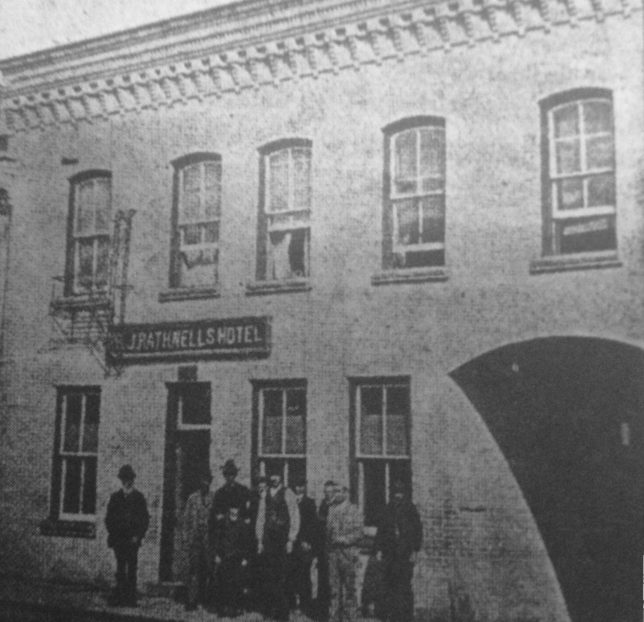
A. MEIGHEN AND BROS., corner of Foster and Gore Streets, c. 1890. Established 1848
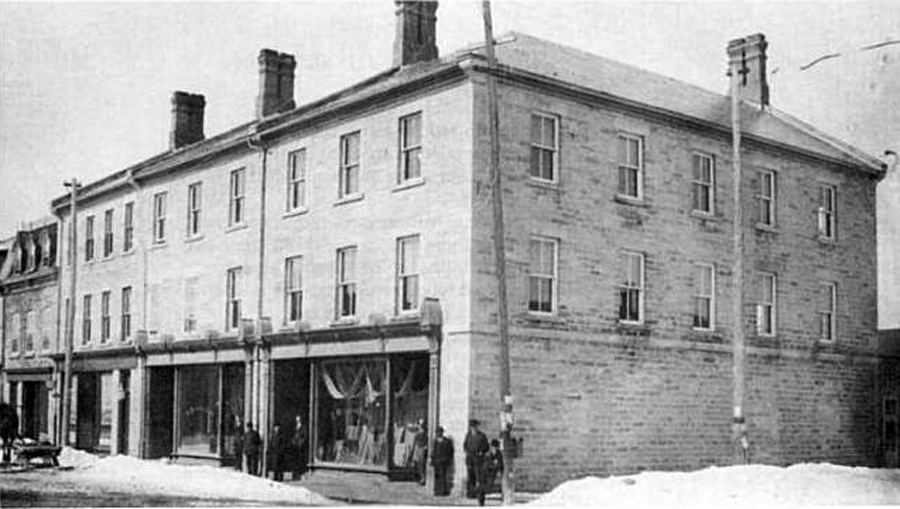
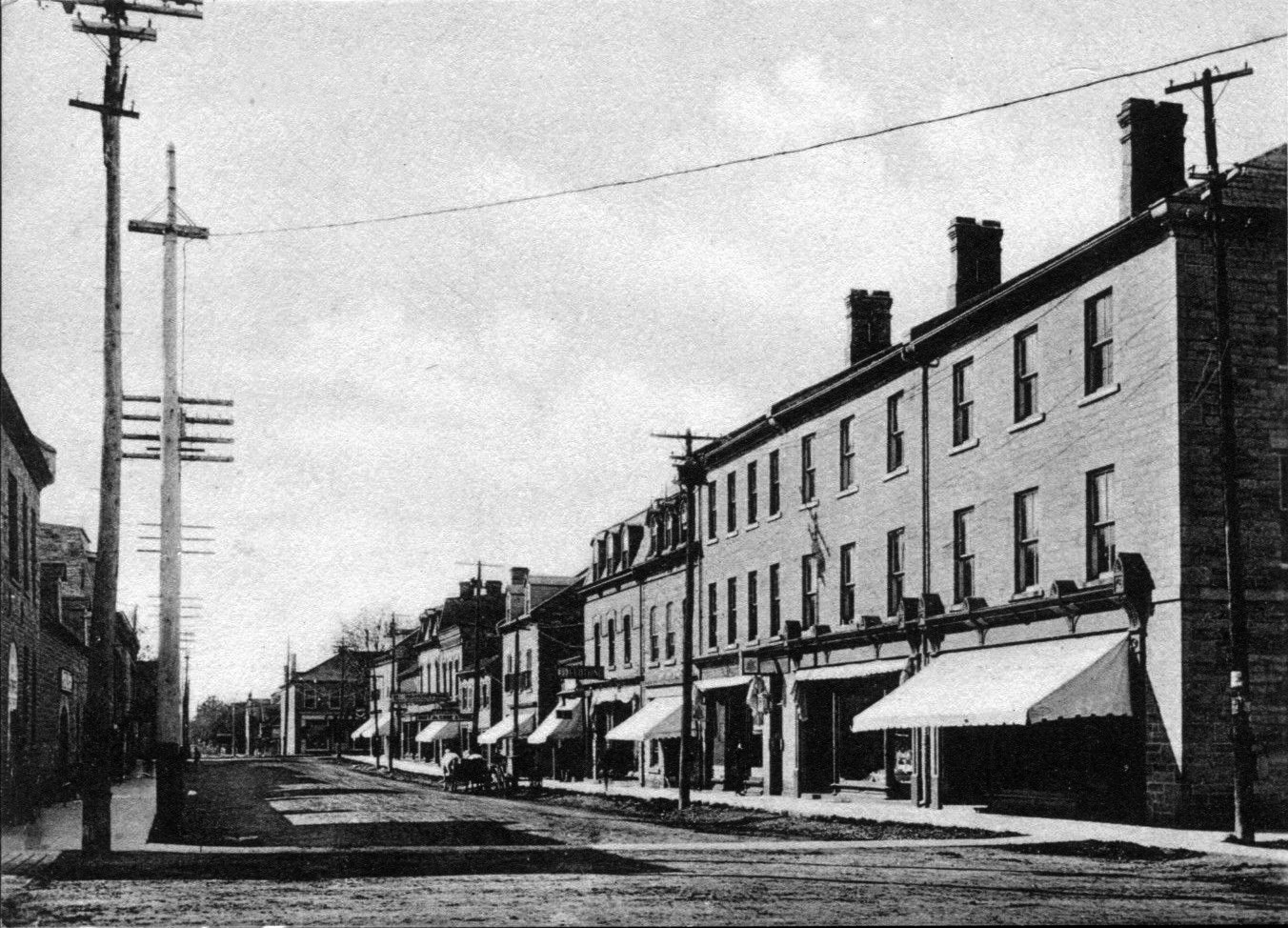
Foster Street looking down to Wilson Street and at the corner of Wilson and Peter Street is Mendels.
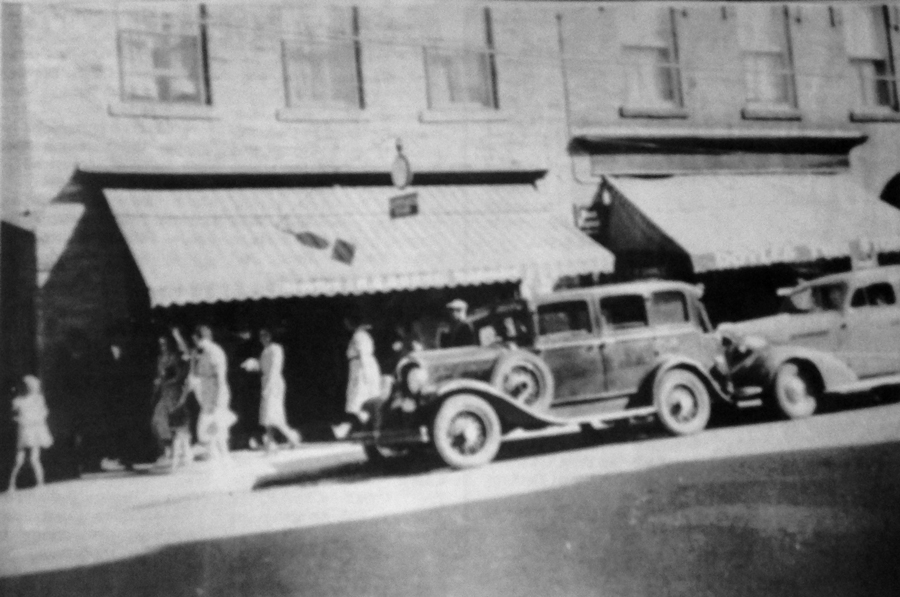
Burns Jewellery 1930
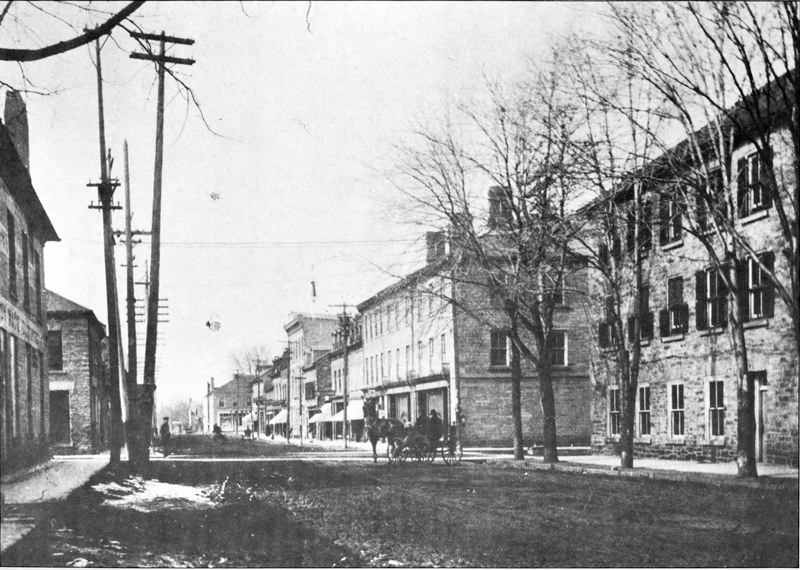

Intersection of Gore and Foster Streets with the Hicks Hotel to the right and Shaw’s to the left in the foreground. In the distance at the corner of Wilson and Peter Street is Mendels.
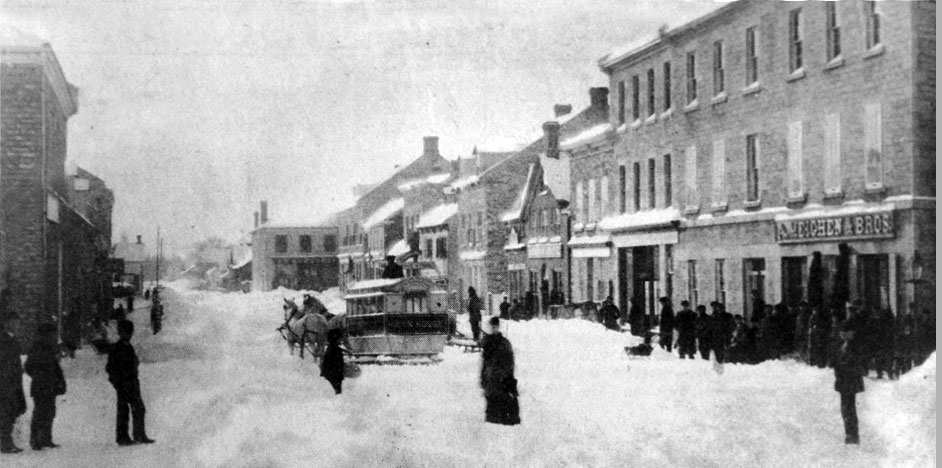
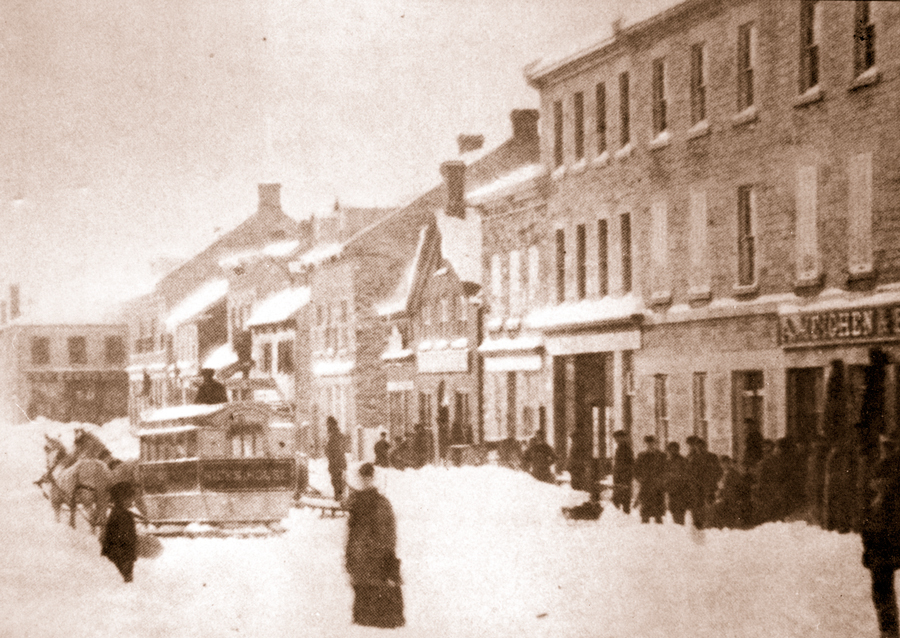
Winter time on Foster Street around the turn of the century. The store on the right is Meighen Bros. and at the end of the street can be seen the store of J.H. Mendel’s. This building was demolished in 1946 to make room for the Art Deco Perkin’s building. Horse drawn Hick’s Hotel Bus that was used to convey people to the Hotel from the C.P.R Station is shown in the centre of the picture.Foster Street looking West from Gore Street to Wilson Street showing the north side of the street. The horse drawn sleigh/tram is for the Hicks House later the Perth Hotel. In the distance where the Perkins Building is now situated was first J T Hendersons General Merchant then Charles and James Gent’s Furnishings and then J H Mendel’s Department Store. To the right is A. Meighen & Brothers Gent’s Furnishings (men’s clothing). Between 1898 and 1899 other business on Foster Street: Sutherland’s Restaurant would be here on the north side of Foster Street near Gore Street as well as Rudd and Neilson Watchmakers this picture. Dr. R V Fowler’s office would be located on Foster Street. The Perth Expositor Newspaper was on the south-east corner of Gore and Foster, C.F. Stone Prop. H T Noonan Grocers south side of Foster near Wilson. James Paterson Grocers south side Foster between Gore and Wilson Streets. Doyles Flour and Feed, Dickenson Brothers Dry Goods and Groceries south side Foster between Gore and Wilson Streets beside the Queen’s Hotel, F.L. Hall Chemists north side Foster Street and A Wilson Boots and Shoes on the north side of Foster. 1930 – Oct. 4 – R.A. Beamish Co. established the first in his chain of stores in the Meighen Block.
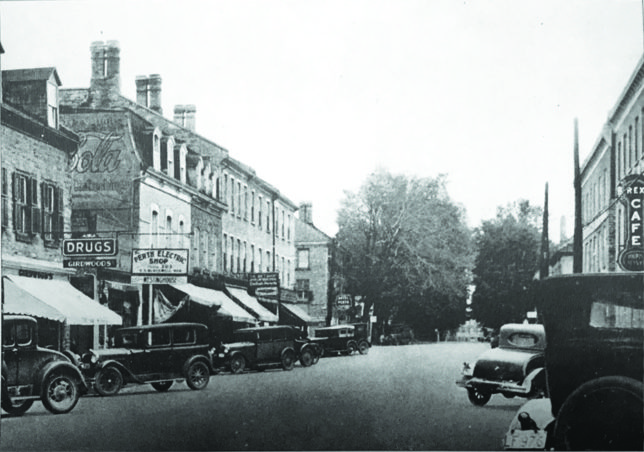
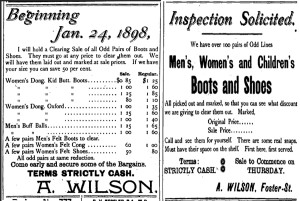
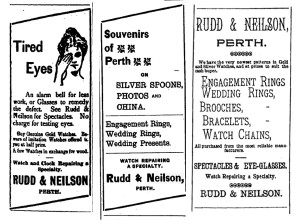
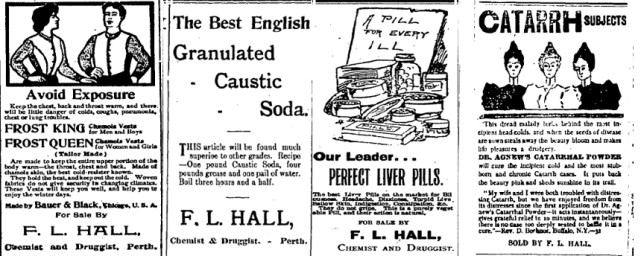
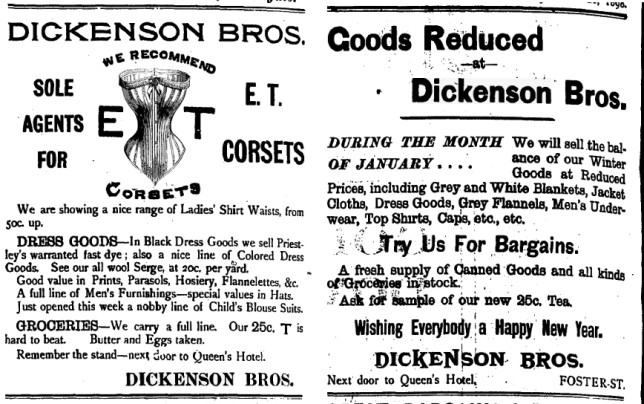
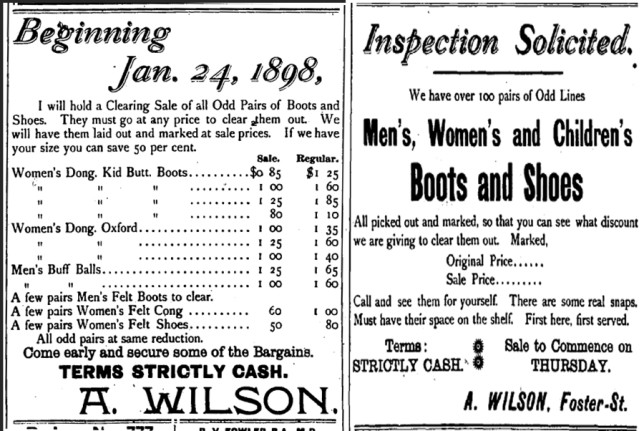
RUDD & NEILSON JEWELLERS 1889-1937

Photo 1904. Andrew Rudd and Henry Neilson establish a partnership in 1889. Watchmakers, jewellers and stationers. The firm dealt in watches, clocks, jewelry, silverware, spectacles, stationery etc. Marriage Licenses were also issued here.
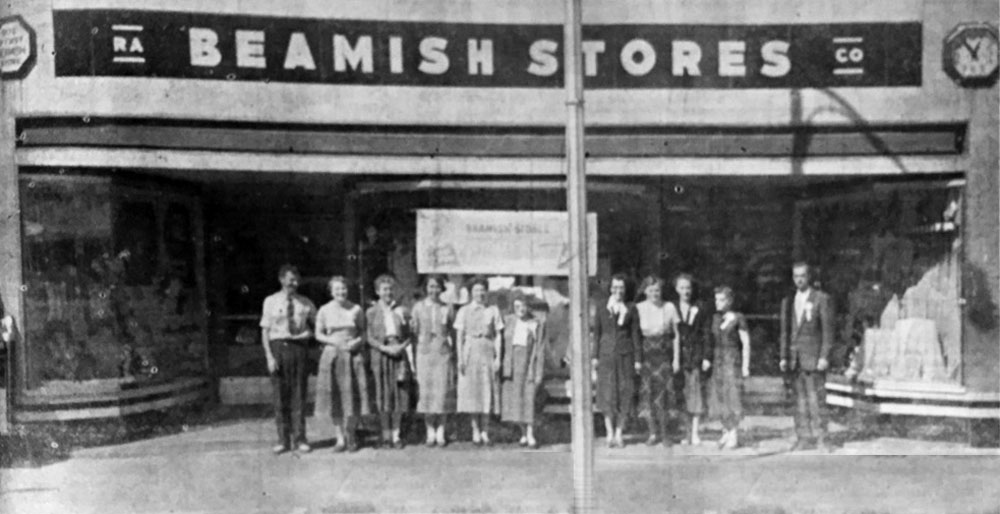
Employees in front of the Beamish Store on Foster Street, 1955 on their 25th Anniversary. In 1930, Beamish Stores opened in Perth at the corner of Gore and Foster Streets, and was the first store in their chain that numbered 38 in 1958. The founder was R.A. Beamish of Perth. When Beamish Stores commenced operations in Perth in 1930, very little was known of the Variety Stores business, in fact Beamish Stores was one of the two wholly Canadian owned companies at the time. Beamish Stores were unique in that they continued to grow in smaller localities because of the need for that type of merchant in the smaller towns than in the cities. In 1958 the store moved to a new location on Gore Street in the location of the former Perth Theatre. Standing to the right is R. Lyle Beamish, President.
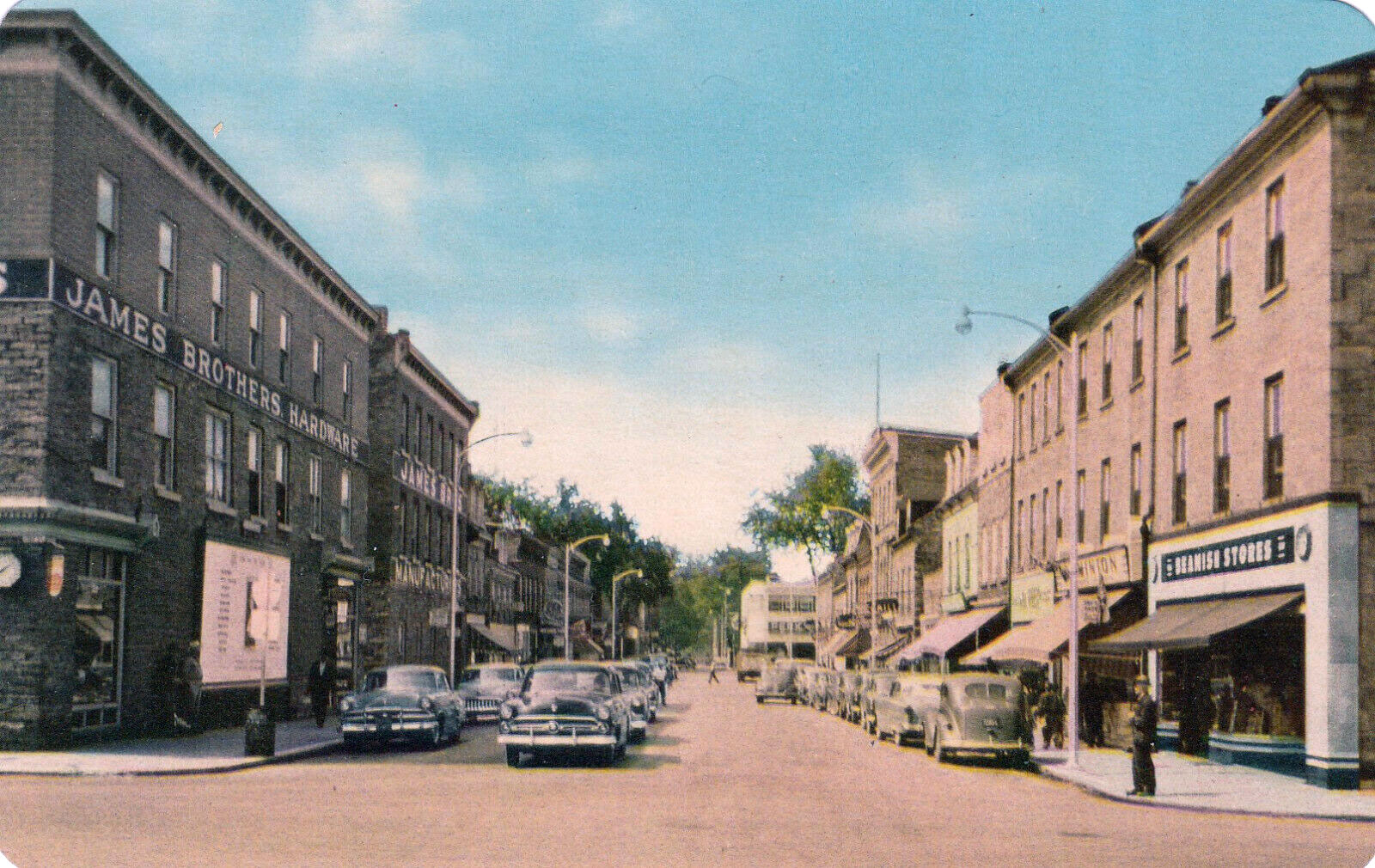
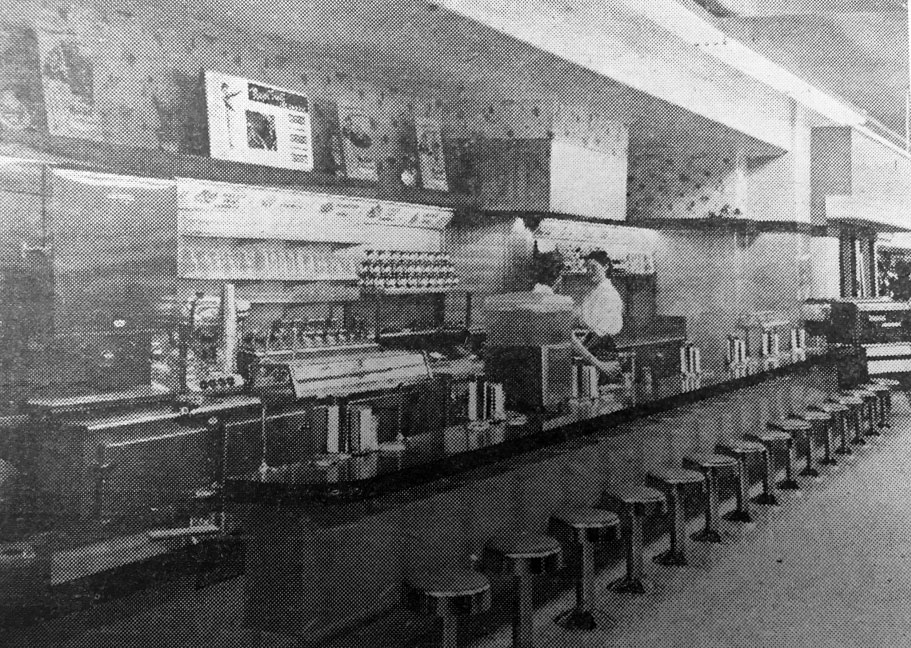
Beamish Lunch Counter in the new store on Gore Street, 1958
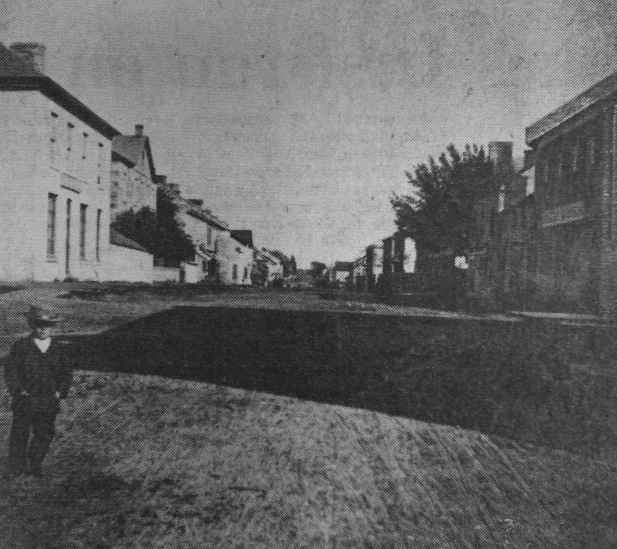
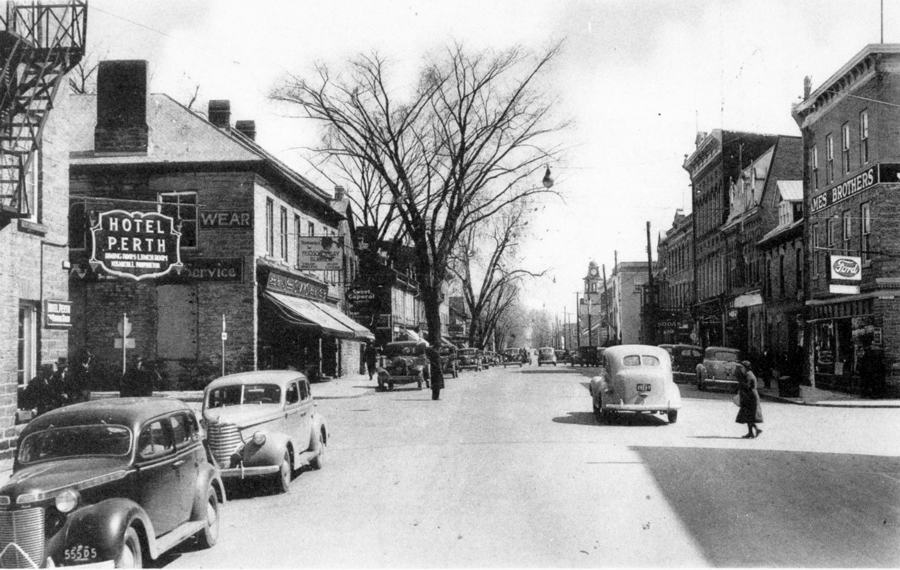
Looking down Foster Street from Gore Street early 1950s. The store on the right is Beamish’s. 1930-56 – R.A. Beamish opened the first 5 and 10 type of variety store in this corner location and because of its success was the first in a chain that had stores all around the Ottawa Valley. When the Perth Theatre closed in 1956 the store moved to that larger location on Gore Street.
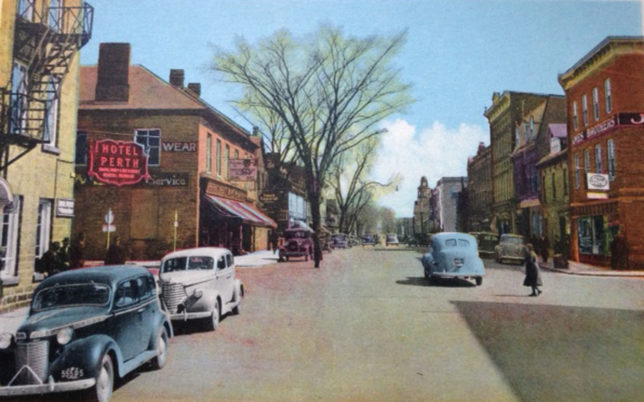
THE HICKS HOUSE/HOTEL PERTH
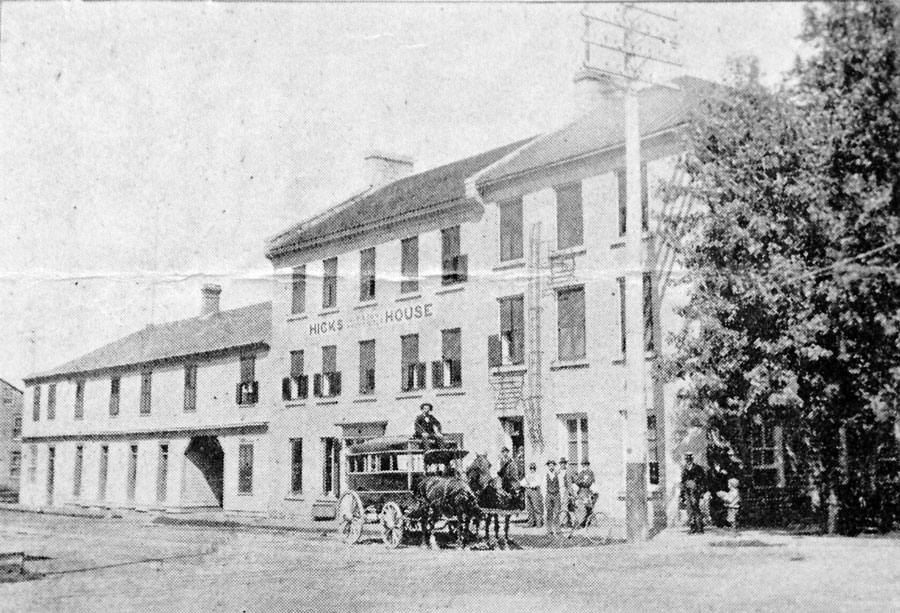
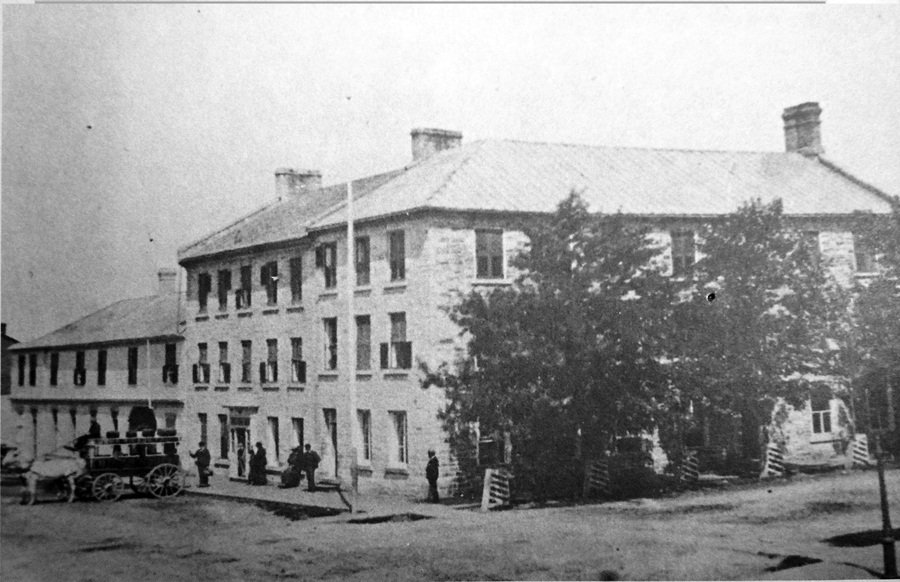
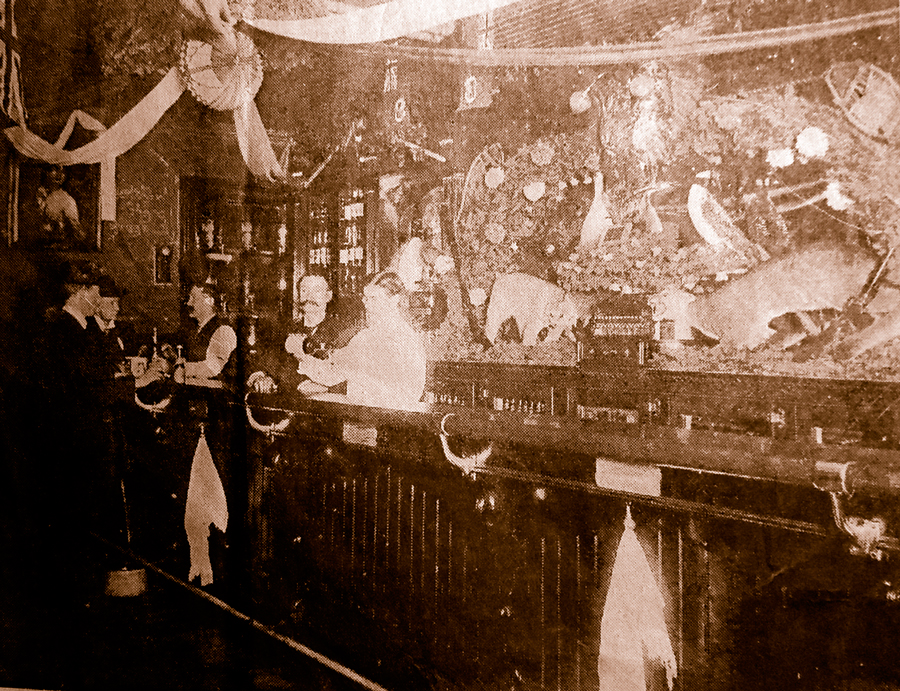
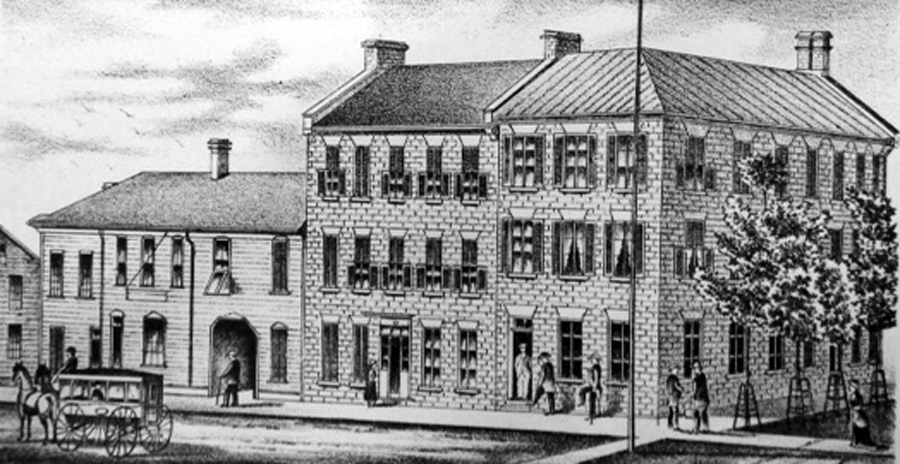
Hicks Hotel, William Hicks proprietor. Perth Ontario. Free Bus for customers.The Hotel has a very lengthy careeer and was first started in 1826 by Alexander Ferguson who received the deed from the Crown on June 20th. In the same year it was bought by William Matheson who in furn sold it the next year to Malcolm Cameron. The Hotel became known as the Hicks House in 1872 when it was bought by william Hicks from Alexander Workman an Mary Hall. In 1883 Mr. Hicks sold the property to John Wilson. It gained a reputation as a quality Inn when John Wilson owned it between 1883 and 1909. Known for providing comfortable accommodation, Mr. Wilson, pictured here below behind the bar with the moustache, also provided excellent meals, polite service and a free bus for travellers, winter and summer, to trains and boats. Under his management capacity doubled to 45 rooms. The Hicks House was one of 7 hotels in Perth around this time between 1898 and 1899. There was the Albion Hotel on the north west corner of Gore and Craig Streets, Jas Young Prop., The Allan House on Cockburn Island, A Robinson, Prop., Barries’ Hotel south east corner of Wilson and D’Arcy Streets, John Wilson, Prop., Jackman House, north of Lock’s Bridge, George Jackman, Prop., Queen’s Hotel, south side of Foster between Wilson and Gore Streets, Frank Lambert, Prop. and the Revere House, south east corner of Foster and Wilson Streets, W.J. Flett, Prop. Ad below for Pro. Dorenwend’s visit to the Hicks House, Perth Courier 1896.
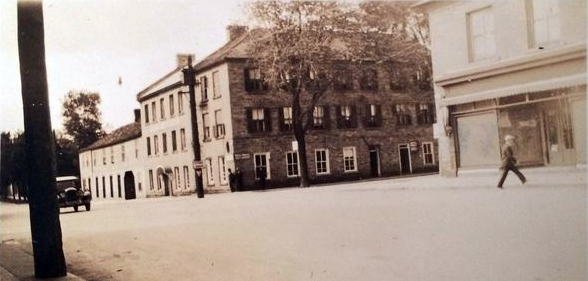
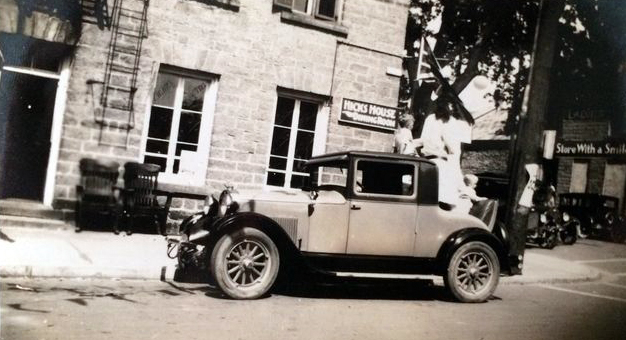
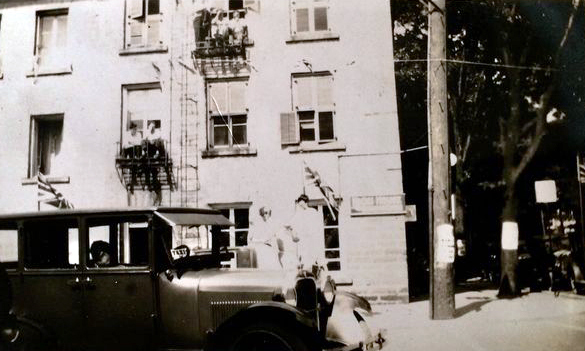
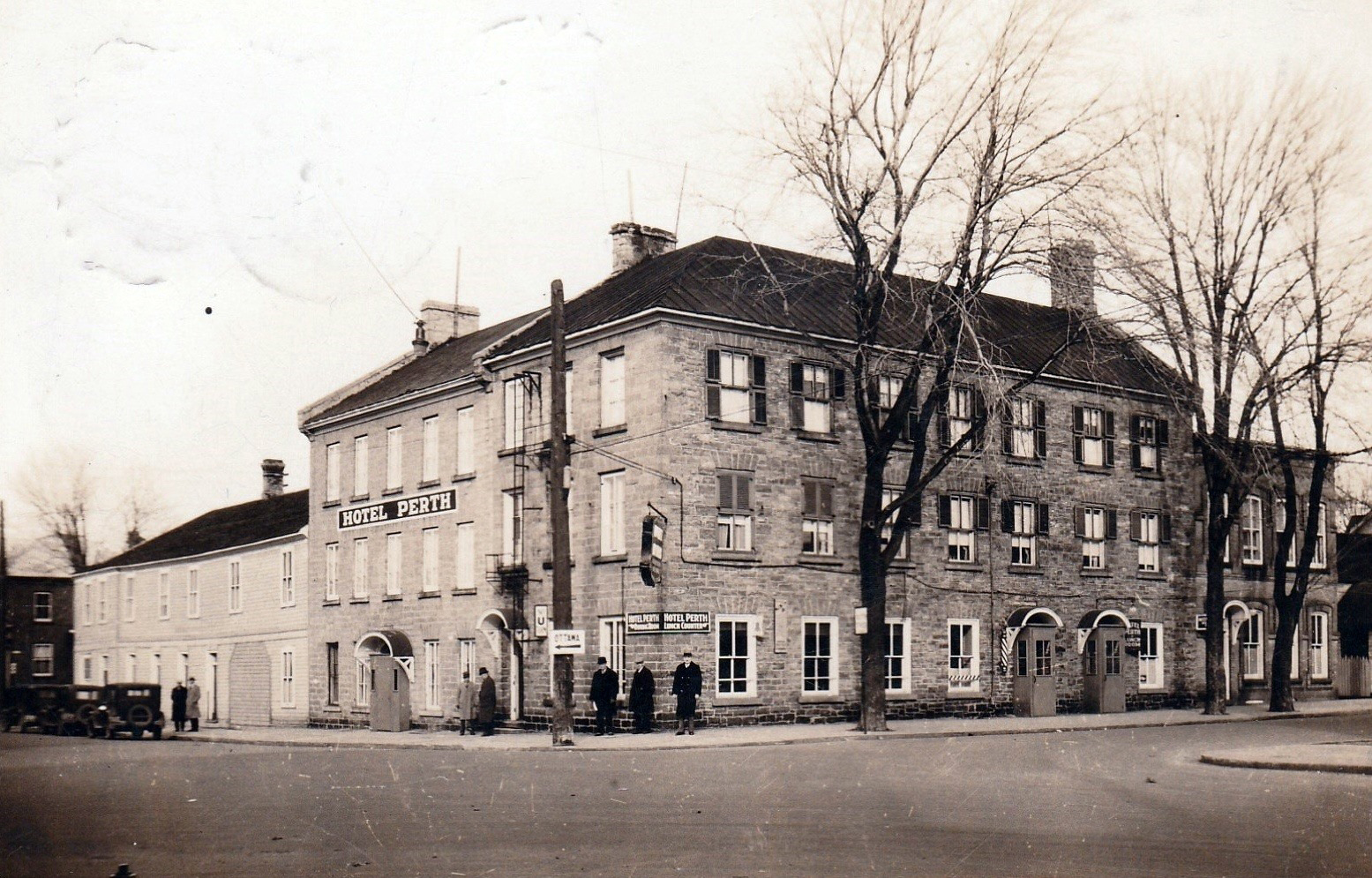
Hotel Perth, 1948. H. D. Duby Prop.

The Dining Room at Hotel Perth and one of the dinner plates.
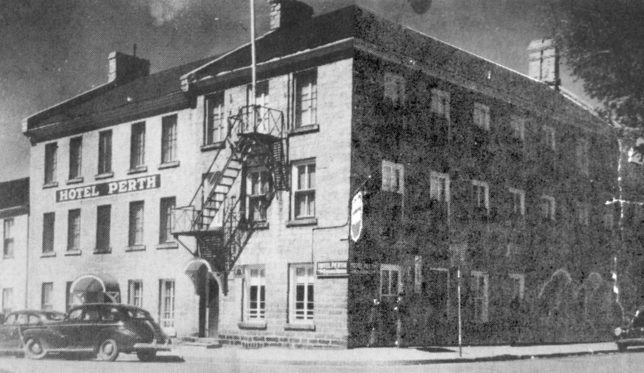
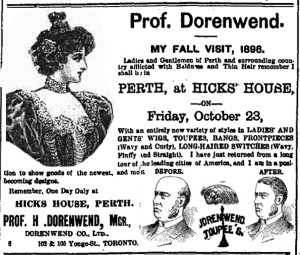
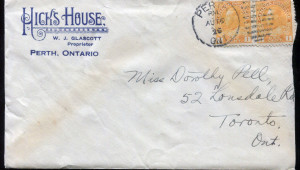
BELL CANADA SWITCHING OFFICE
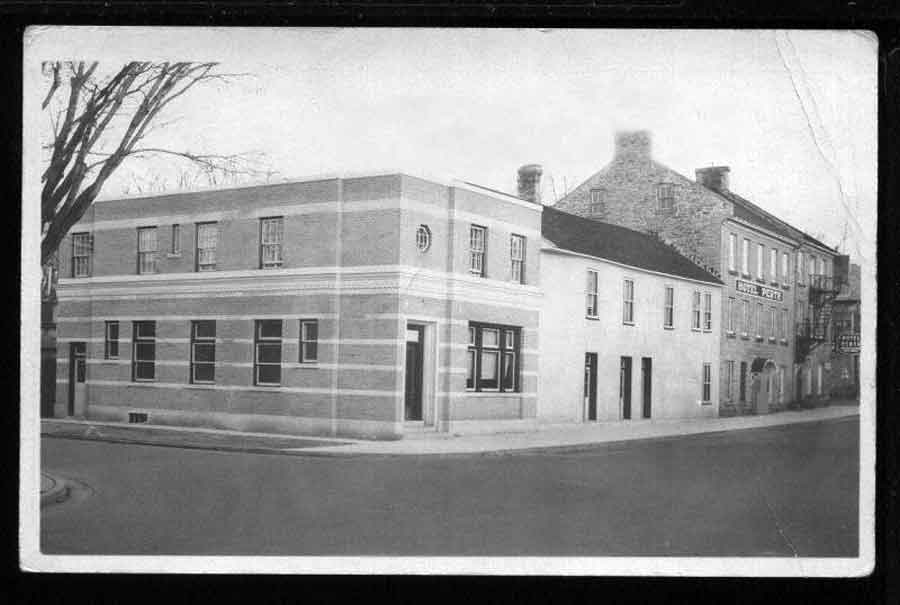
Corner of Gore Street and North Street. Bell Canada office in the foreground with the stucco-clad building located between the Bell building and the stone Perth Hotel building housed the sample rooms, where one could go to view wares that salesmen would bring to town; demolished to make way for the Perth Mews building.
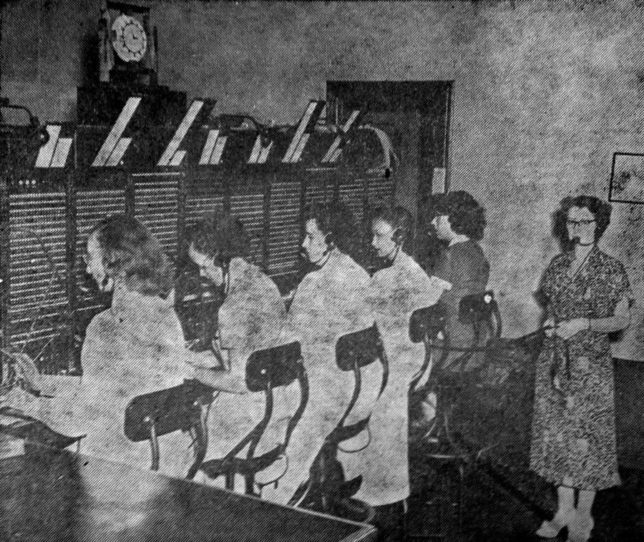
Who remembers their two or three-digit phone number and the friendly voice at the end of the line asking “Number Please”?
That all changed September 15th, 1963 when Perth would have one of the most modern dial exchanges in Canada. There were 2,375 phones in Perth at the time. George Thompson, regional Bell Telephone manager provided the following suggestion about the use of the dial telephone: “The most important step is to be certain you have the right number and if you are in doubt consult your new telephone directory. If the number is not listed dial 411 to reach an information operator. Once you are sure of the number pick up the receiver and hold it to your ear. Listen for the dial tone, a steady humming sound. Now you are ready to dial. Place your index finger firmly in the dial opening through which the first figure of the number desired appears. Pull the dial steadily around to the finger stop. Then remove your finger and allow the dial to spin back by itself. Do not try to hurry it for doing so can result in a wrong number. If you finger slips replace the receiver and start over. After you have dialed the figures of the number listen for the signals. A soft intermittent bur-r-r signifies that the called telephone is ringing and a buzz-buzz-buzz means that it is busy.”
If you had a party line as many of you would remember you would dial the number, hear the busy signal and they you would hang up then both your own and the called party’s bell would ring. When the ringing would stop that would mean that the called party has answered and you would pick up and answer.
When this picture was taken in 1951 there were over 1,600 telephones in service in Perth. The picture shows the operators at their switchboard. Included in the group were operators, Primrose Lindop, Helen Dodds, Constance Horan, Joyce Code and Rhona Huddleston with chief operator Nettie Burke. In 1935 the telephone exchange was located in the Meighen block on Foster street and then moved the building attached to and behind the Perth Hotel at the corner of Gore and North Street.
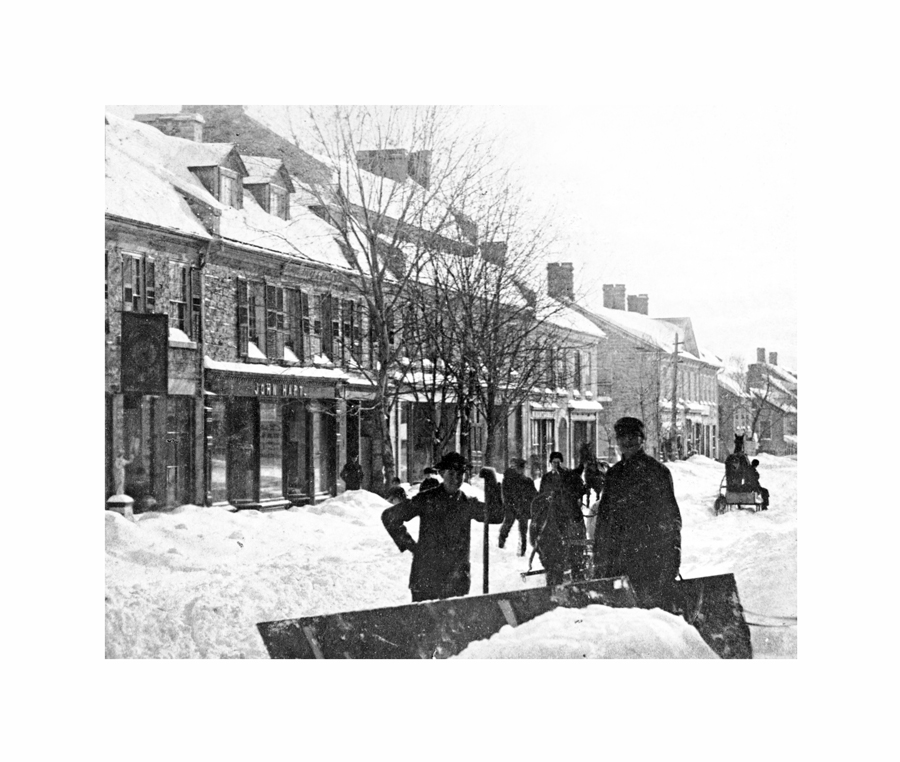
Winter storm on Gore Street looking down to Herriot Street Corner. c,1890
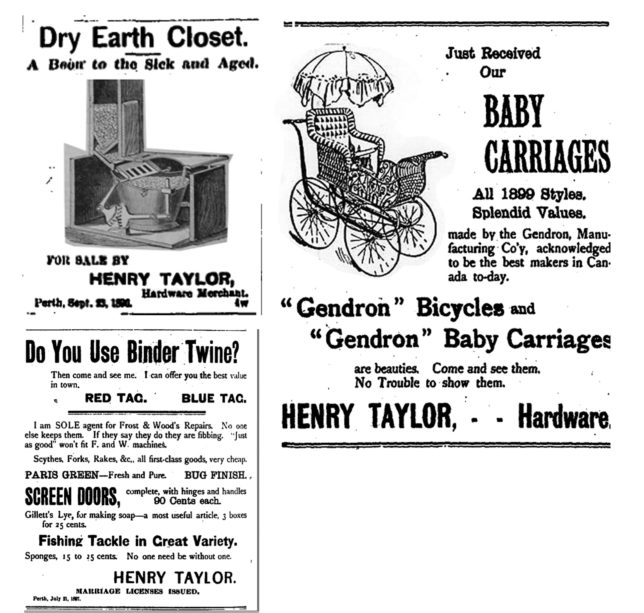
JOHN HART’S BOOK STORE
JOHN HART, for many years proprietor of Hart’s Bookstore on Gore Street in Perth. Mr. hart was a native of Glasgow, Scotland and opened a bookstore in Perth in the 1850’s. In an article in the Toronto Mail on May 14, 1887, John Hart’s Bookstore was described as “the finest bookroom in the Dominion outside of Toronto and Montreal”. Plate glass windows, admitted the light by day and at night the place was illuminated by electricity. Counters and shelves were of natural wood and the store was strikingly attractive. Mr. Hart carried the largest stock of books, stationery, wallpapers and fancy goods in Eastern Ontario. He had the only depot in town for the leading foreign and Canadian Newspapers and periodicals. He also made a specialty of artistic papers for interior decoration and of fine engravings and paintings in oil and water colours.
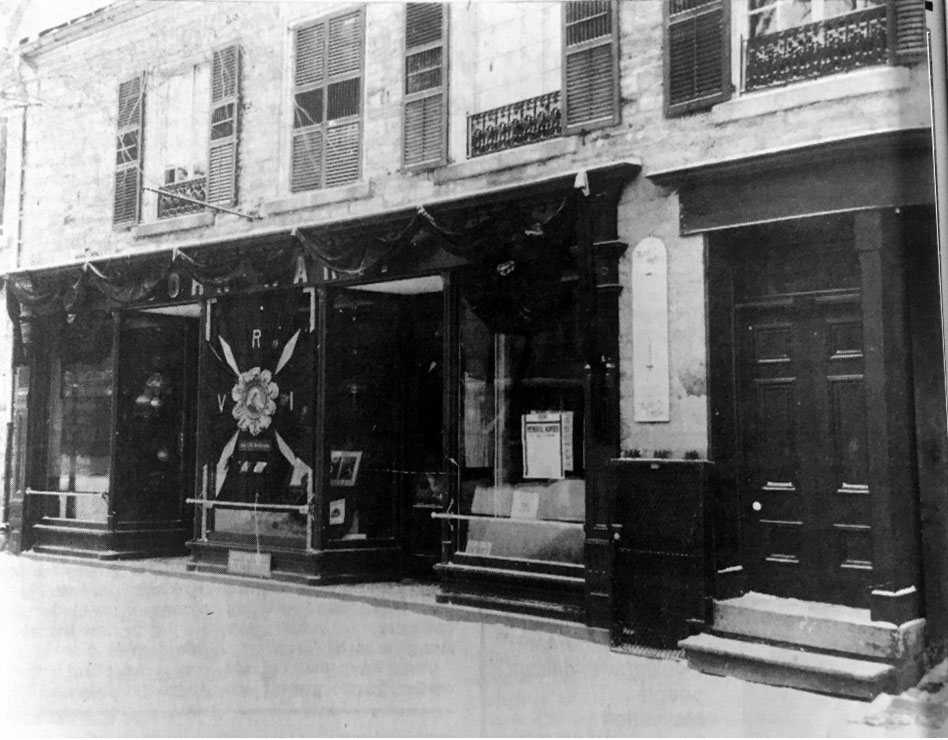
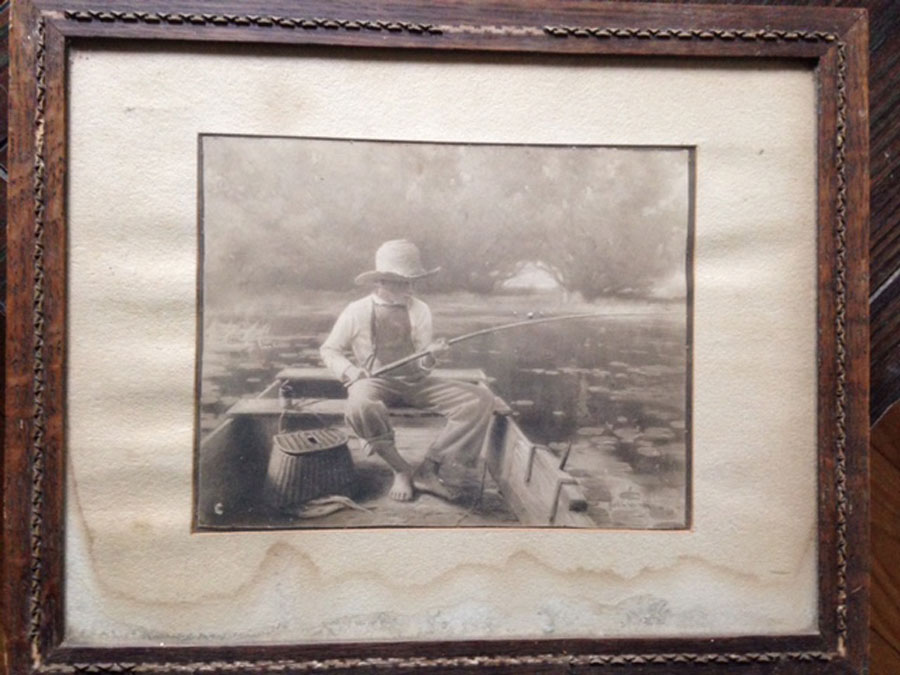
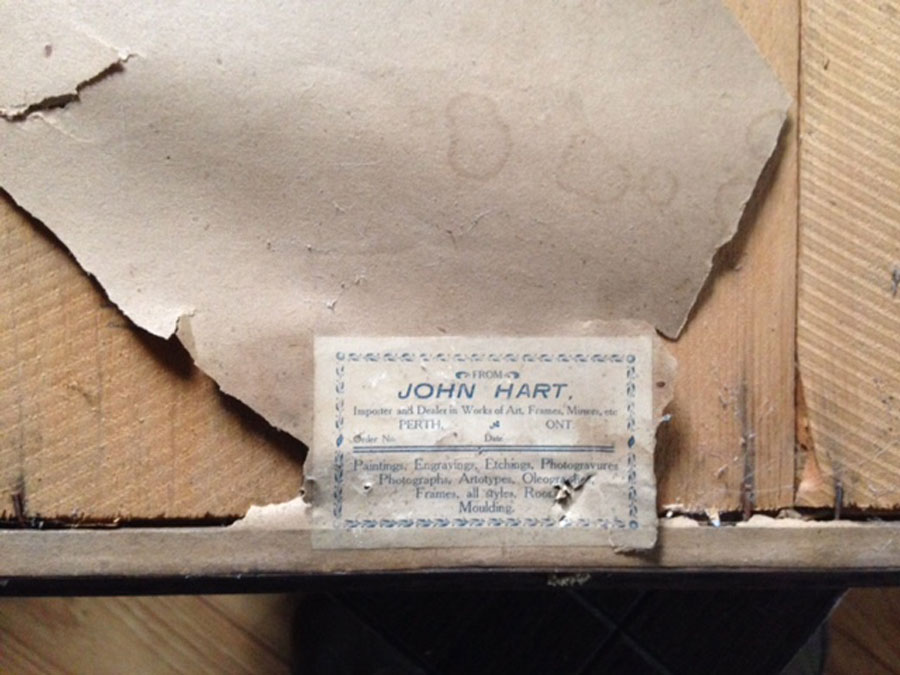
This photograph taken in 1901 at the time of Queen Victoria’s death shows the John Hart Book Store on Gore Street. Mr. Hart, a native of Glasgow, scotland, opened his establishment in the 1850’s. He did not only sell books, his retail merchandise included heavy goods, paints and oils which were stored in a two-storey building behind the shop. He also sold wallpaper and other fancy goods and fine prints. The print below is from the collection of David Bromley.
THE KELLOCK BLOCK 1848: G.E. ARMSTRONG, WALKER’S BOOK STORE, THE PERTH COURIER
In 1848, John Ellis erected this stone building for Roderick Matheson. Around 1885, James F. Kellock had the building extended and the front raised to form a third floor, with the back half left the same.
The first tenant at 39 Gore St. was, from 1848 to 1854, James Leischman, a tailor; then, from 1854 to 1876 the Ferlands operated as General Merchants. Then, until 1898 it was a tailor’s shop. In 1898 the Perth Courier moved here from down the street and still occupies the building. An assortment of tenants have occupied 41 Gore St. E. on the second floor, including a broker, Canada Customs, a tax collector; a dental office and a Beauty Shop. Above the Courier office a barrister had his office until 1920 and then from 1939 to 1953, W.W. Walker, owner of the Courier, had his residence there.
In 43 Gore St. from 1848 to 1858, Mark Billings operated a hatters and furriers shop. In 1858 A. Allen opened a drug store and in 1861 moved to the Foster Street location of the present Perth Pharmasave. Dr. John F. Kellock purchased the business and operated it from 1861 to 1880 and in 1878 he bought the building. Besides selling medicine, he was an agent for a boat line and sold houseplants. “Dr. John Kellock disposes the business to a younger brother James Kellock, a graduate of the Ontario College of Pharmacy. The store has been recently reconstructed and extended in order to keep pace with modern ideas. Mr. Kellock does an extensive jobbing business mainly in the towns and villages along the lines of Canadian Pacific and Kingston & Pembroke Railway. He makes a specialty of coal oil and imports fully two thirds of the coal oil consumed in this section. Mr. Kellock is agent for the old Hartfore (Conn) Fire Insurance Co,. and holds some of the best risks in town.” (ex May 1887 Toronto Mail).
From 1901 to 1933, W.S. Robertson took ownership of the business and from 1933 to 1971 Arthur Thornbury assumed ownership and in 1947 remodelled the store. From 1971 to 1997 R.J. Wilkinson, BSC PHM, operated the Perth Apothecary and from 1997 to 2003 it was a variety gift shop called Passiflora. It is presently the home of O’Reilly’s Pub.
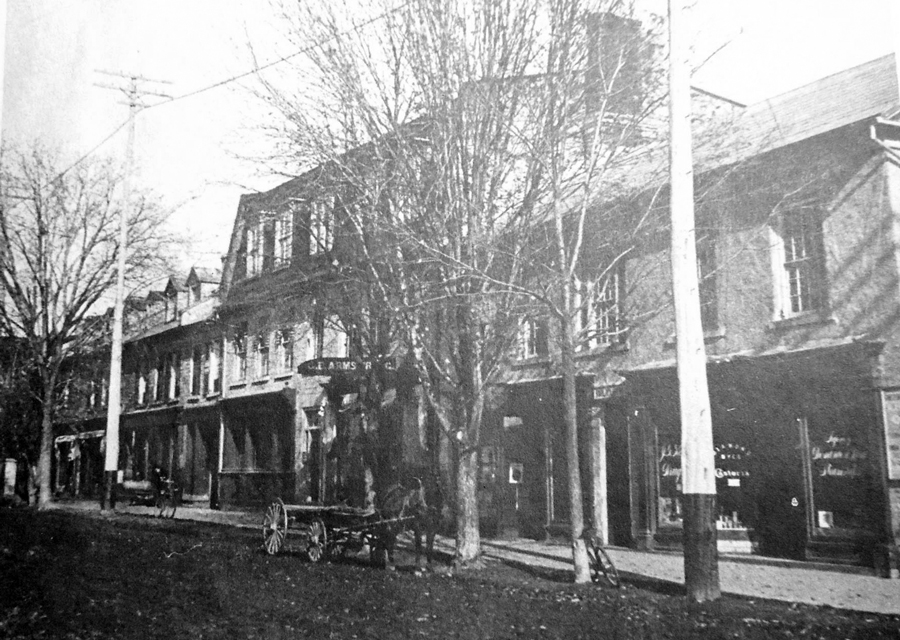
North Side of Gore Street near Herriott Street c. late 1890’s. Photo: Courtesy The Perth Museum
THE PERTH COURIER
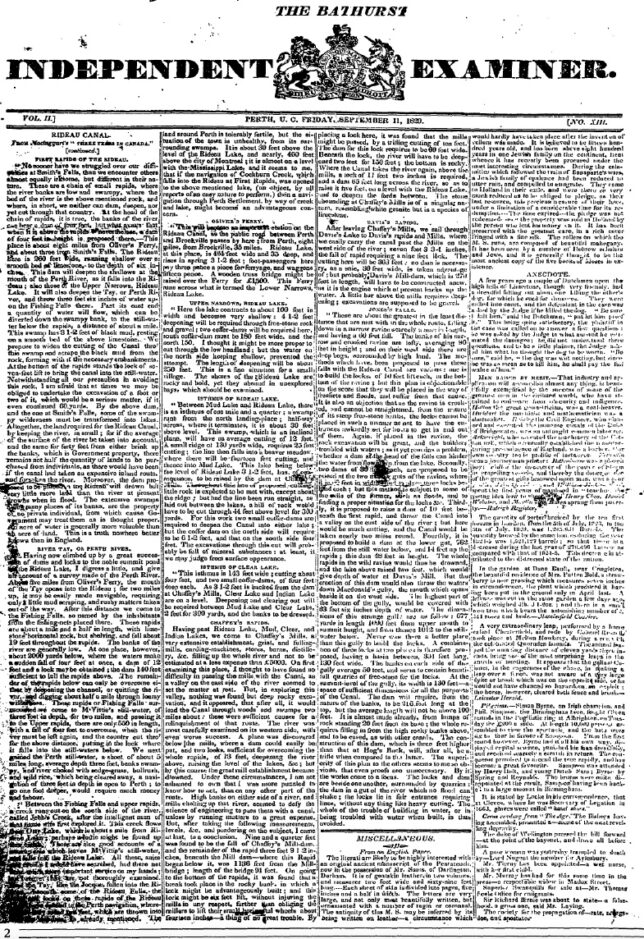
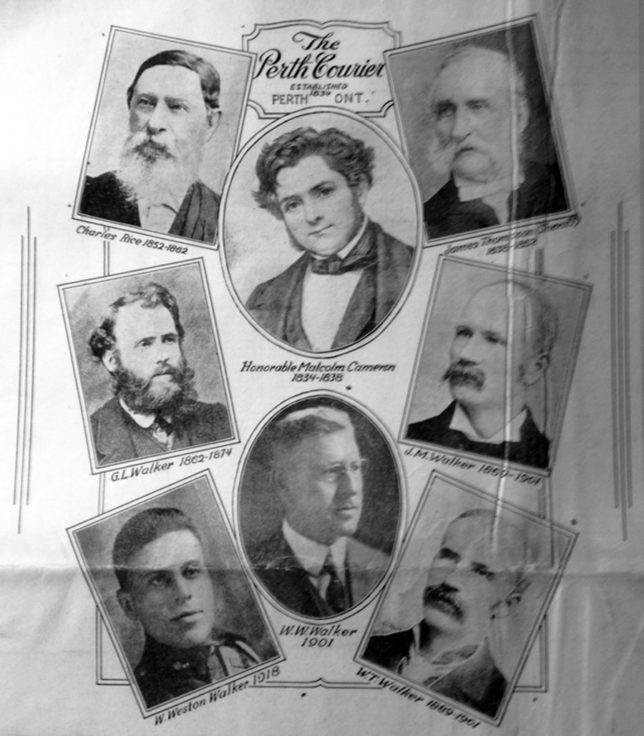
In the early days the settlement of Perth either could not support a newspaper or idin’t bother to support one. Those who could read and wanted to know what was happening throughout Canada and the rest of the world, subscribed to Brockville, Kingston and Montreal newspapers. Often these were paid for by one person and passed along throughout the community.
IN 1821 Rev. Dr. Gemmill came to Lanark with the Lanark society Settlers, bringing with him a knowledge of printing and a small printing press. but the district was to go without its own newspaper for another seven years. Gemmill operated the press on a small scale and samples of his work can now be seen in the Perth Museum.
The establishment of Perth’s first weekly newspaper came in 1828 when the teacher of the first District Grammar school, John Stewart, ordered a press from Montreal.
The press arrived in March of that year and was set up in Adamson’s Red House on Craig Street. Stewart began publishing a small 20×14 niche tabloid which he called the Perth Examiner. A year later the name was changed to the Independent Examiner
When the first Bathurst District grammar school opened in Perth in 1823, Jonas Jones, an influential lawyer and later Judge at Brockville, recommended Mr. Stewart for the job of teacher to Bishop Strachan who was to make the appointment.
Stewart used his paper as an instrument to attack certain elements in the community which he disliked, including the Rev. William Bell. He and bell argued over religious practices, eventually leading to lawsuits.
The National Library of Canada in Ottawa holds several original issues of the Independent Examiner which show that after November 13, 1829, Stewart handed the editorship of the paper over to Thomas Whatnot. The following editorial from the November 13,1829 issue outlines the course that WHatcoat intended to follow:
“Our paper will be conducted on fearless, honest John Bull principles. It shall be chiefly devoted to European intelligence and literary articles; not neglecting at the same time a synopsis of the most important and interesting matter, from whatever source it may be derived.”
While the Independent Examiner didn’t have competition form the likes of modern day radio and television to contend with there was another source of news in Perth which was often more immediate.
Anthony Wiseman, the Town Crier, was a veritable walking newspaper. Appointed High Constable in 1826 his duties included roving around the streets announcing events. At specified locations he would halt, ring the large bell he carried and when a large crowd had gathered he would make his announcements before proceeding on his way.
Despite the good intentions and the upright principles of Mr. Stewart hand his editor Are Whatnot the four page tabloid failed to prosper and sometime. before the summer of 1834 it would appear that the Independent Examiner ceased publication.
The “Bathurst Courier and Ottawa Gazette” was founded in 1834 by John Cameron, brother of Malcolm Cameron and the newspaper he was founding that August was destined to evolve into the Perth Courier.
Little is known about the founder of the Bathurst Courier and Ottawa Gazette. He was a well respected doctor, considered to be of strong character and considerable intellect. However possibly because his brother Malcom’s later achievements tended to overshadow his own little information has ever been recorded about John Cameron.
Malcolm Cameron was born in 1808 in Three Rivers Quebec but it is unclear where or when John was born. Their parents were of Scottish Highland descent and their father Angus Cameron was a member of the regular army. Their mother was Eupphenia mcGregor. in the early 1800s the family kept a tavern at McIlquhams bridge along the Mississippi River on the road to Lanark Village. Young Malcom. It is said ferried travellers cross the river since there was not bridge there at the time. Thus he earned the appellation “the bare-footed boy” which stayed with him for life.
Unfortunately John Cameron was never able to prove his ability as a newspaper publisher editor. In the autumn of 1834 just a few months after he began the Bathurst Courier and Ottawa aGazette he contracted scarlet fever and died. The Drummond Street printing establishment was then turned over to the hands of Malcolm who was later to admit his inexperience at the trade.
Malcolm Cameron was busy angling for political nomination at the time his partners paper fell under his control and it would appear that Malcolm did not share his brothers interest in running such an establishment. Thus he hired James Thompson a young man of 22 as journeyman, foreman and editor.
Malcolm Cameron was only 27 years old a t the time he sold the paper to Thompson and the next year was elected to the Legislative Assembly of Upper Canada as a Reform member for the District of Bathurst which included the counties of Lanark and Renfrew.
Thompson had come to Canada from Ireland at the age of seven and learned the printing trade in Montreal. He it would appear had the keen interest in the newspaper business which Malcom Cameron admittedly lacked so it is not surprising then that exactly one year after the Bathurst Courier and Ottawa Gazette was founded, Malcolm sold the business to the young James Thompson.
Under the guidance of Thompsons sure hand the Courier began to prosper. The Cameron brothers had provided the impetus that founded the paper but it was the young printer from Montreal who toiled for years to ensure that the Courier earned a permanent home in the district.
Mr. Thompson, in turn was succeeded by his printer, Charles Rice, who controlled the paper until 1862, when he sold it to the George L. Walker. Following Mr. G. L. Walker’s sudden death in 1874, the paper was taken over by James M. Walker. After he became editor, his brother, William T. Walker, came in as partner, the firm name being “Walker Brothers” which was continued for over 60 years. In 1901, following the death of Mr. W. T. Walker, J. M. Walker retired and the ownership passed to Walter W. Walker who became president of The Perth Courier Publishing Company Limited. In January 1936 the Courier bought the Perth Expositor which was incorporated with the Courier.
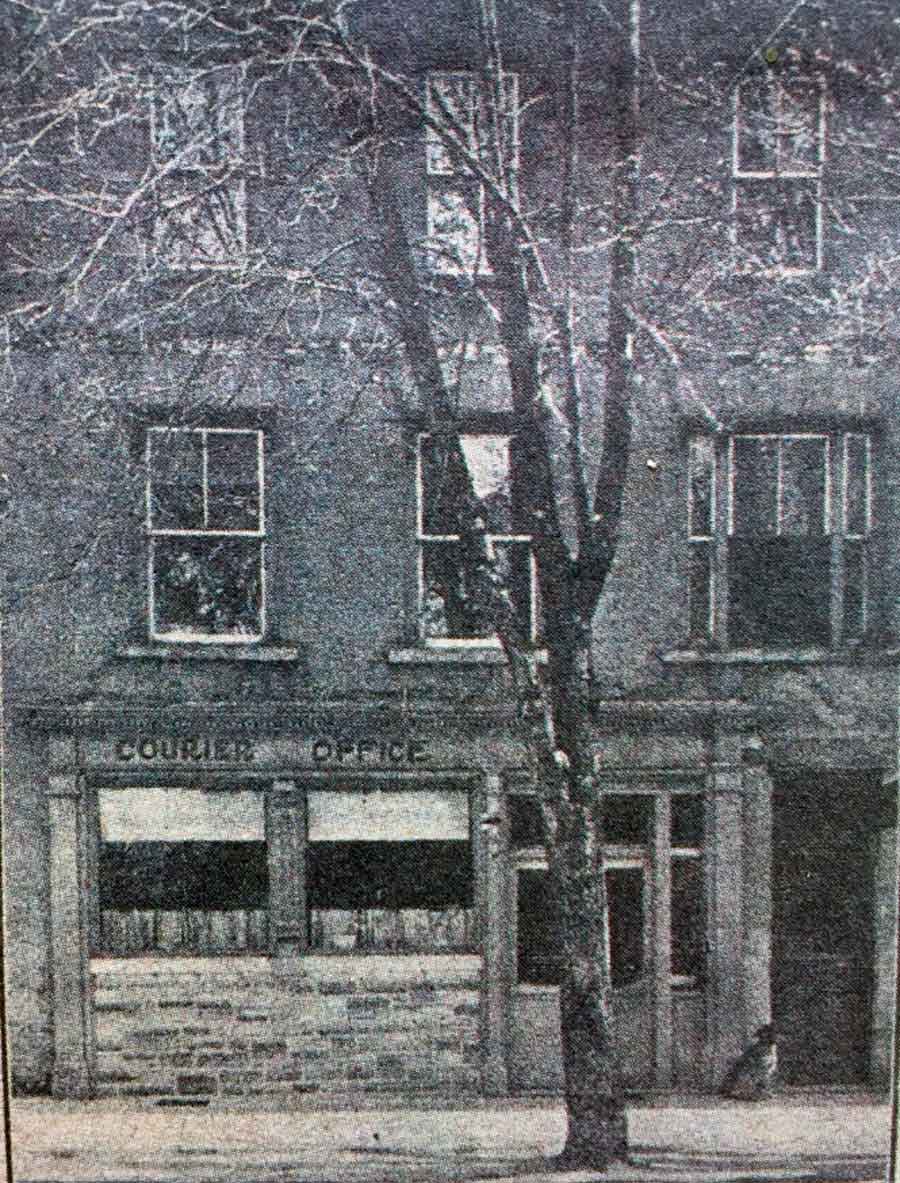
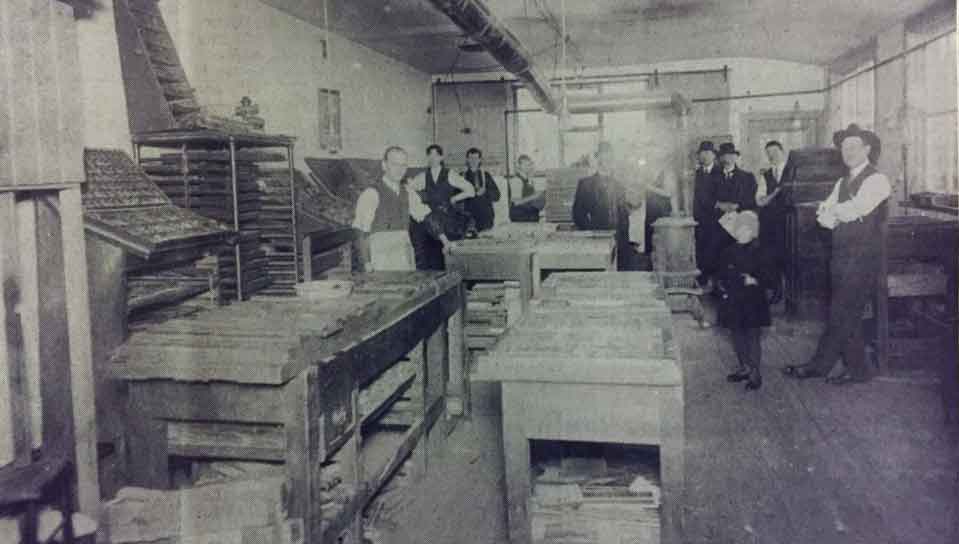
Perth Courier Print Shop c.1904. Pictured, from left are: Norman Dickson (editor), Vince Lally, Alphonsus Thompson, Arthur McDowell, Dr. Spragg, Riley McGuiggan, Hack Hartney (behind Riley), George Wilson, Dr. R.V. Fowler, Alf Brown, W.W. Walker (owner) and Norman Dickson Jr.
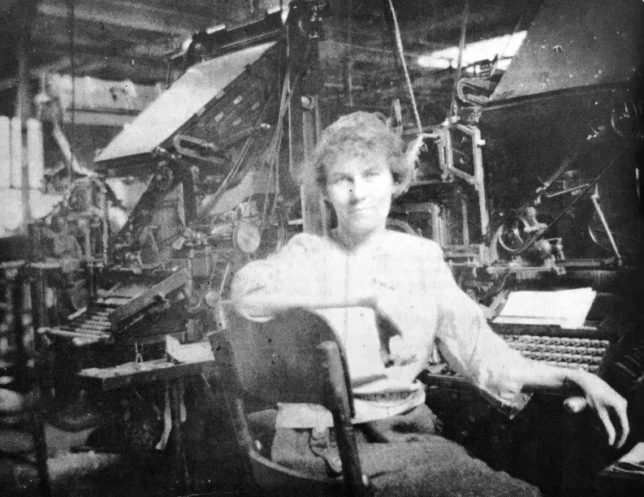
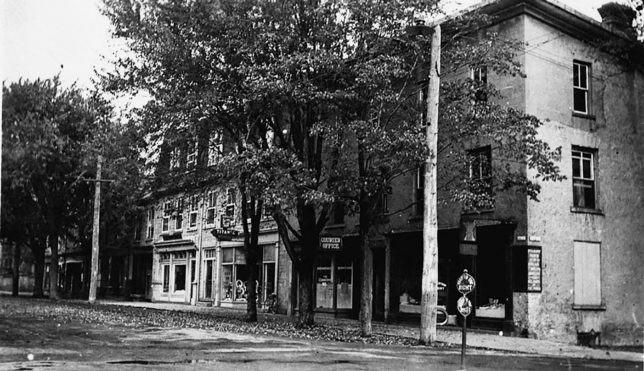
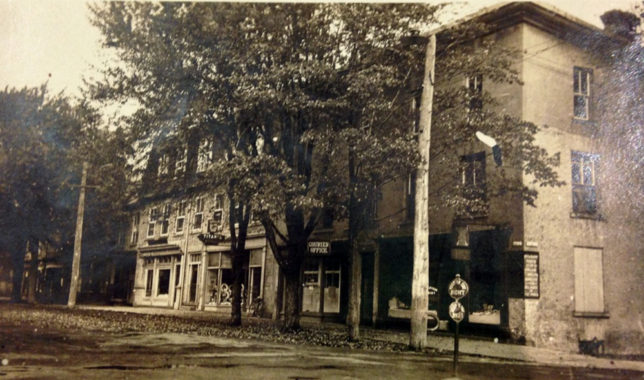


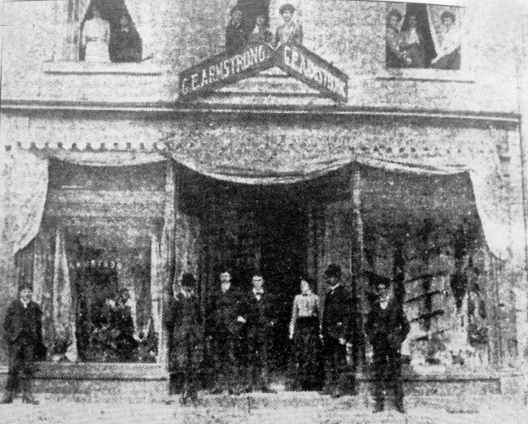
G. E. Armstrong
C.P.R TELEGRAPH OFFICE on the Little Tay
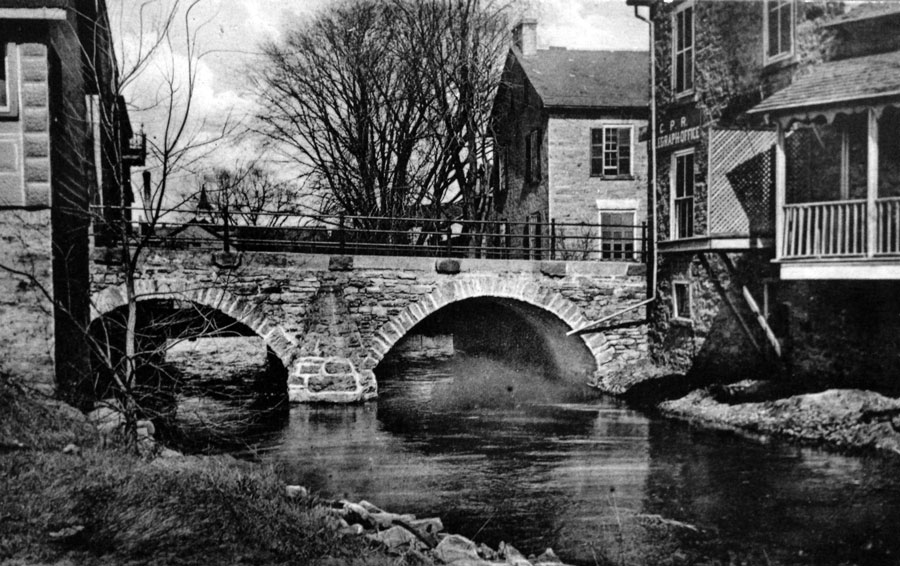
C.P.R Telegraph Office on the right, building across from the Sheriffs House early 1900’s.
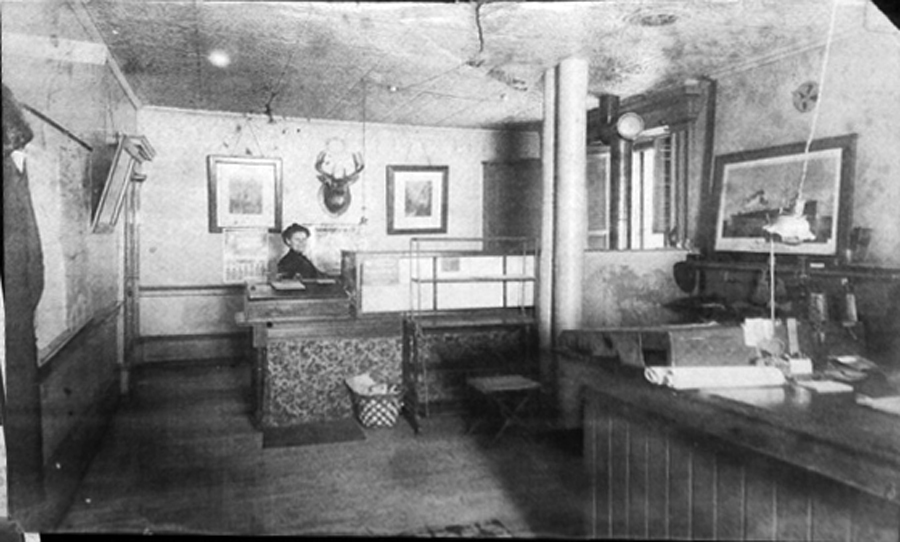
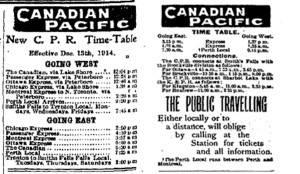
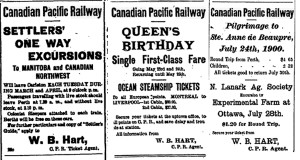
Perth Telegraph Office 1911. Photos courtesy Perth Museum.
Clock from the Telegraph Office. On the face of the clock is Rudd and Neilson Jewelry store. This store was located on Foster Street, Perth.
VANITY FAIR TEA ROOM in the Matheson House
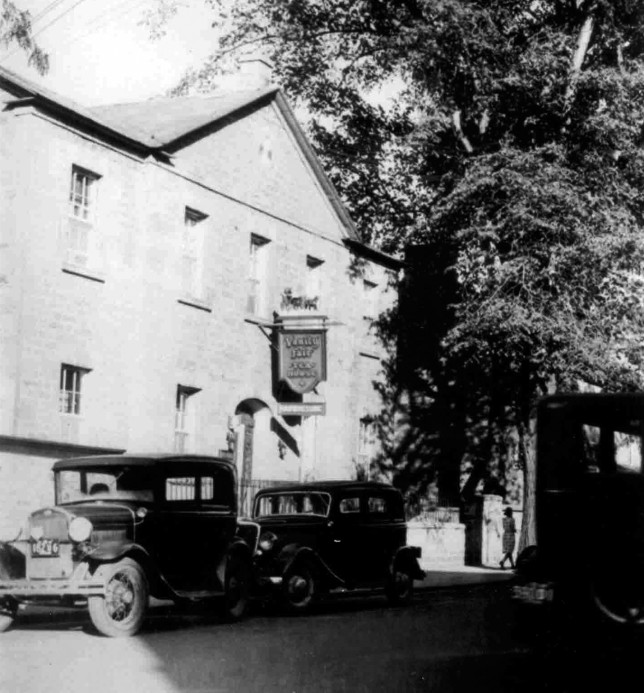
The Brickacre Tea Room was also located here before this building was home the the Perth Legion and then the Perth Museum. Photo: Courtesy The Perth Museum.
THE PERTH COURIER, 1938. “The Vanity Fair Tea House is the name under which the former Matheson home, now the property of Mr. J.C. Carr will open to the public about the middle of June. The name will call to mind Thackeray’s novel, “Vanity Fair”. It was seven years before the great Thackeray wrote his English novel that here in Canada in the town of Perth, Senator Matheson’s home on Gore Street was built. History, romance, tradition! They are an integral part of a home that has stood solid and unchanging through almost a century of self movement and rapid innovation. We would change it but little for it is something mellow and rare and lovely in this hurried age”.
SHEEP HERDING ON GORE STREET 1893
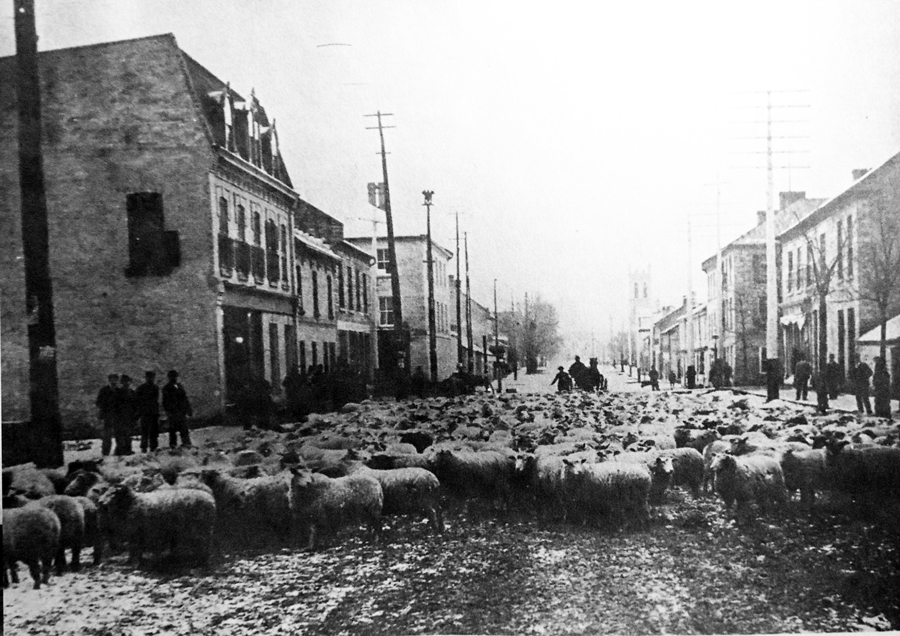
Looking North on Gore Street before 1915. In the far distance the spire of The United Church. To the right corner of Foster and Gore Hicks House (Hotel Perth) and Shaws. To the left at foster Warren and McCarthy Hardware and Meighan Brothers. The open lot to the left would soon be home to The Balderson Theatre. Buildings at that location on the empt lot were destroyed by fire years before. Photo courtesy The Perth Museum.
NORTH SIDE OF FOSTER STREET AT WILSON STREET – HICKS BUILDING


James Hicks general merchant 1875, F&F Henderson 1905-1912 then Thomas Spence Gents Furnishings to 1928on the corner of Wilson and Foster Street.Mr. J. T. Henderson came to perth in 1861, and established the mercantile house which has been eminently prosperous since its inception. The Toronto Mail, May 14, 1887. Mr. Henderson’s business premises at the corner of Wilson and Peter street subsequently were occupied in 1895-1905 by Charles & James. The ground floor was occupied by dry goods which included dress goods, silks, satins, velvet, ladies furnishing goods, prints, muslims, etc. In a separate room groceries, provision, crockery, etc. Upstairs departments devoted to carpets, lace, curtains, window blinds, boy’s clothing and millinery. In 1905 the store was taken over by J. H. Mendels. In 1928 Mackie Brothers of Kingston bought the block to use for an automobile agency. In 1938 J A Perkins purchases the business and opened a garage and GM dealership. IN 1946 the old buildings were demolished to make way for a new 2 storey Art Deco Style of building to house Perkins Motors and in 1947 a new bowling alley. In 1949 the Ontario Provincial Police had offices at this time until 1965 when they moved to Victoria Street.
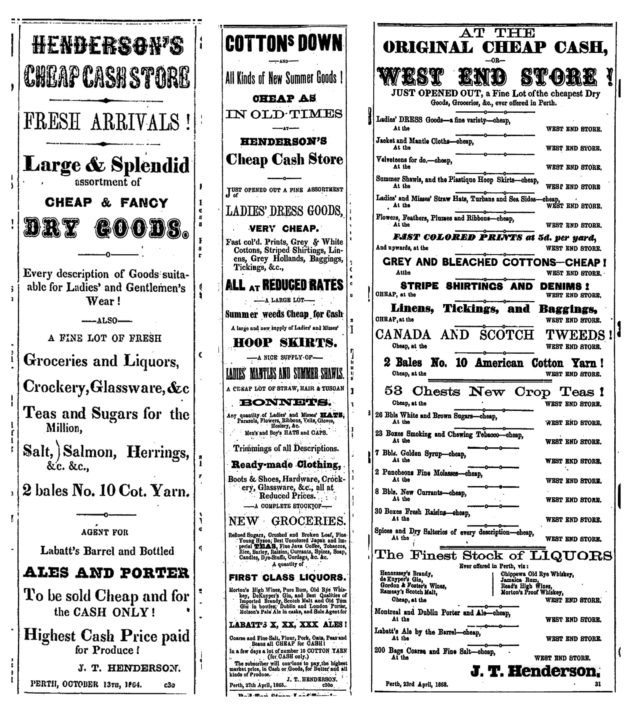
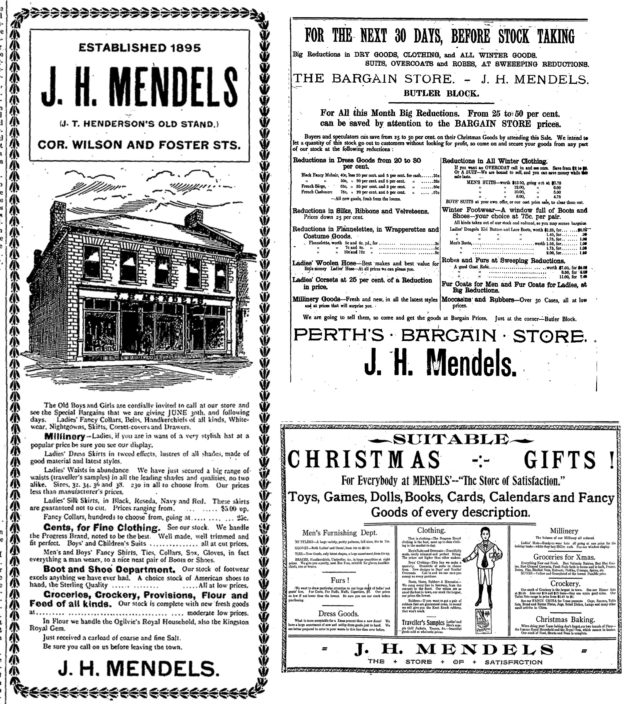
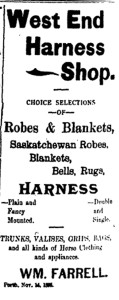
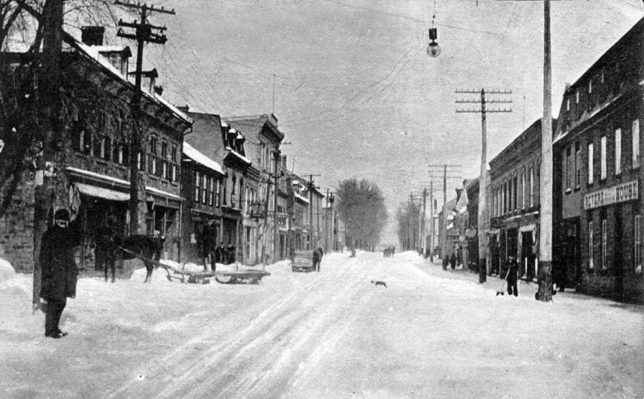
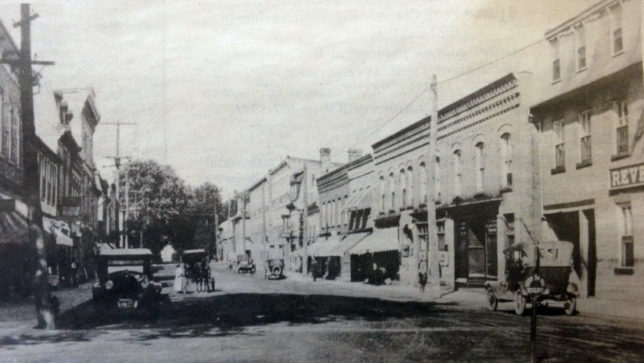
Foster Street winter view from Wilson Street.Revere House to the right Photo: Courtesy The Perth Museum
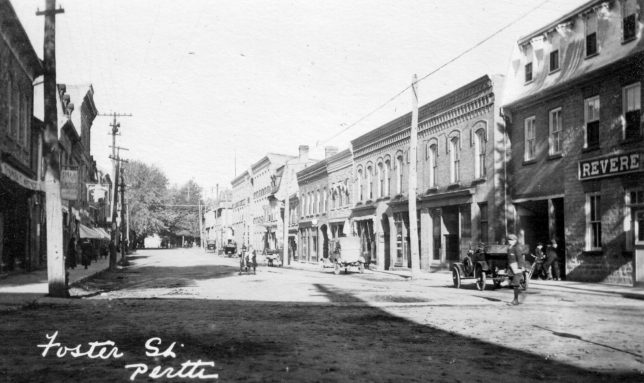
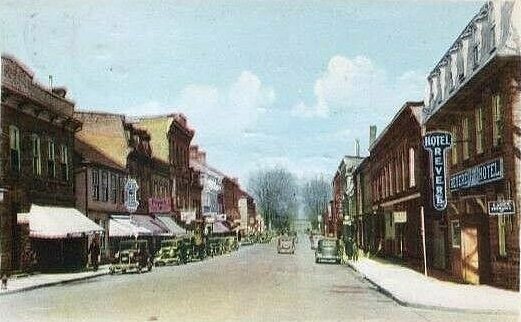
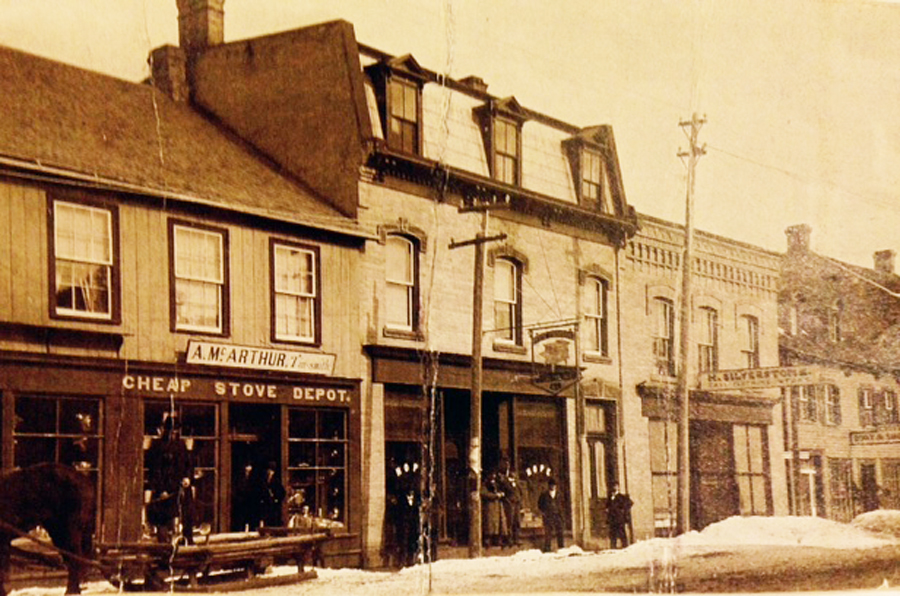
The Hope Block c.1880
William and Peter Hope started in the tinsmith business in 1871 in a small shop on North Street and as business improved, realizing the need for a better location they had this fine two-storey brick building erected in 1889 with living quarters on the second and third floors. This two-storey white brick building is covered in white siding and has a mansard roof. The mansard roof is covered in tin and there are three dormers in it. Each is a pediment gable with a square headed window. Each window has two sashes with two panes in each. The roof eave is ab racketed overhang. There are three windows on the second floor. Each window is segmentally headed with a keystone and a cut stone surround head and stone lugsill and each window has two sashes. They continued on in business here until 1938. They sold stoves and ranges and manufactured all types of tin and copper ware and stovepipes. They also handled hardware, household goods, farm and garden tools and all types of cheese factory supplies as they had interests in three cheese factories. After the business closed the building had a wide variety of occupants. From 1938 to ’41 R. A. Pope a former merchant in Lanark had a grocery store. From 1941 to ’45 T. Postelnick sold dry goods etc, and then from 1945 to ’48 W. G. Sawdon and Russ Ellis opened an appliance store. From 1948 to ’50 the Co-Op food store occupied the premises. Then from 1950 to ’55 Jack and Jill Reg’d had a children’s clothing shop. From 1955 to ’63 W. G. Sawdon and Russ Ellis moved back in from across the street with their appliances and from 1963 to ’70 Russ Ellis continued thee business on his own and in 1970 moved to a location on Gore Street. From 1970 to ’74 the store was partitioned in two with Sinclair Florists and the Tot Shop being occupants. In 1973 the partition was removed to restore the original store and from 1975 to ’84 it was Rolly’s Restaurant. From 1984 to ’91 with a change of owners it was Tinkers Restaurant. With new owners in 1991 it was changed to The Crown & Thistle Pub and currently in 2022 it is now The Golden Arrow.
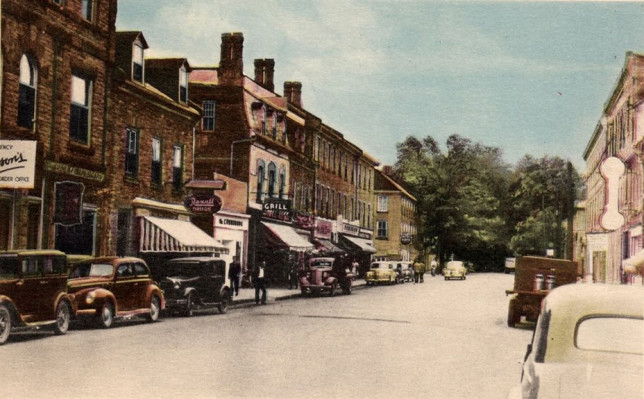
The Commodore Grill sign can be seen in the middle on the left. Harold Ferguson and Joseph Beatty proprietors. Girdwoods Rexall Pharmacy in the middle.
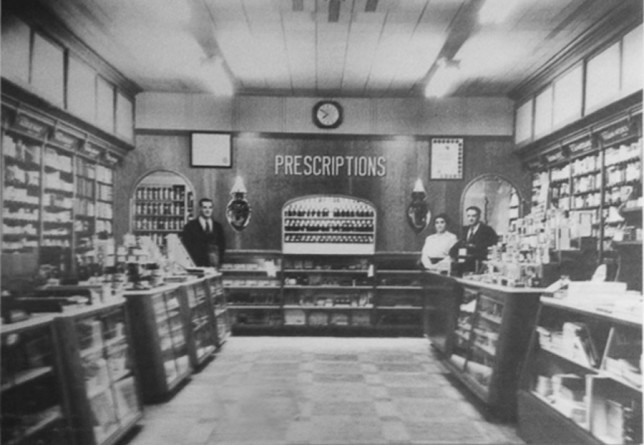
Inside Gqirdwood’s Rexall Pharmacy on Foster Street. Photo: Perth Courier
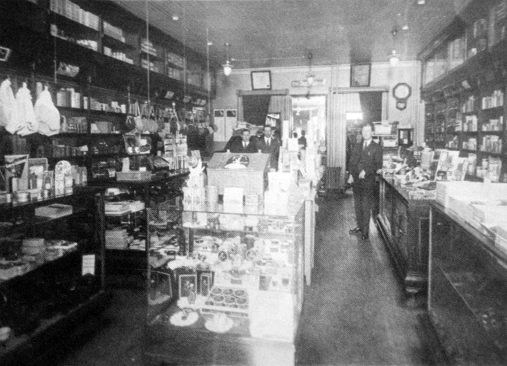
Fred Girdwood, 1923
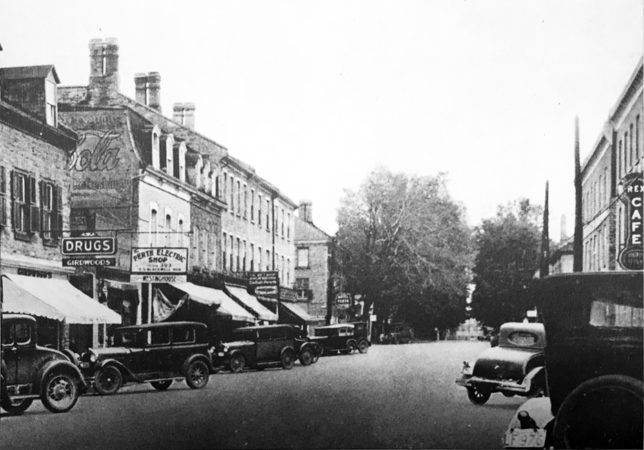
J. T. HENDERSONS, QUEEN’S HOTEL, PALM GARDENS & POOL ROOM and A. T. McARTHUR HARDWARE.
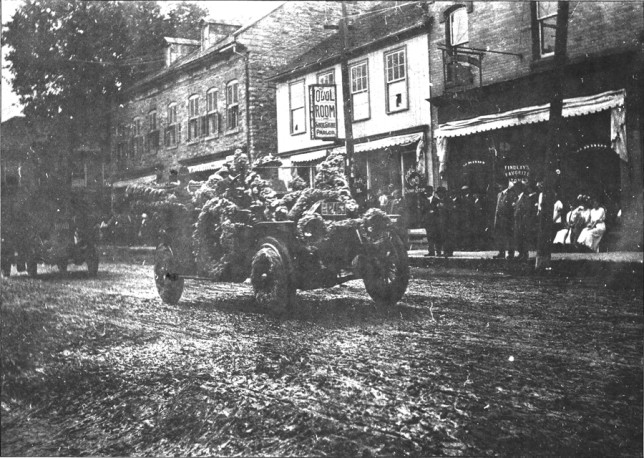
Millie McLaren in her McLaughlan Buick on Foster Street at the corner of Wilson Street c.1922
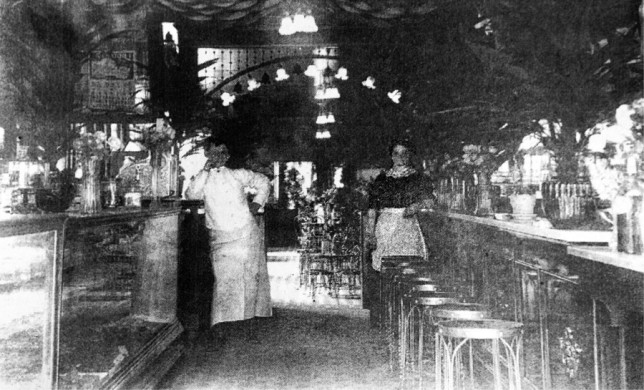
Photo 1914: Mr. Kanelakos on the left and Annie Malloy on the right.
The Palm Gardens opened in 1905.
“In 1913 with commendable enterprise, Kanelakos Brothers have refitted their store on Foster Street and changed it into an up-to-date ice cream parlor. Joe has an eye for the beautiful at all times and the beautiful is much in evidence in the transformation that has taken place. He has well named his store the Palm Gardens, where things are cool and clean, An up-to-date soda fountain has been installed. Ice cream sodas and fresh fruits will be featured at this store now, with of course, cigars and tobaccos.”The Palm Gardens had wrough iron chairs and tables, huge palm tees and lots of lace curtains. It also had tulip shaped chandelier lights hanging from the ceiling and also ceiling fans. There was no mechanical refrigeration Treats such as a David Harum Sundae could be purchasesd for 15 cents. NOTE: David Harum Sundae (vanilla ice cream, crushed strawberry, crushed pineapple, whipped cream, and cherry) which I learned came from a best selling novel David Harum; A Story of American Life 1899. In 1918 they opened a Tea Room on the location serving soups, pie, sandwiches and all kinds of soft drinks as well as home made ice cream and candies during this time. Ice cream was kept in round steel pots immersed in a brine solution made from chopped ice and rock salt kept either in a large wooden pail or containers designed for this purpose. In the late 1920’s mechanical refrigeration was introduced. Kanelakos Brothers also had a smoke shop and a billiards room on the second floor. Some of the goodies in 1930: pecan cream roll 50¢ lb., Brazil cream roll 60¢ lb. cream fudge 50¢ lb.In 1935 Chris Moskos purchased the business from Malloy & Williams and changes the name to the Perth Tea Room and operates an ice cream parlor and restaurant. He also manufactures a variety of home-made candy. In 1937 Moskos put in machinery to make his own ice cream which he sold in bulk and packages. In 1948 he moved to a new location on Gore Street to open the Perth Tea Room (The Perth Restaurant location) and Candyland.
The Palm Gardens had wrough iron chairs and tables, huge palm tees and lots of lace curtains. It also had tulip shaped chandelier lights hanging from the ceiling and also ceiling fans. There was no mechanical refrigeration Treats such as a David Harum Sundae could be purchasesd for 15 cents. NOTE: David Harum Sundae (vanilla ice cream, crushed strawberry, crushed pineapple, whipped cream, and cherry) which I learned came from a best selling novel David Harum; A Story of American Life 1899. In 1918 they opened a Tea Room on the location serving soups, pie, sandwiches and all kinds of soft drinks as well as home made ice cream and candies during this time. Ice cream was kept in round steel pots immersed in a brine solution made from chopped ice and rock salt kept either in a large wooden pail or containers designed for this purpose. In the late 1920’s mechanical refrigeration was introduced. Kanelakos Brothers also had a smoke shop and a billiards room on the second floor. Some of the goodies in 1930: pecan cream roll 50¢ lb., Brazil cream roll 60¢ lb. cream fudge 50¢ lb.In 1935 Chris Moskos purchased the business from Malloy & Williams and changes the name to the Perth Tea Room and operates an ice cream parlor and restaurant. He also manufactures a variety of home-made candy. In 1937 Moskos put in machinery to make his own ice cream which he sold in bulk and packages. In 1948 he moved to a new location on Gore Street to open the Perth Tea Room (The Perth Restaurant location) and Candyland.
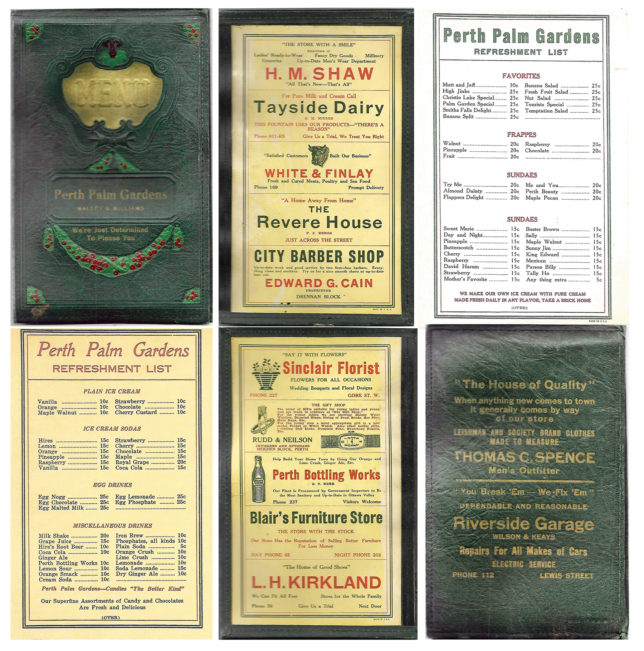
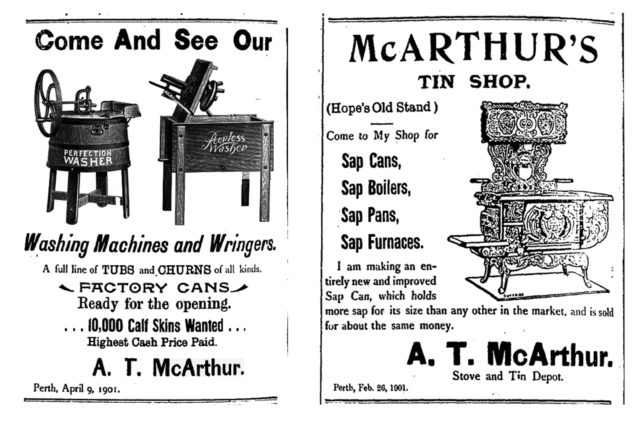
COCKBURN ISLAND, LOOKING NORTH ON GORE STREET – MARKET SQUARE
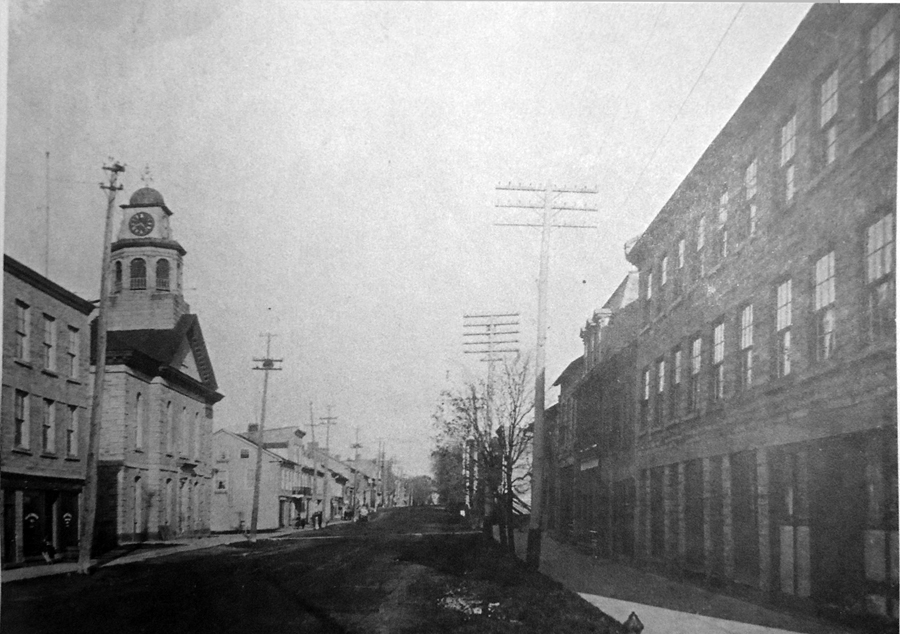
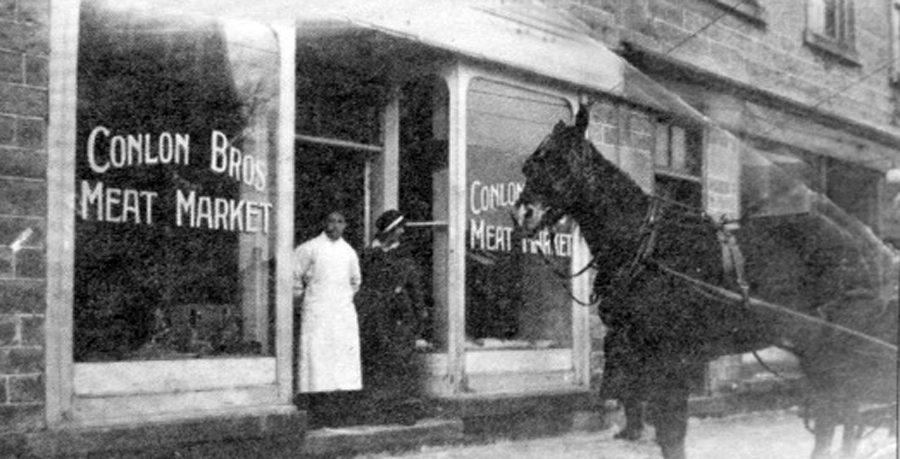
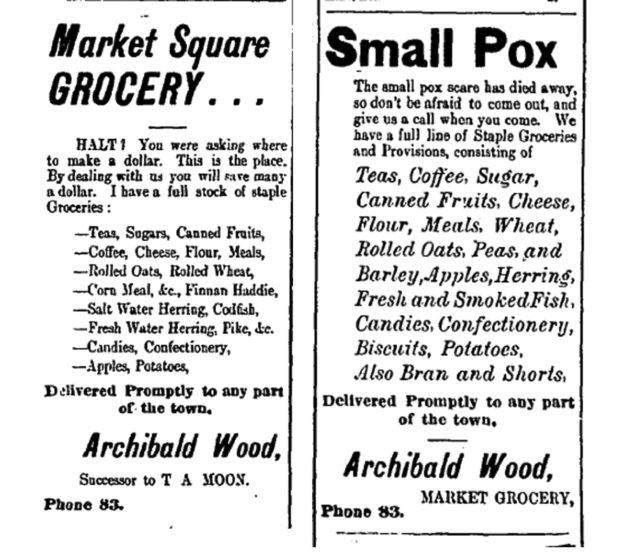
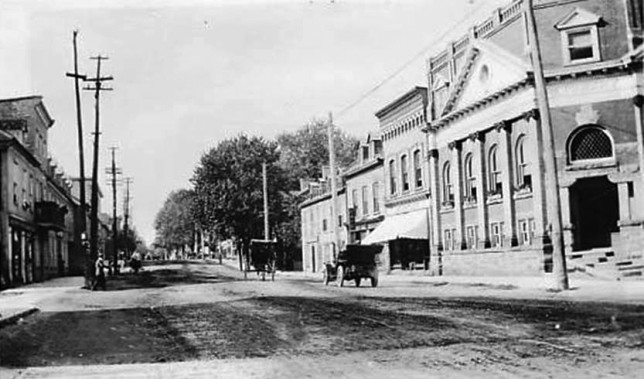
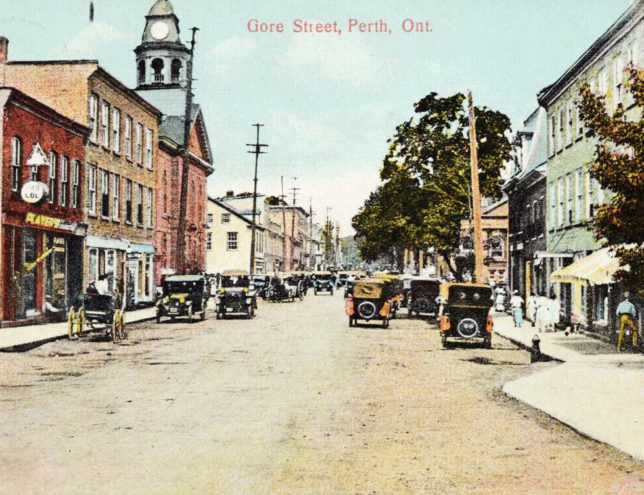
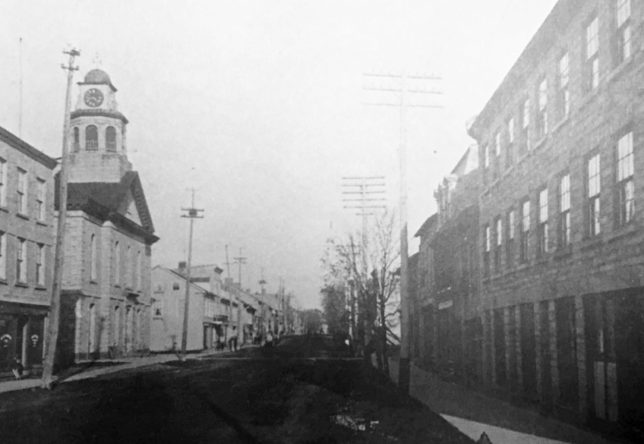
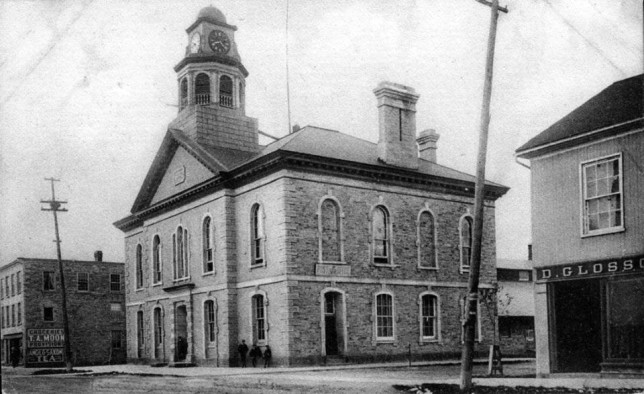
Perth Library with W. G. Butler (late 1890-early 1900’s) beside (with awning). H.B. Wright & Son (early 1900’s) and Conlon’s Grocer at this location later. Beside this store was Harry’s Cafe 1913. Across the street was the Allen House later the Cecil Hotel.
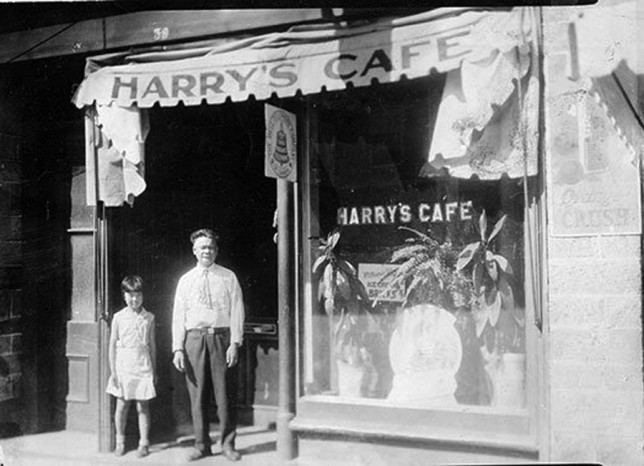
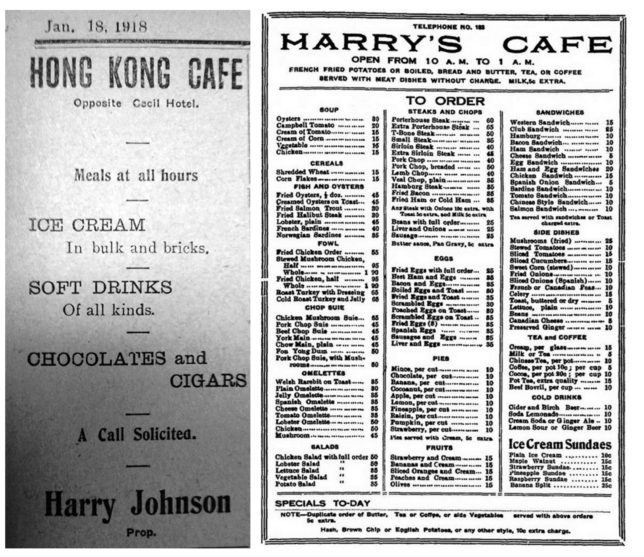
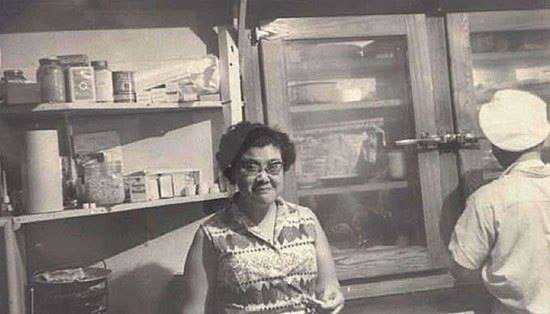
Doris Fong-Johnston and her father, Harry c.late 1920’s. © 2012 Ottawa Chinese Community Service Centre and Denise ChongHARRY’S CAFÉ : Harry Fong came to Canada in the 1890’s and settled in Perth in 1899. The Fongs were given the surname Johnston by the Knox Presbyterian Church. Harry opened the Hong Kong Cafe that later became Harry’s Café at 59 Gore Street c. 1913. Harry’s advertised in 1923: Try Harry’s Café across from the former Cecil Hotel – for a good hot meal – 25¢ and up. Meals at all hours. In 1932 after many improvements he already made both inside and out, Harry installed an electric sign on the front of the premises and when illuminated at night the sign showed the words Harry’s Café in bright red lights. Harry died in 1940 and his wife Mabel ran the café with her daughter Doris helping out. Mabel died in 1966 and Doris took over the café with her husband Howard Soong. Harry’s Café closed in the late 1980’s
Harry died in 1940 and his wife Mabel ran the café with her daughter Doris helping out. Mabel died in 1966 and Doris took over the café with her husband Howard Soong. Harry’s Café closed in the late 1980’s
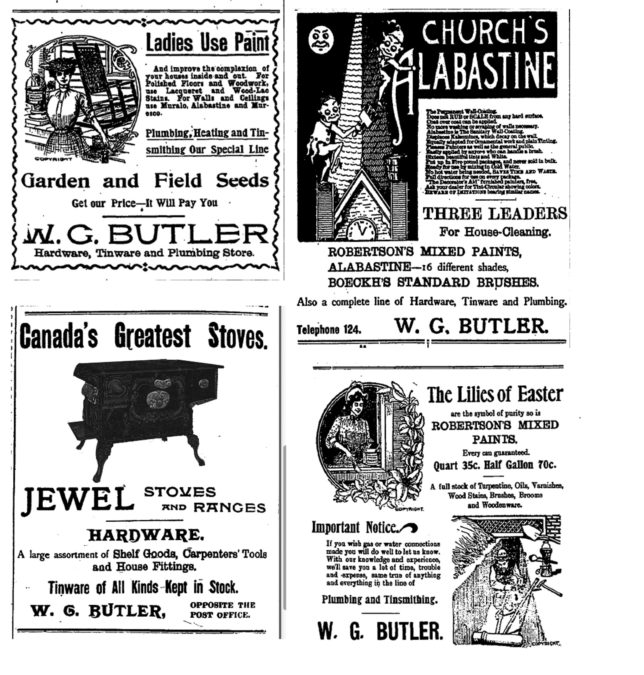
THE ALLAN HOUSE
Largest hotel in Perth, was a fifty room spread called the Allan House, situated to the west of the town hall in a block. Andrew Robinson the proprietor, was famous for his “uniform courtesy and kindness” and the free bus rides to the train and stages. Mr. Robinson purchased the Allan House from I.C. Grant after ten years as an employee of the Hicks House.
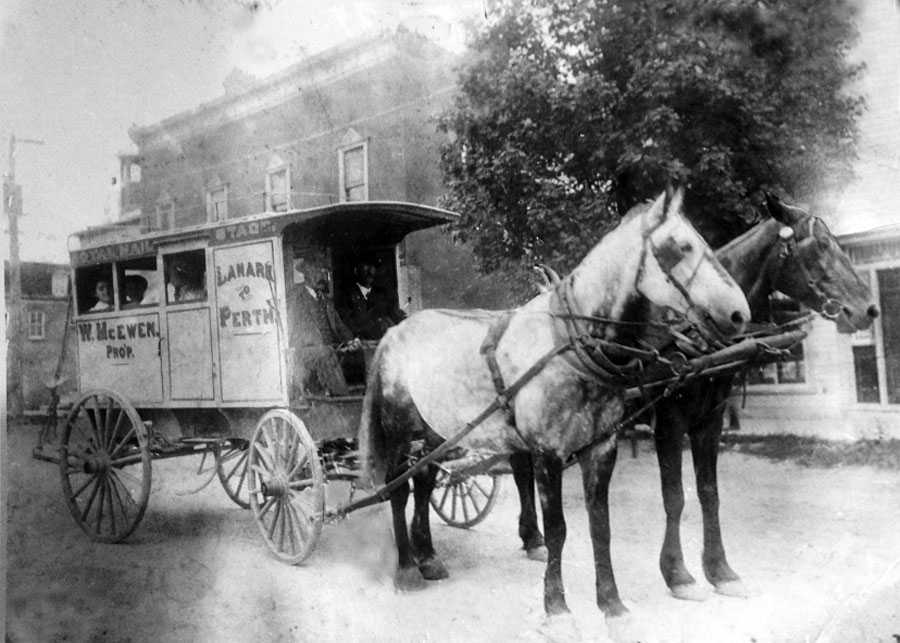
William McEwan’s horse drawn bus. Departing from the Allan House Hotel on Gore Street in Perth every day except Sunday. 35 cents to go to Balderson and 65 cents all the way to Lanark. Photo: c.1900, Middlevile Museum.
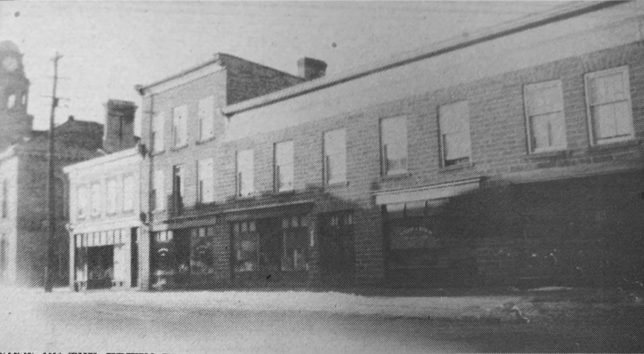
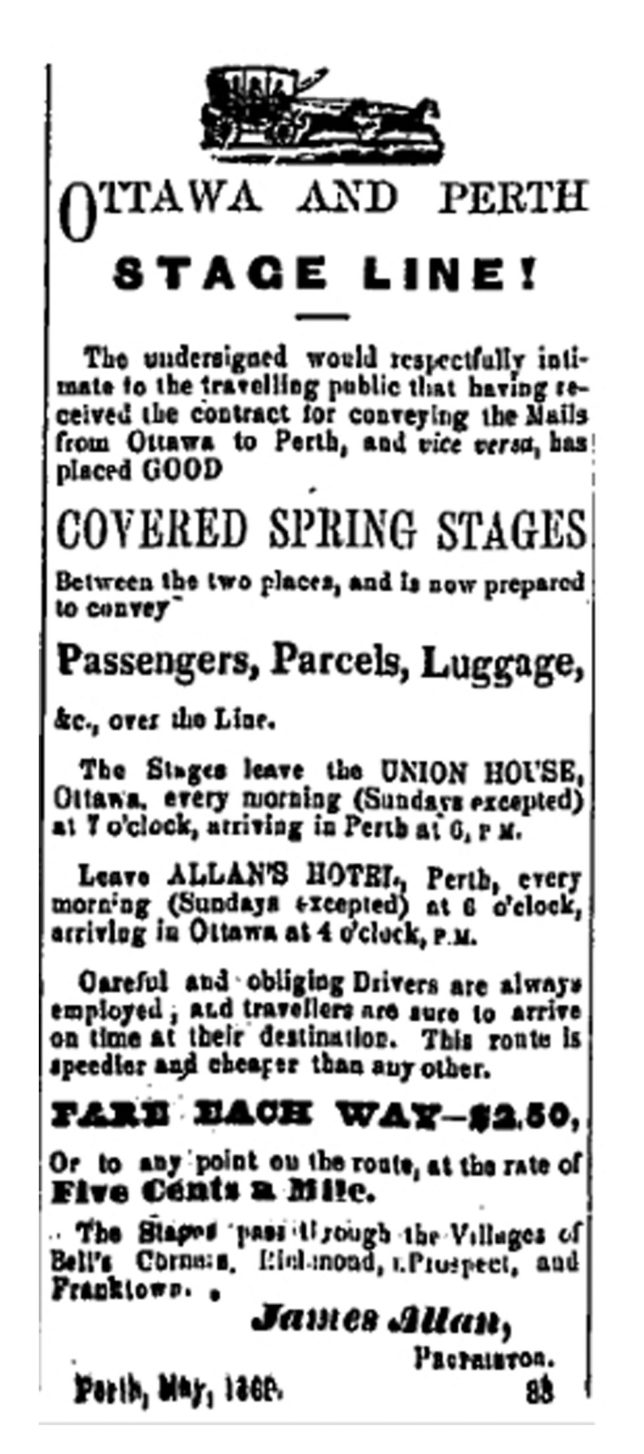
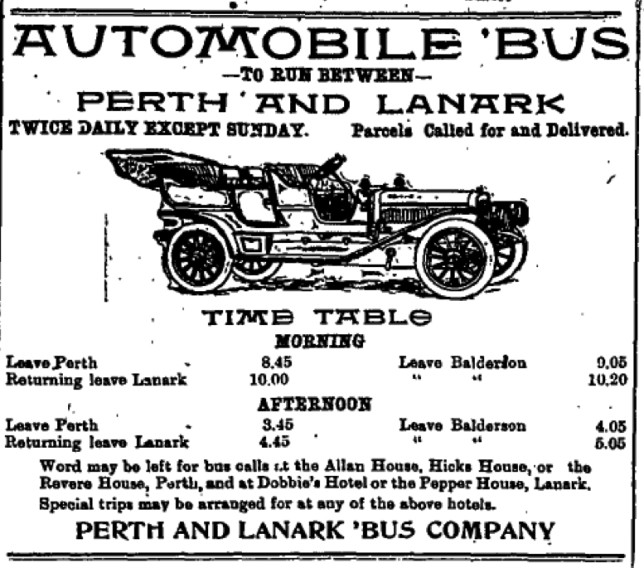
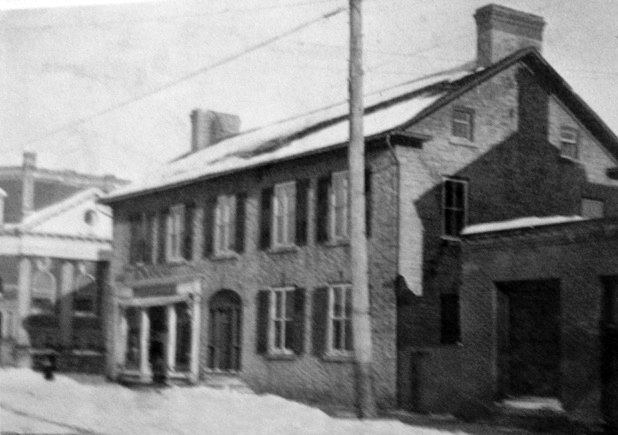
Building situated where the former Post Office Building now stands across from the Perth Town Hall. To the right was the Starland Theatre and Maloney’s Music Store. A nickel got you in and on Fridays they gave prizes to lucky number holders. Photo courtesy The Perth Museum.
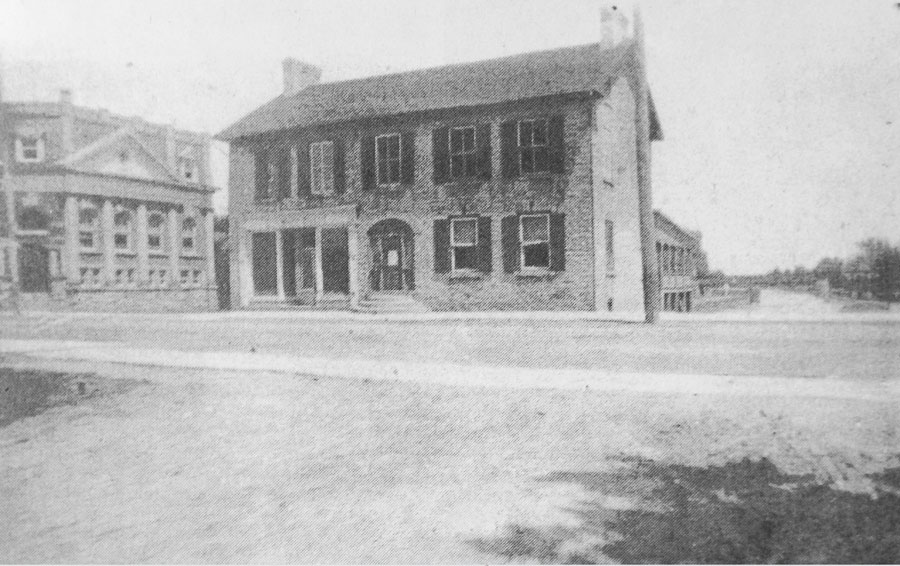
The Starland Theatre that was situated to the right of this building was demolished and the stone carted up Gore Street to be used in the new construction of the Balderson Theatre c.1915
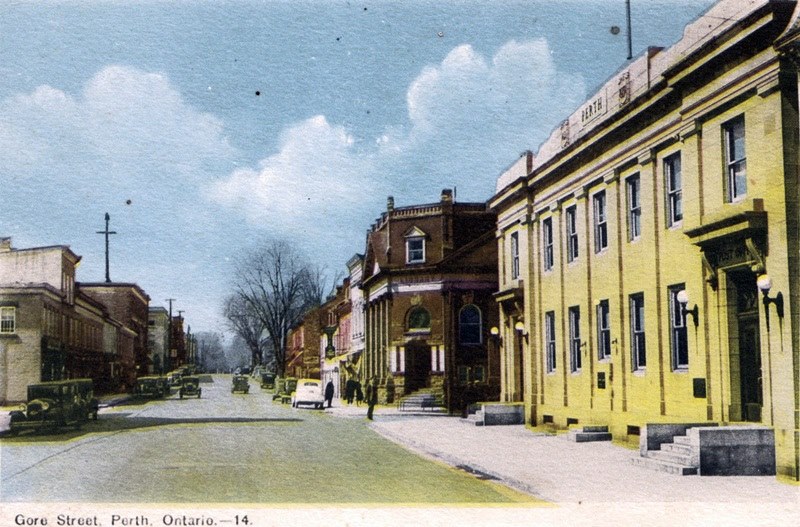
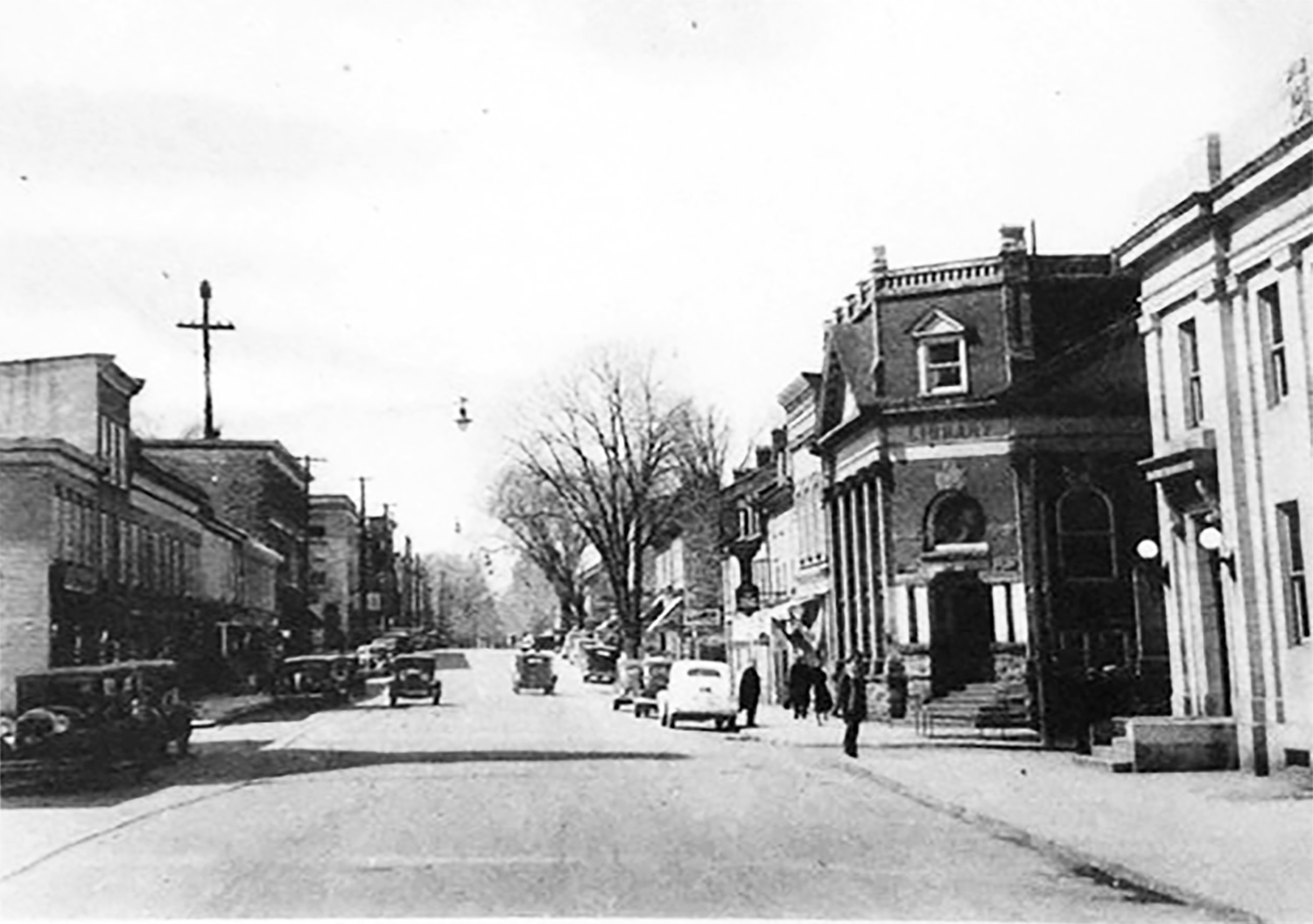
BROOKES BLOCK 1846
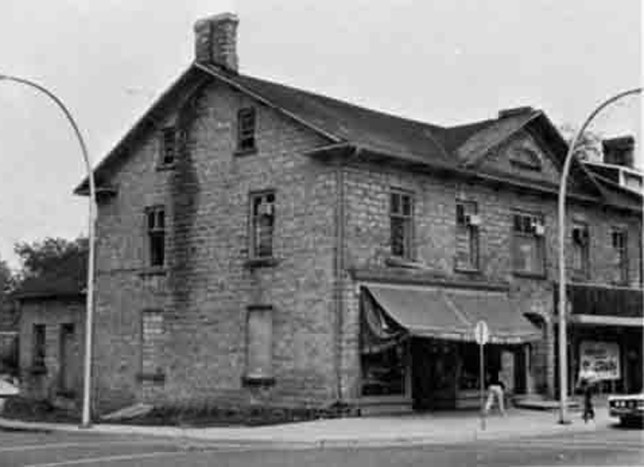
Photo: Parks Canada
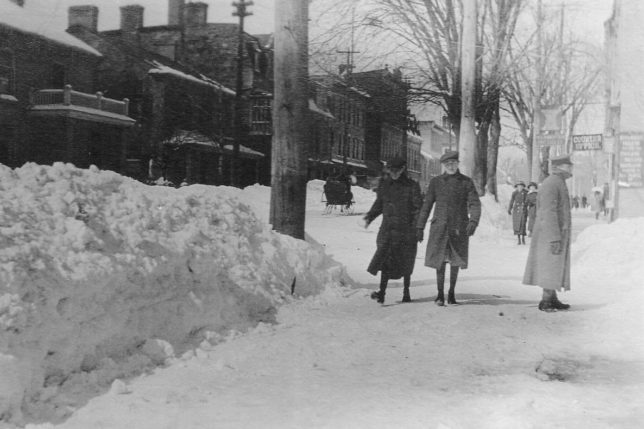
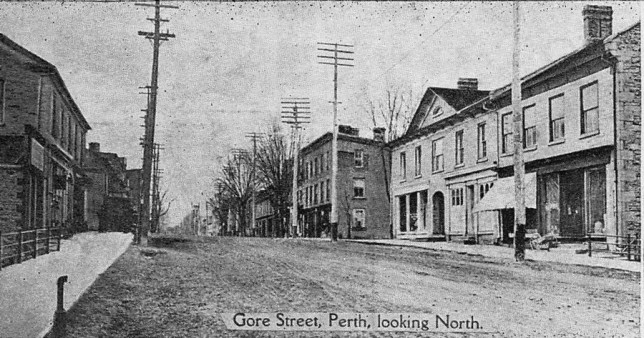
51-55 Gore Street
The Brooke Block was built 1846 by Thomas Brooke, who came to Perth in 1818 f from Halifax.
As a wealthy merchant, he built 45-49 Gore St. E. and 51-53 Gore St. E. complementing one of Perth’s most prominent commercial structures on the streetscape. He was one of the first town officials after Perth was incorporated in 1853. He served as county, town and township clerk from 1859 to I880. This rectangular, two and a half-storev building is of rough-cut stone. It has a gable roof with the gable side facing away from the street. The street side shows a long, shed-type gable with four 12 square headed windows with two sashes, each on the second storey. There are three dormer windows and each has two sashes with two panes of glass. The roof has bracketed overhanging eaves and frieze. There is a parapet wall on the building.
Occupants from 1846 to 1889 were William O’Brien, a manufacturer and leather dealer who sold ladies’, men’s and children’s shoes of fashionable style; George and John Butler, tinsmiths; E.G Malloch, barrister and the Dominion Telegraph Company. In 1889 fire destroyed parts of the building. However, from 1890 to 1898 The Perth Courier occupied part of the building which over the 11 years served a butcher, grocer, jeweller and electrician as well as a paint shop, smoke shop, shoe repair shop, café and restaurant.
On Sept. 7,1979 the interior of the building was completely destroyed by fire. John Matthews, the owner, received a grant from the Ontario Heritage Foundation with an easement agreement to protect all exterior heritage renovations. In 1981 the Matthews Building received regional award of honour from the OHF. A tax freeze was imposed by Perth town council from
The riverside view, with the parapet wall, quadrant windows, cut stone quoins, multi porch balconies and the double arched stone bridge over the Little River, combine to enhance one of Perth’s most photographed heritage buildings.
The stability and solidarity of Perth’s early commercial architecture reflect the Scottish heritage of the settlers.
The Perth Courier
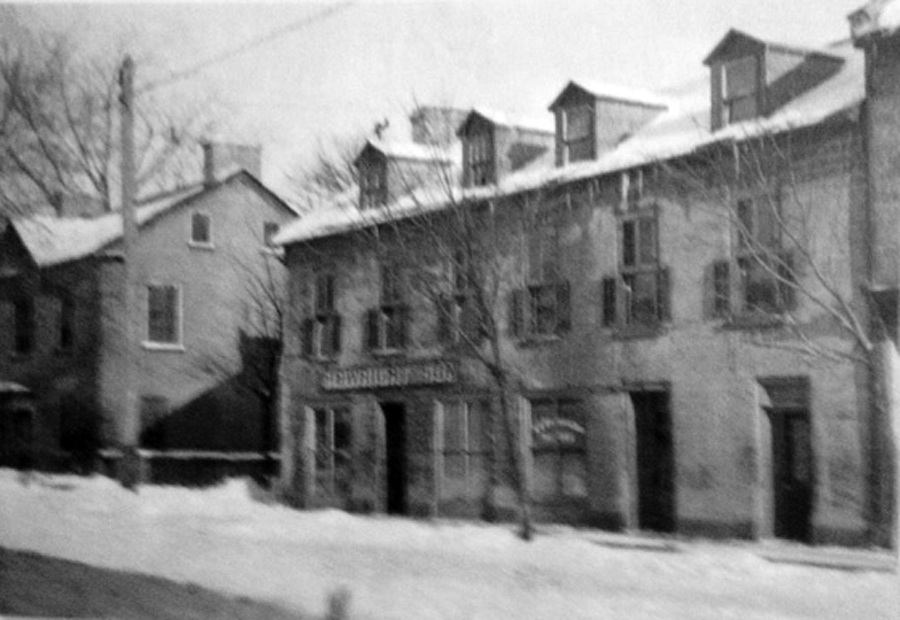
Sheriffs House to the left and the building to the right now home to Studio Theatre and Stone Cellar Restaurant. Photo courtesy: The Perth Museum.
THE BALDERSON THEATRE 1915
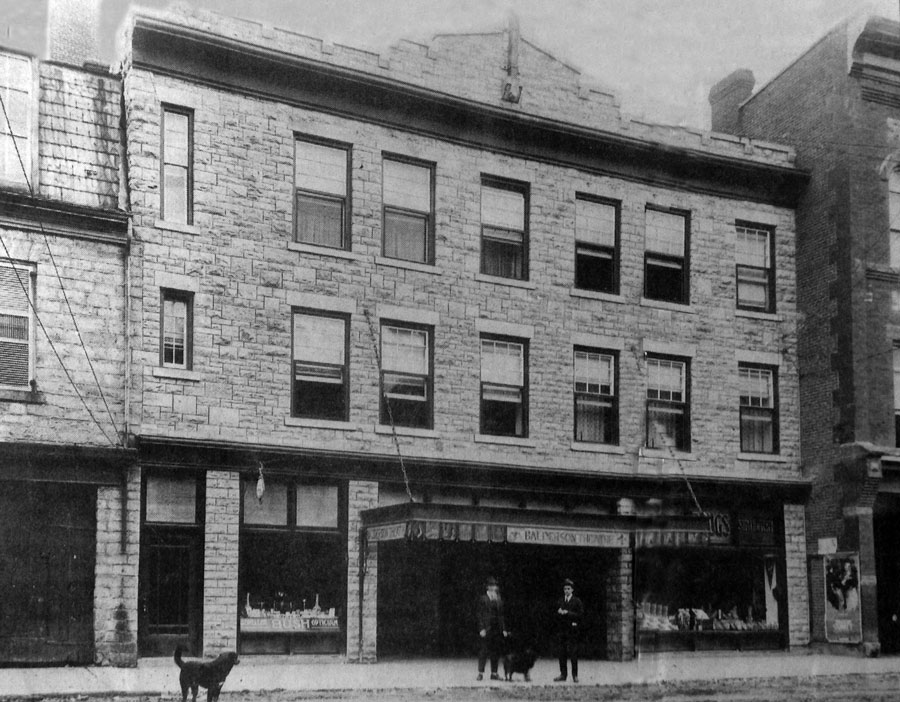

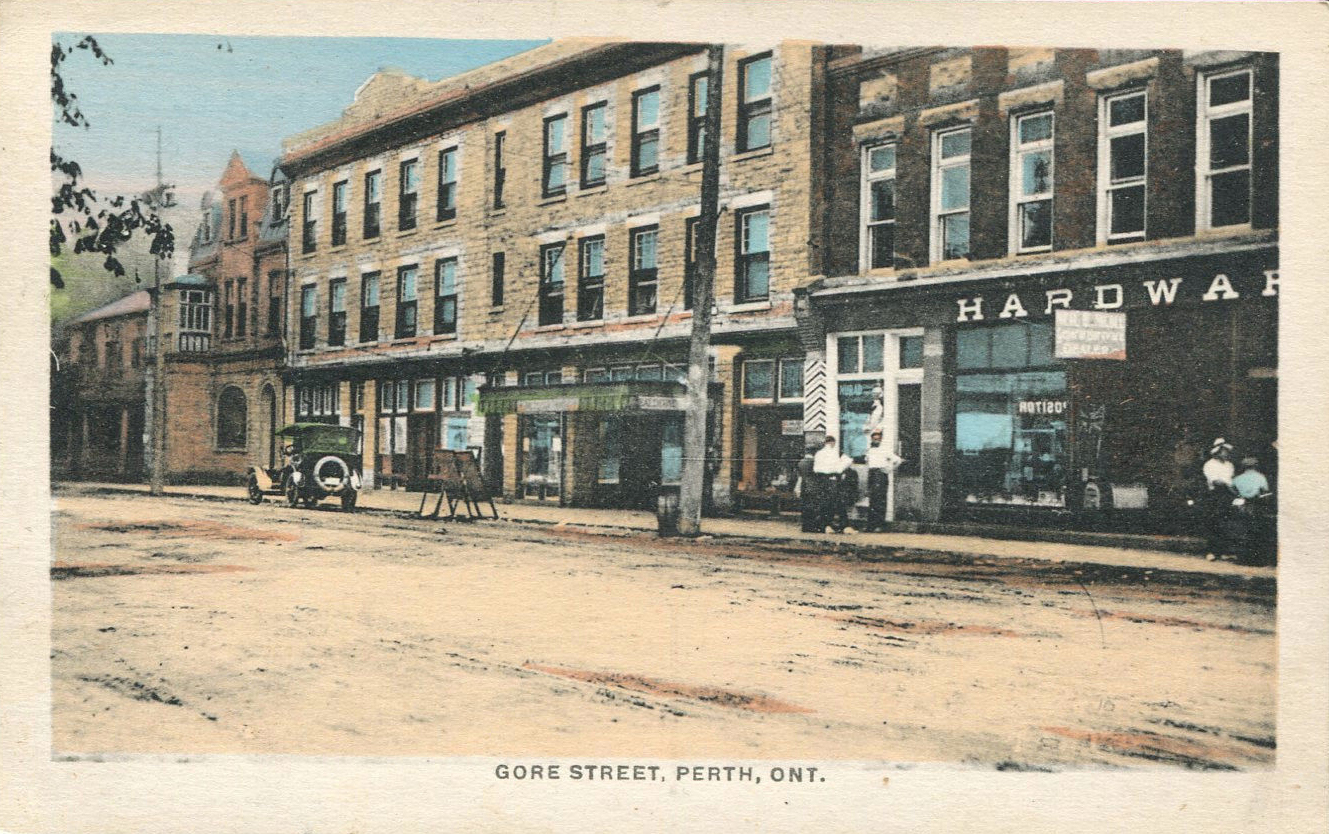
Neil B Nicol Hardware Store to the right beside the Balderson Theatre and the Bank of Montreal to the far left.
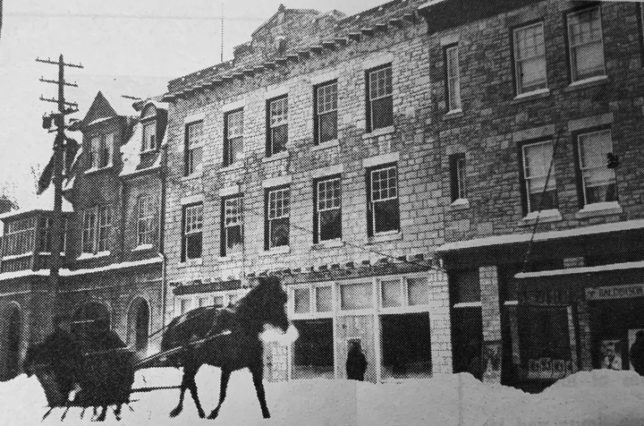
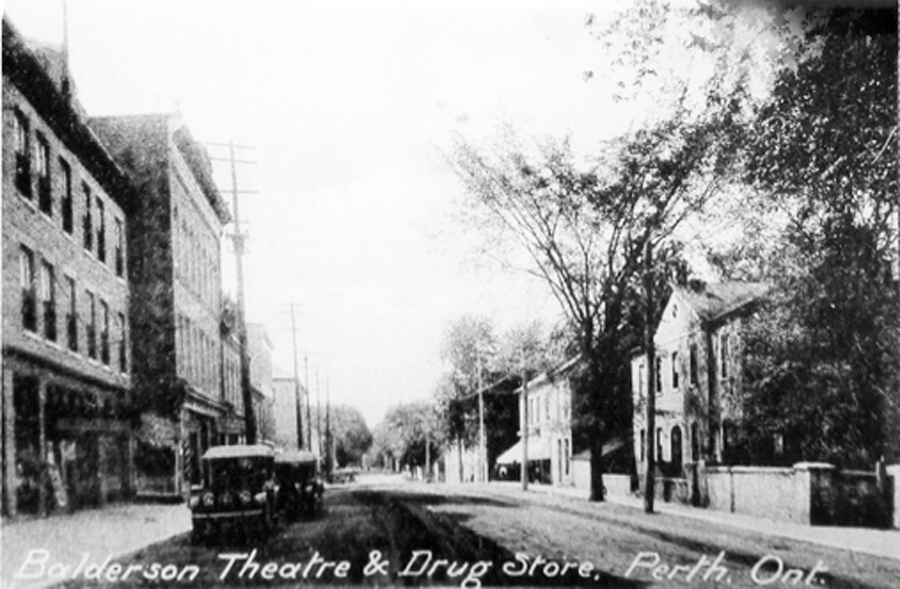
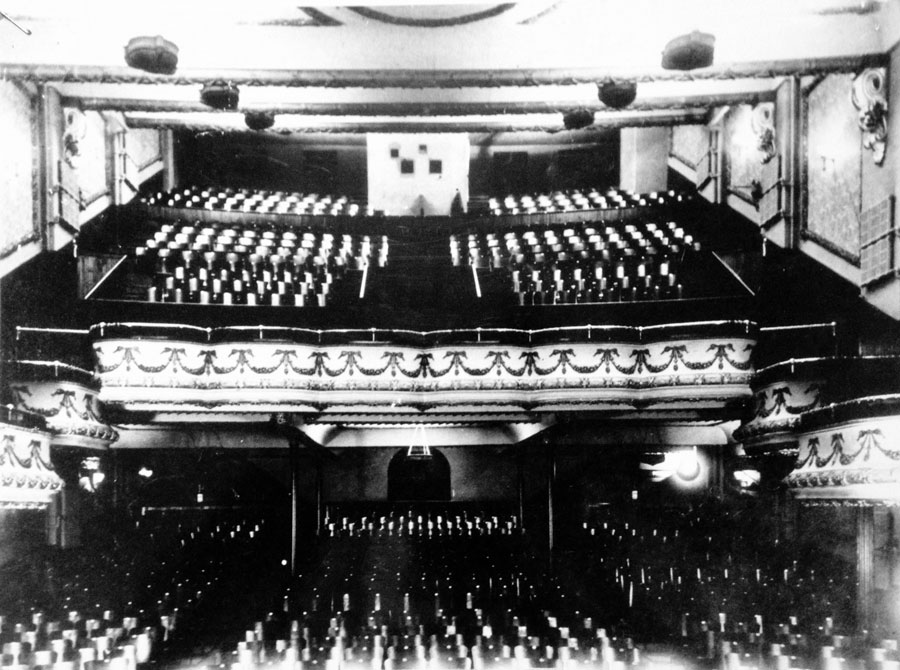
The Balderson Theatre beside Nicol’s Hardware Store was built by Col. Balderson in 1915. This theatre had a large balcony and 1,000 seats, which was the largest between Toronto and Montreal. Vaudeville and Repertory stage which often featured local legends the ‘Marx Brothers Company’ while taking summer breaks from their North American travels. Harry Houdini also played here. Movies were shown here until roughly 1958, when the theatre closed (Premiere Theatres was the last operator).
For more on the Balderson Theatre go to Entertainment: http://www.perthremembered.com/wp-admin/post.php?post=120&action=edit
SHEEP HERDING ON GORE STREET 1893

Looking North on Gore Street before 1915. In the far distance the spire of The United Church. To the right corner of Foster and Gore Hicks House (Hotel Perth) and Shaws. To the left at foster Warren and McCarthy Hardware and Meighan Brothers. The open lot to the left would soon be home to The Balderson Theatre. Photo courtesy The Perth Museum.
THE DRENNAN BLOCK, GORE AND FOSTER STREETS
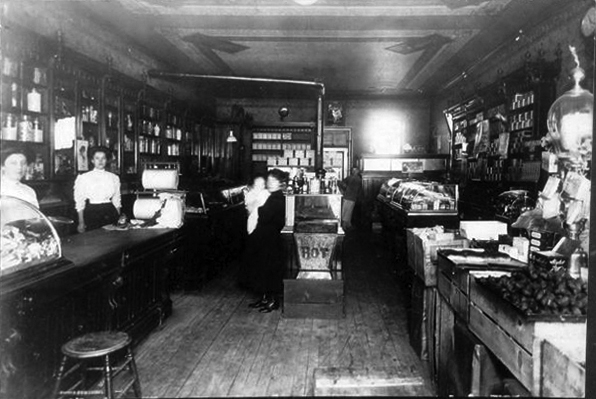
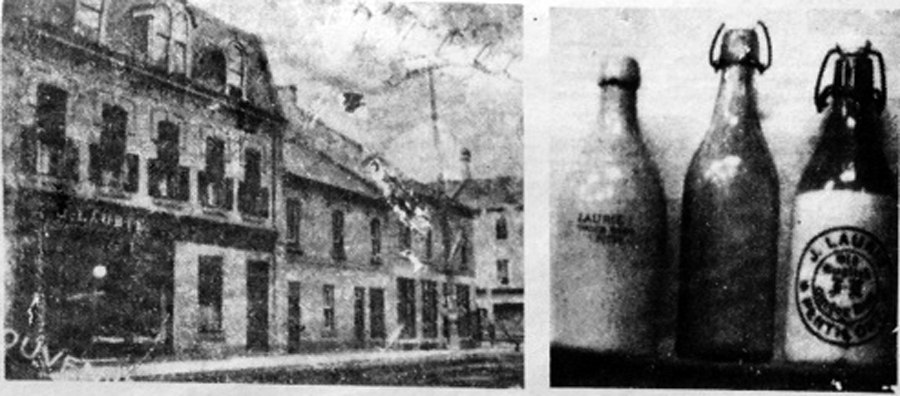
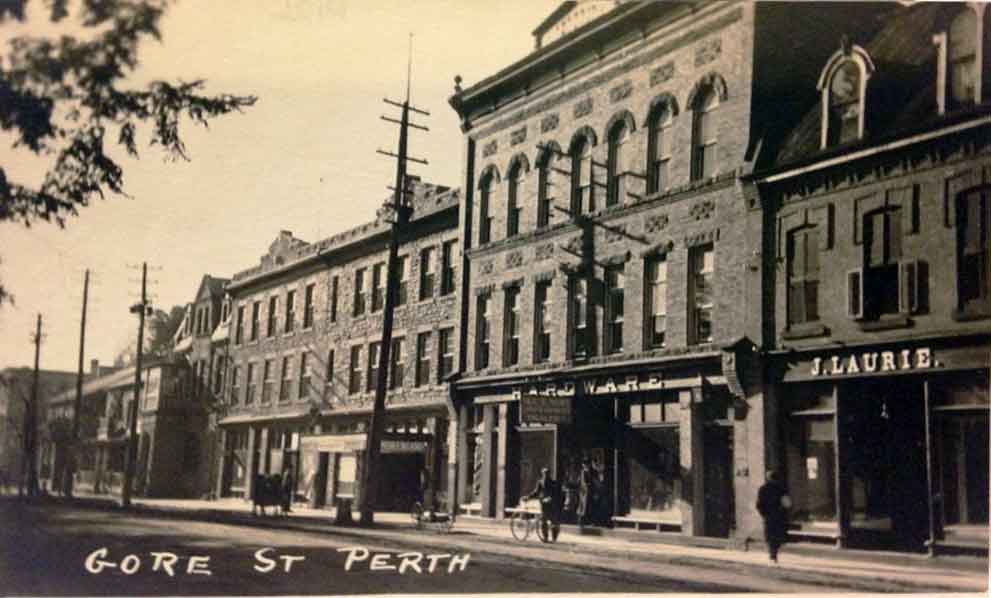
Mrs. Laurie’s Bakery and Confectionery, Gore Street. The three storey white brick building in this picture was erected in 1886 as a store with residence above. Baking and candy making were done in the basement, where the bake ovens were situated. The store was elegantly furnished with mahogany shelving and counters, topped with solid walnut. Adjoining the store was neat restaurant in which oysters, ice cream and frut were served in season, together with bread, cakes and pastry. A favourite lunch consisted of buns and chunks of local cheese with a bottle of Mrs. Laurie’s Old English Ginger Beer.
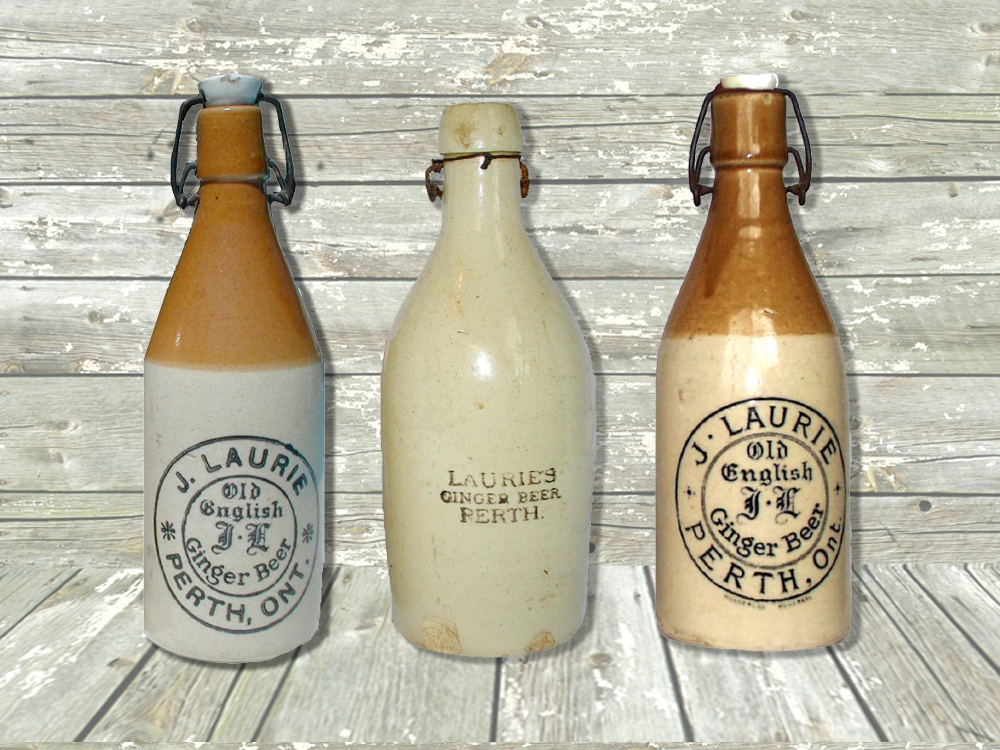
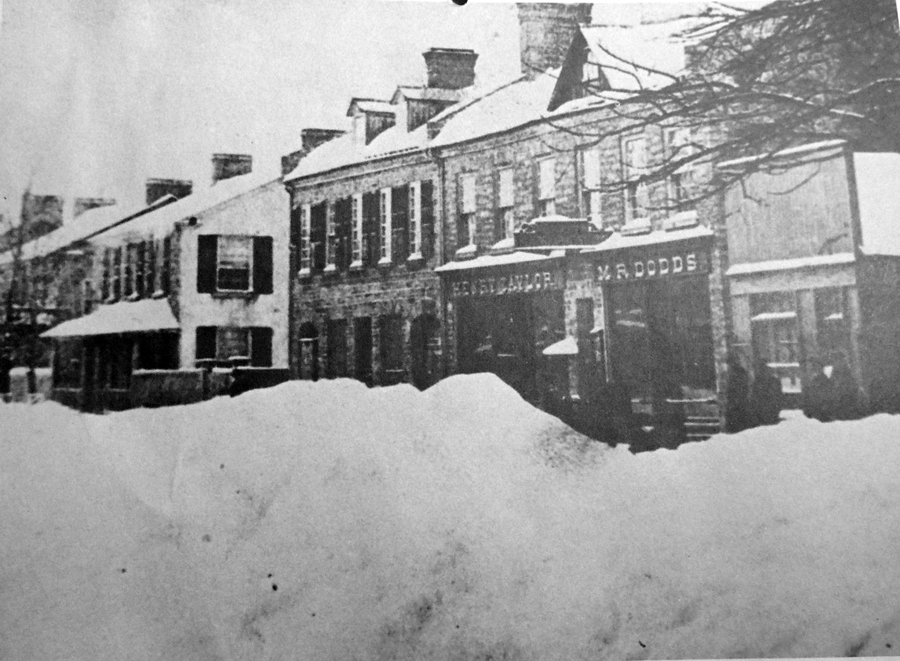
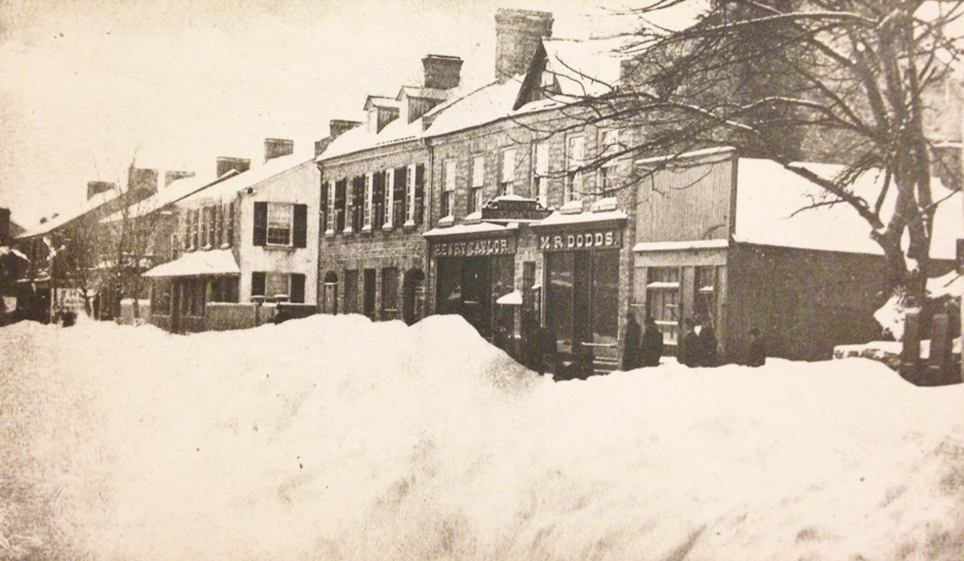
The site of the Balderson Block on Gore Street circa 1890. Shown in the picture is the Douglas Block that was home to Henry Taylor’s Hardware Store, M. R. Dodds grocer, J. H. McCulloch Dentist, George Barrie butcher, Perth Star office, Mrs. Mair and boarders and W. H. McIntyre photographer. This block was destroyed December 9, 1891 in a $40,000. Fire. The lot stood vacant until 1914 when Col. Balderson started construction of the Balderson Theatre at a cost of $150,000
PERTH COURIER, FRIDAY DECEMBER 11 1891
DESTRUCTIVE FIRE IN PERTH. Great loss of Property. Nearly $40,000 gone in smoke. December 9, 1891
About half past one o’clock on Wednesday morning the people of the town were aroused from their slumbers by the tolling of the alarm bell in the Catholic Church, and on rising a bright glare of light was observed in the centre of the town. It was soon found that the Douglas block on Gore Street was the scene of the conflagration. The fire was discovered by Mr. Andrew Robinson, who was driving the hicks’ House bus from the train and he gave the alarm. The Doulas property was occupied by Mr. Henry Taylor, hardware merchant, whose shop was in the south end and whose storehouses extended in a long range to the rear of the lot; the north end was occupied by Mr. M.R. Dodds, as a flour store, with a storehouse behind. North of this was a one story frame building owned and occupied by J. M. Poole as the Star printing office. South of the Douglas block was Mr. G. F. Barrie’s butcher-shop, and Mrs. Mairs’ boarding house in a block owned by Mr. Barrie. Above Mesars. Taylor and Dodds were the dentistry office of Mr. J. H. McCulloch and the photograph gallery of Mr. w. H. McIntyre, neither of whom saved anything. The fire stared in one of Mr. Taylor’s storehouses about the middle of the range, and and from the fact that no fire was ever going near this place and only lanterns used for lighting, it is supposed the fire must have been the work of tramps, a number of whom are always on their pilgrimage through the town. In no other way could the fire be accounted for. A fierce wind was blowing at the time from the south and drove the flames on quickly towards Mr. Taylor’s and against the Star office which being of inflammable material was almost in a breath involved by a sheet of fire. The forms and a few cases of type were saved but that was all. The presses, machinery, stationery, furniture, etc, was swept away in a very short time. Mr. Dodds’ store was also very soon a devouring mass of flames, and not a thing was saved. Mr. Taylor’s store and stock was the most valuable property in the whole fire district. Both front and back stores were filled with iron goods of all kinds to the value of perhaps sixteen thousand dollars, and of this a few hundred dollars worth only, were rescued. More perhaps might have been got out but the fear of powder and cartridges exploding kept the people out after the fire entered the store. And then the gale drove the flames all through so quickly that smoke and fire soon filled the whole place. Mean time the steamer engine was fired up in its place in the engine house, the hose stretched to the place, but delay arose in getting a stream of water to bear on the flames, want of practice no doubt kept down the speed necessary to meet an energy at once, but chief and men exerted themselves with coolness and vigor, and streams of water both in front and rear after a time played constantly in the flames, assisted by one from the hand engine. The rest of the wooden outbuildings in the rear increased the danger of the fire spreading in that direction, and to meet this contingency, as well the danger at other points, the Mayor of Smith’s Falls was telegraphed to send up their fire steamer and a body of firemen to help our own firemen. This was generously responded to and in an hour or less the Smiths Falls steamer and men, with the Mayor, Reeve and other citizens were at the station and soon after taking position at Dennison’s Bridge, and streams playing on the flames also.
The fire had gained ground until it caught on Mr. Andrew Barrie’s stone building and after gutting this block completely and destroying the out-buildings was checked and finally subdued. Mrs. Laurie’s fine brick block, north of the burned district, was at one time in great danger but the good brick walls mostly free from windows and the efforts of the firemen saved it. Buildings were in danger far and near northward, owing to the huge flakes of burning wood, but flying the snow on the roofs helped to smother any incipient flames, and no other fire broke out in spite of the gale. All the plate glass windows in the Matheson buildings occupied by Miss Wallace, Mrs. Jordan and Mr. Wm. Northgraves, were cracked by the heat and of course destroyed.
The loss will aggregate about $40,000 and is distributed something as follows:
Douglas Estate Loss 8,000. Insurance 6,000. – Henry Taylor Loss 16,000 Insurance 10,000 – R. Dodds Loss 3,000 Insurance 700 H. McIntyre Loss 2,000 Insurance 600 – H. McCulloch Loss 1,000 Insurance 500 – M. Poole Loss 5,500 Insurance 3,000 – Andrew Barrie 3,000 insurance 3,000 Malloch Estate Loss 150 – Mrs Mair and boarders Loss 500 – Miss Wallace Loss 400 Insurance 400 – Mrs. Jordan Loss 100 – Matheson Estate Loss 150
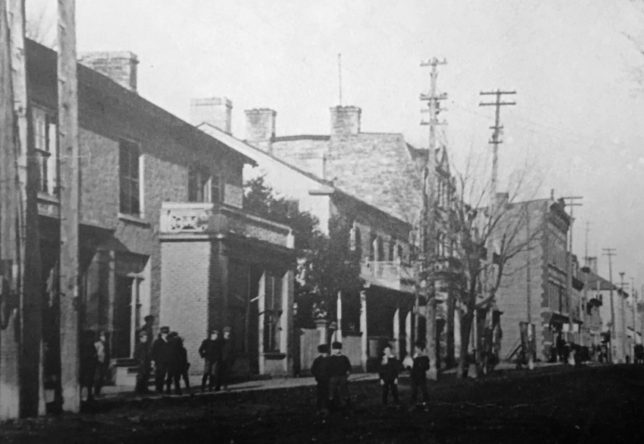
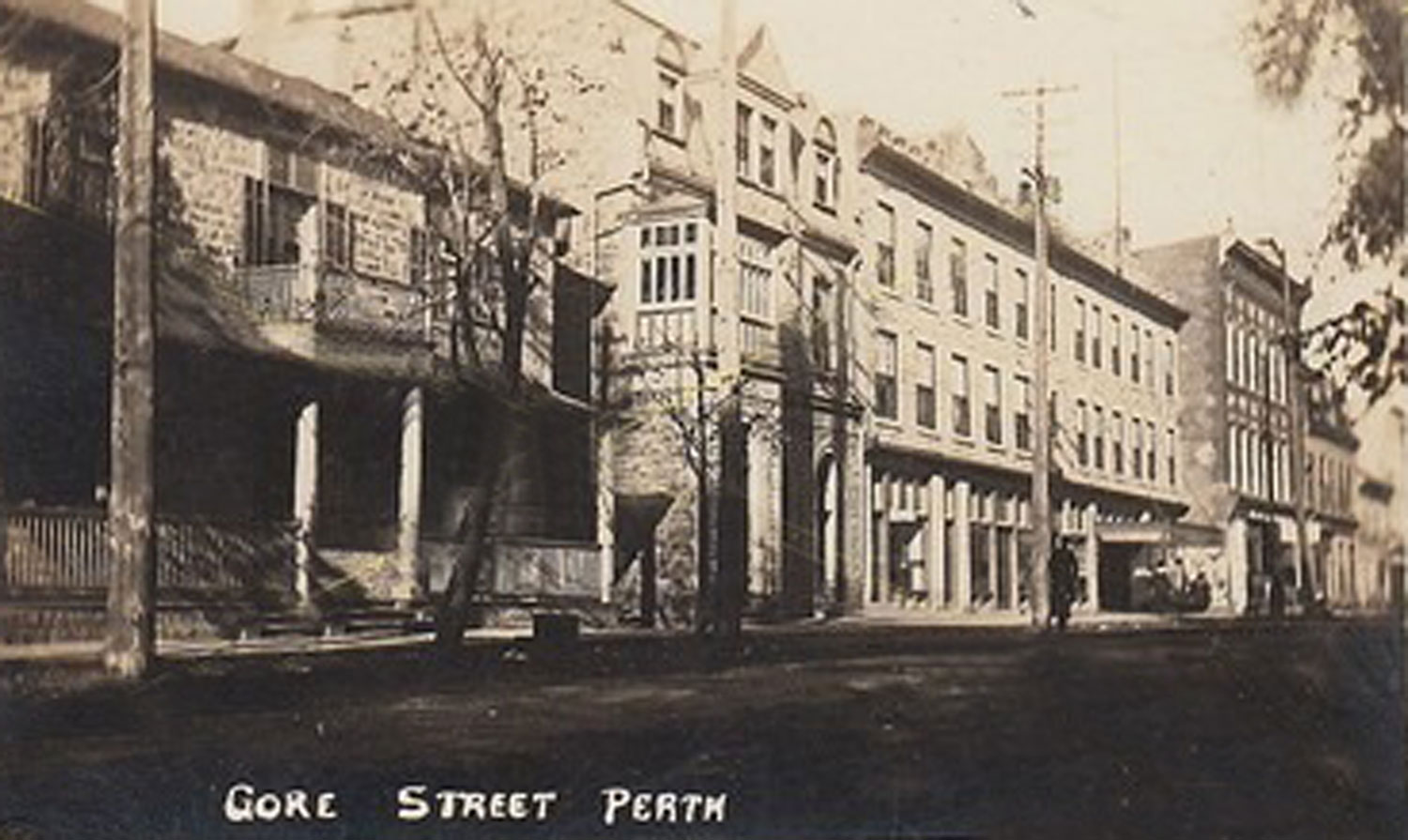
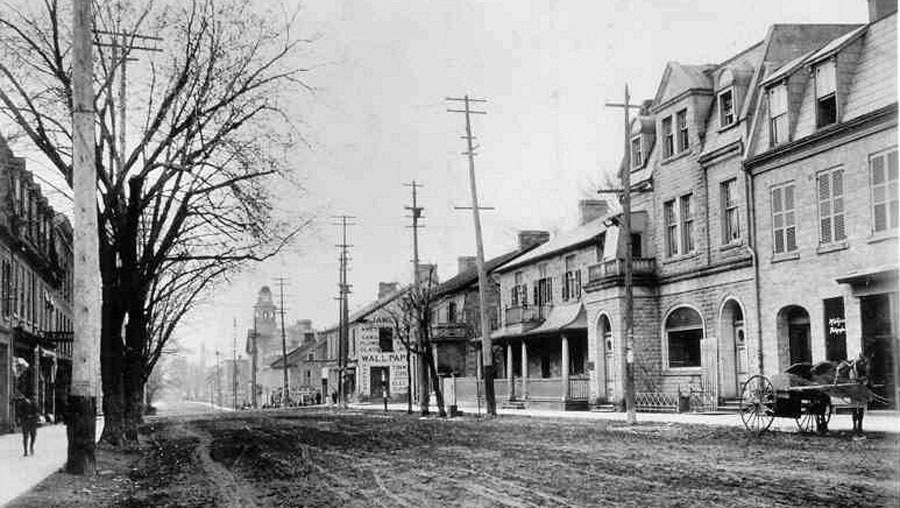
Photo: Courtesy The Perth Museum
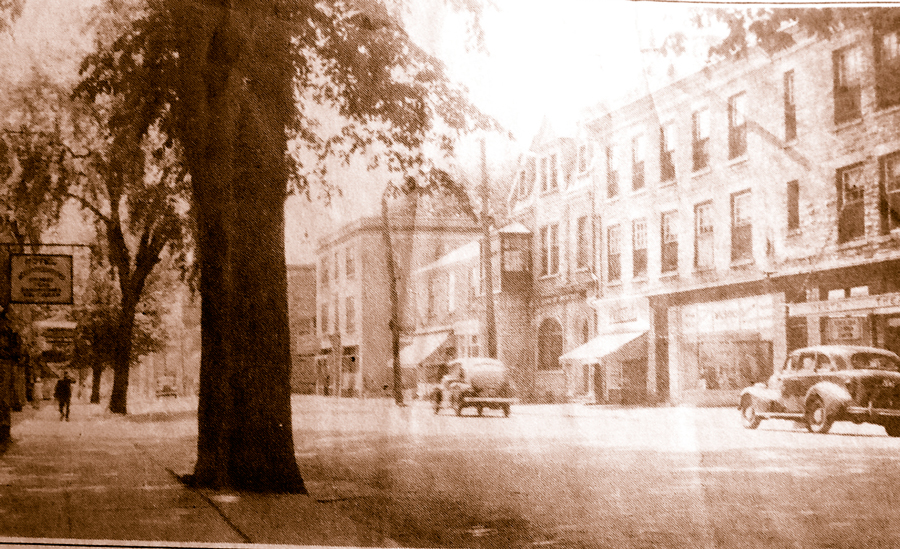
Gore Street looking south c.1930’s. Photo: The Perth Courier
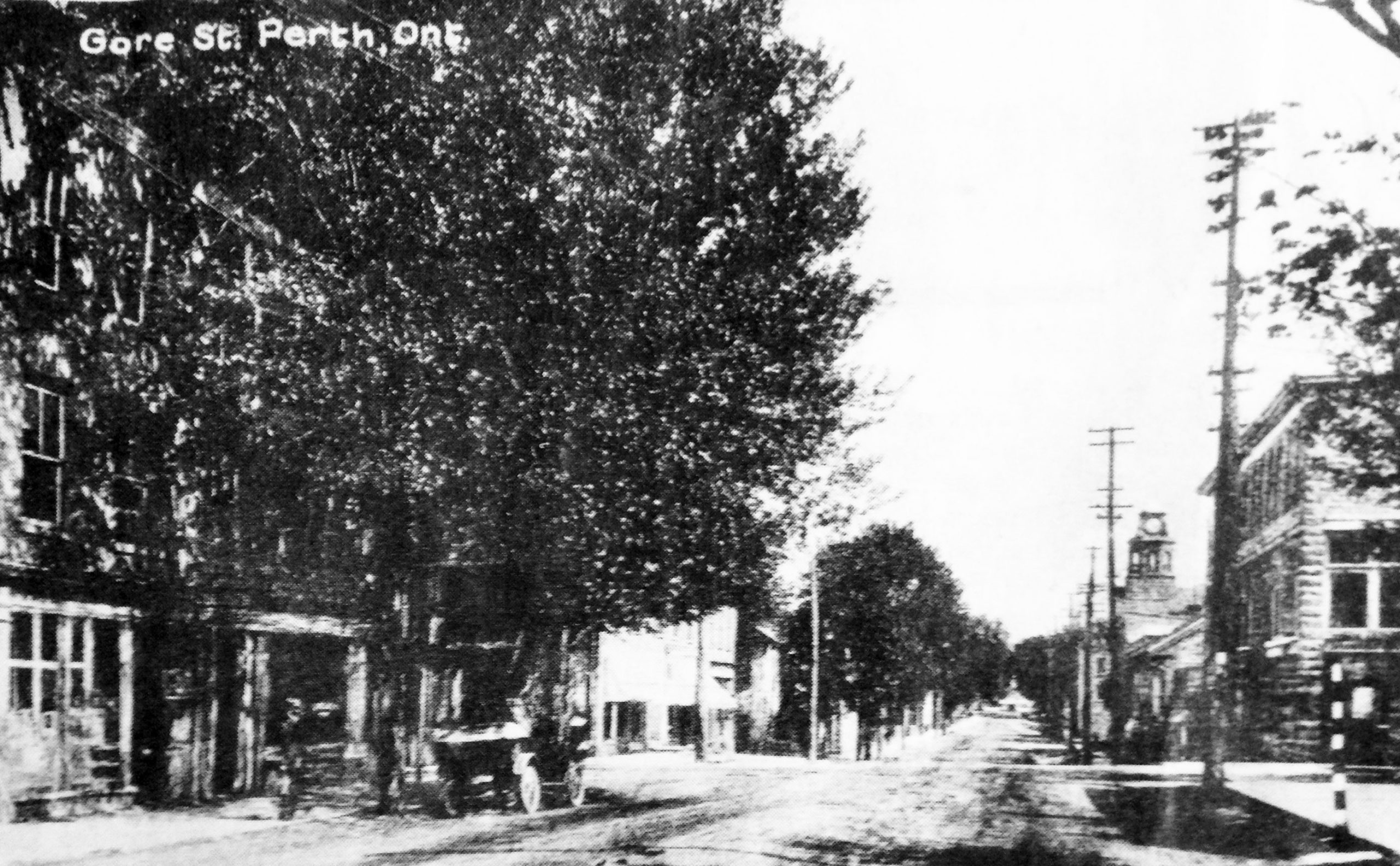
THE PERTH TEA ROOM AND CANDYLAND
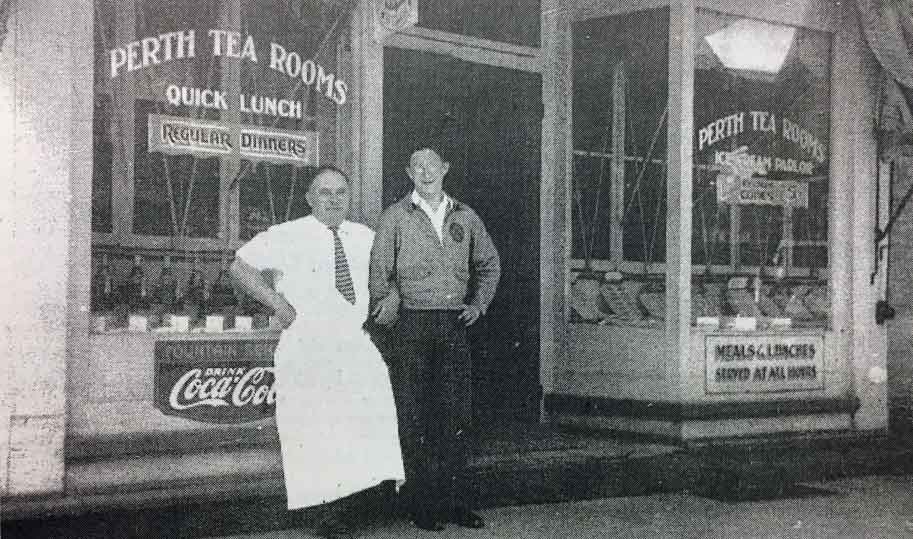
Chris Moskos, proprietor of the Perth Tea Romm (left) and Reg Pownal stand in front of the popular Gore Steet restaruant. circa 1940
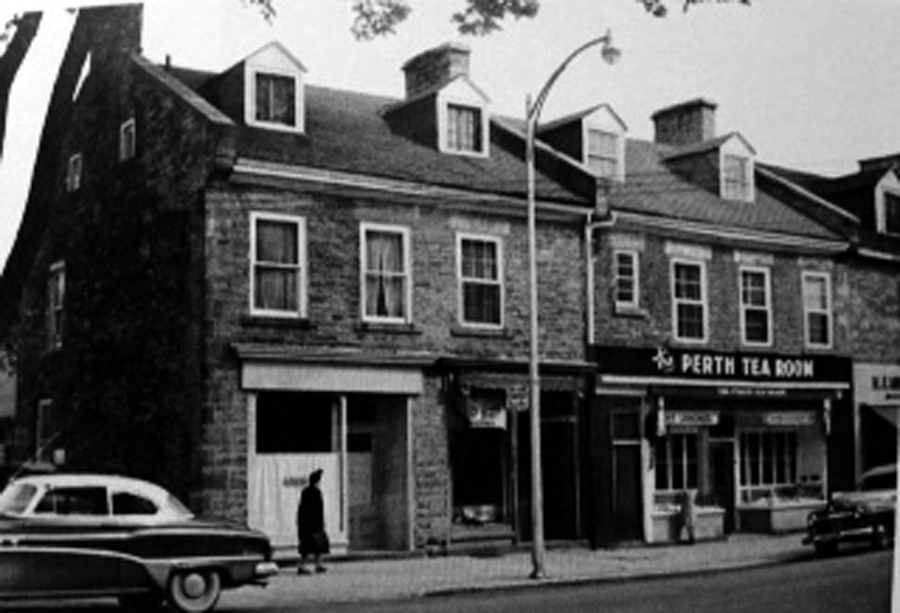
The Perth Tea Room, 1952. Photos courtesy Peter Moskos from his book: Chris Moskos: A Memoir.
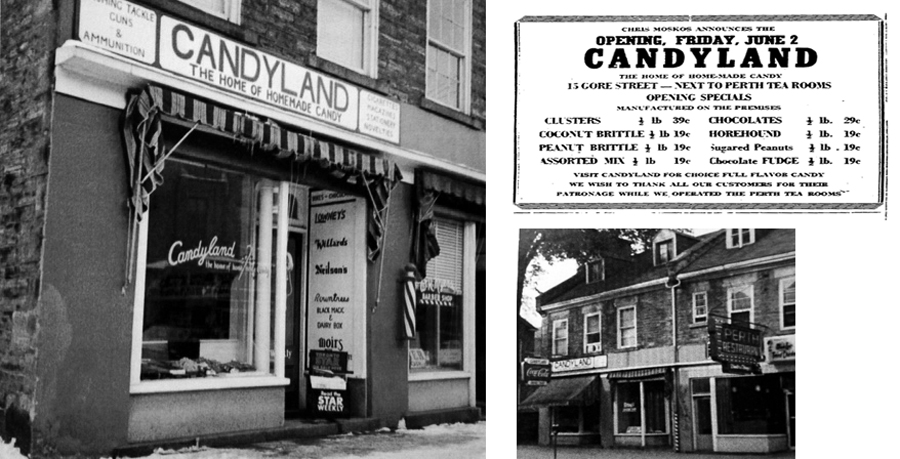
Candyland also sold fishing tackle, guns and ammunition as well as candy, cigarettes and novelties.
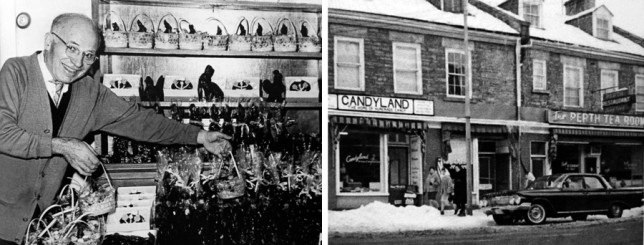
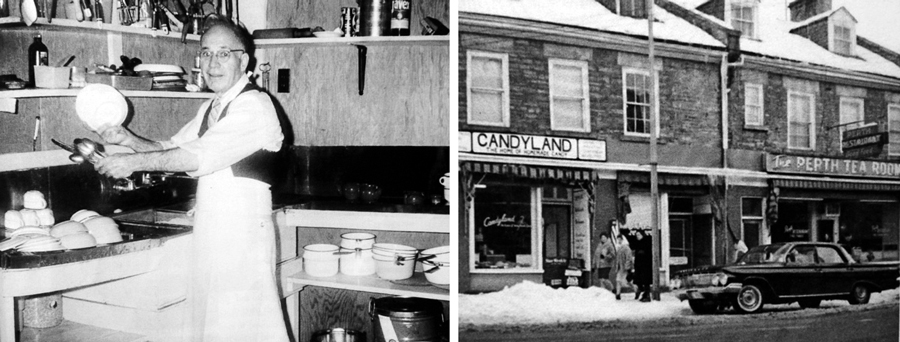
Chris Moskos getting ready for Easter and a street shot of Candyland and The Perth Tea Room with Doug Mully’s Barbershop in-between.
Chris Moskos operated the Perth Tea Room from the early 1940’s to 1960. This popular meeting place boasted a soda fountain, large cases of homemade candy and a full sized restaurant. In 1960 Chris sold the Tea Room and moved his candy business, Candayland, two doors down. Candyland sold all of the same candies as the Tea Room as well as cigarettes and magazines, fishing tackle, guns and ammunition. Chris died in 1964 and Mrs. Moskos kept Candyland going with the help of her children until she retired in 1970.
SHAWS OF PERTH

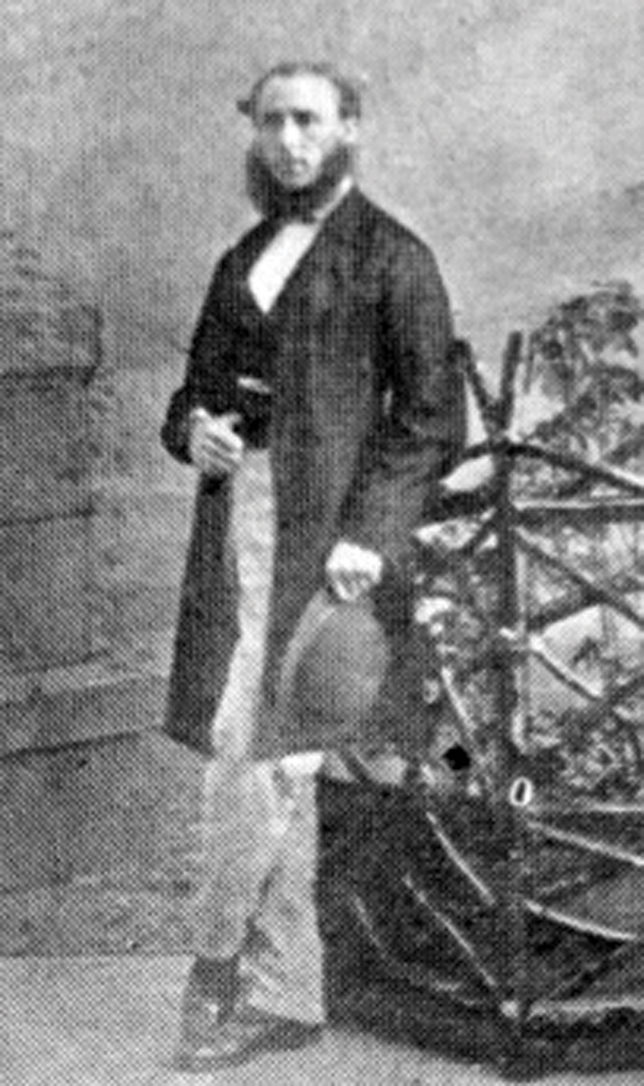
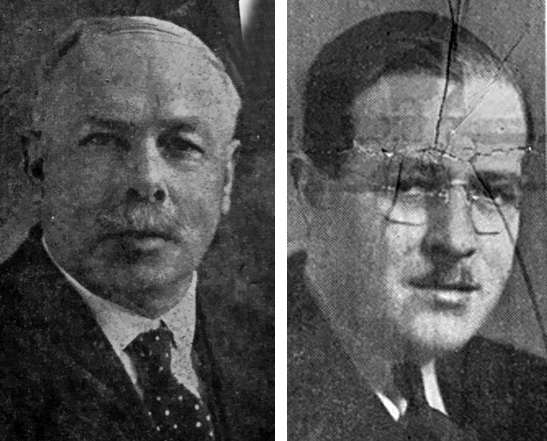
The Honourable Roderick Matheson built both his private home (now the Perth Museum) and the store in 1840. Originally a saddle and harness shop the store later also served as the print office for The Perth Expositor (forerunner of The Perth Courier). When Henry D. Shaw of Smiths Falls, married a daughter of Matheson, in 1859, he opened a clothing store on the site and is one of the oldest Canadian businesses still operating out of its original store front. In the early years its merchandise came up the St Lawrence from Britain to Montreal then to Perth by barge via the Rideau and Tay Canals. It was run by the family until the early 1980’s.
Back in the early days, Shaw’s sold a wide variety of commodities. Women’s wear was mostly in the form of bolts of cloth, yards of frothy lace, needles and threads since ready-to-wear was almost unheard of. So it was natural that dry goods took yup a good amount of poor space. On the other side of the store there were crackers, cheese, pickles and potatoes – and all the food stuffs that Shaw’s could order. A stone warehouse in the back of the store serviced horse-drawn delivers and Shaw’s wholesale trade. The section of the store that became the business offices were at one time the law offices of Arthur Matheson. Old invoices dating back before 1867 show that pounds, shillings and pence were the currency used and it wasn’t until after Confederation that the system converted to dollars and cents. Henry D. remained active in Shaw’s operation until his death in 1886, when he was succeeded by Henry M. Shaw. He saw to the flourishing enterprise for 45 years and upon his death in 1931 the third Shaw, Henry F. stepped into management.
The store building itself did not come under Shaw ownership until 1920 when Henry M. bought it from the Matheson estate. The last family members to own and run the store were Nora Clemens and Sid Shaw. Long time manager of the store was Walter Bromley from 1954 to early 1980’s.
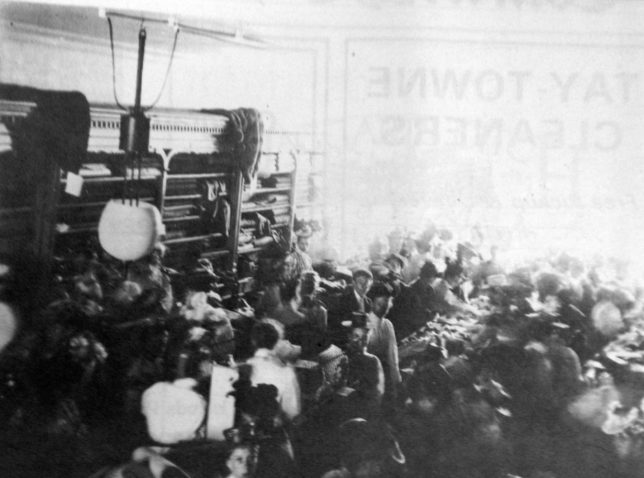
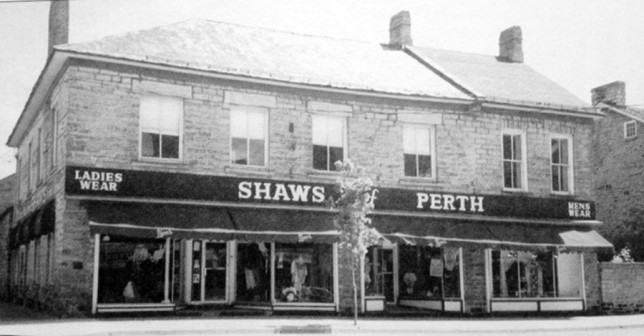
C.1940. Photo courtesy The Perth Museum.
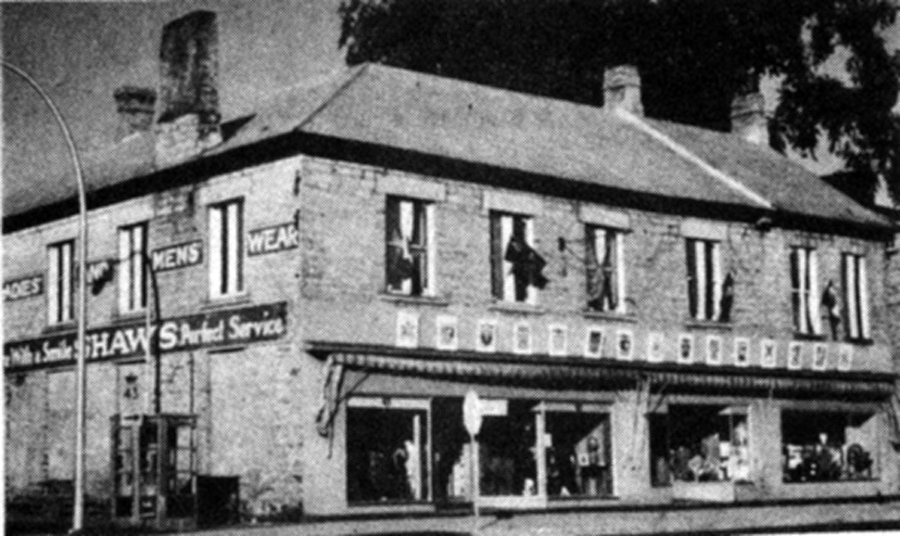
Shaw’s decorated for Old Home Week and Canada Centennial 1967
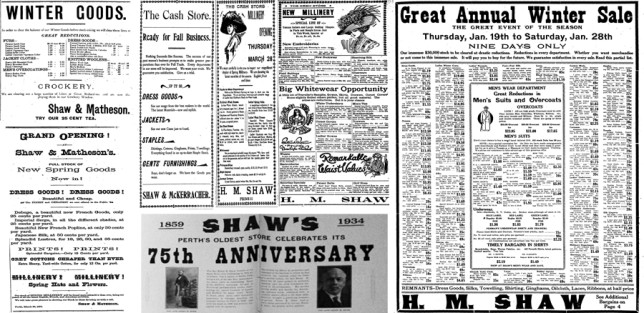

Bill of sale for goods received by Shaw & Matheson from Joseph Mackay & Brother of Montreal, 1897.
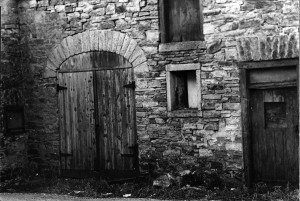
Storage shed behind Shaws. Photo: 1973, ©David Bromley

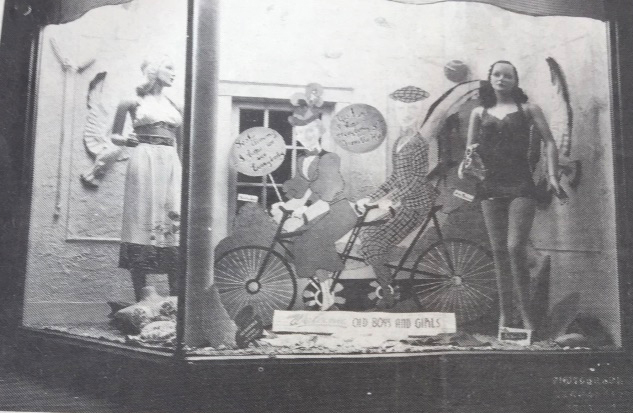
THE PERTH EXPOSITOR
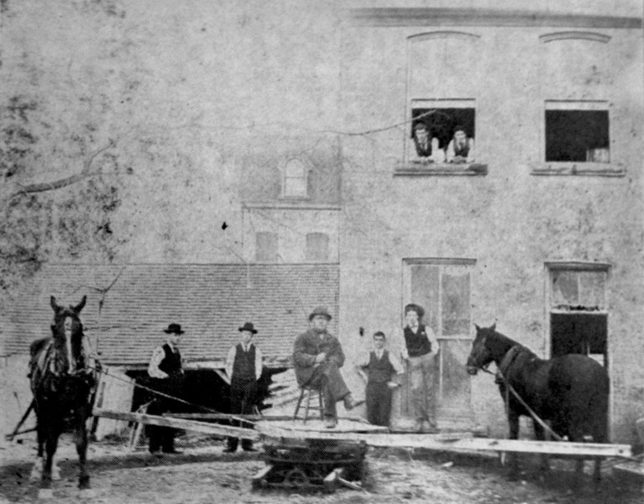
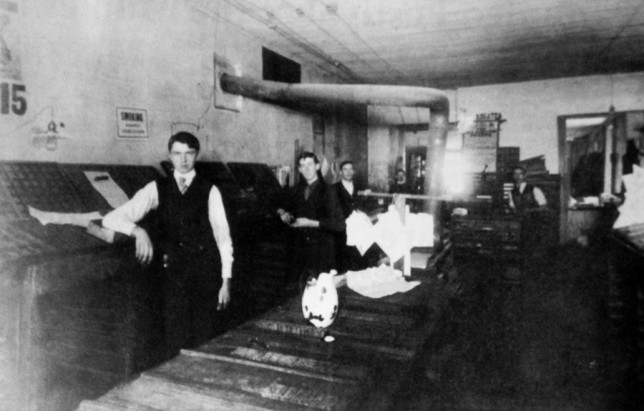
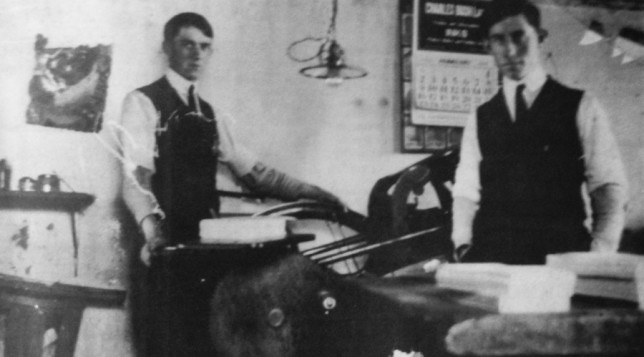
Perth Courier 1987 – from the files of Michael Taylor
History of the Perth Expositor
The year 1860, proved to be a monumental one for newspaper readers in Perth, for it was then that the town’s second newspaper came into existence and continued to do so for the next 75 years.
The Perth Expositor as it was known owed its existence to a former Kingston resident, Thomas Cairns, who made his way from the fortress town to Perth in order to set up shop.
Thomas Scott, who was later to gain fame in the Red River Rebellion, which involved Louis Riel and the Metis soon became a partner in the paper. The partnership later dissolved when Mr. Cairns was appointed to the position of postmaster in Perth, leaving the paper under the control of Mr. Scott.
In 1886, Colonel A.J. Matheson, of the well known Perth family of that name became the proprietor of the Perth Expositor. He later relinquished control of the paper to Captain J.W. Motherwell, who was acting as publisher when Colonel Matheson was appointed Ontario Provincial Treasurer.
That same year, 1886 Charles F. Stone, fresh from the Perth Collegiate Institute began employment at the Perth Expositor as a “printer’s devil” (A printer’s devil was an apprentice in a printing establishment who performed a number of tasks, such as mixing tubs of ink and fetching type.)
When Mr. Stone had successfully completed his apprenticeship in 1890 and in 1893 when Mr. Motherwell became ill and Mr. Stone then took over the duties left vacant by Mr. Motherwell. In 1889 control of The Expositor was passed into the hands of Mr. Stone. He remained as editor and proprietor of the paper until early 1914, when he was appointed Collector of Inland Revenue in Perth.
Following Mr. Stone’s resignation as editor and proprietor of The Expositor, the everyday running of the paper was taken over by his son, Harold C. Stone who was later killed overseas in WWI.
The Expositor was next taken over by the Perth Expositor Publishing Company with J. A. Blackburn, as managing editor.
When the two distilleries in Perth, McLaren’s and Spalding and Stewart, ceased operation the internal revenue branch became extinct along with Mr. Stone’s position. Mr. Stone returned to the paper as managing editor in January 1933.
The rest is history. Four years later the Expositor ceased publication when it was absorbed by the Perth Courier.
For many years thereafter the Courier banner proudly proclaimed “The Perth Courier, with which is incorporated the Perth Expositor”.
During the 75 years in which the Expositor continued to publish it moved its premises three times. It was first housed in Shaw’s building on Gore Street, in a part of the building closest to the Perth Museum. During this time Henry Kehoe used his bay horse which trudged a worn circular path at the rear of the bui9lding every Saturday morning turning the paper press.
For a number of years the paper was located in the location where a barber shop was located for many years beside the Perth Tea Room.
But in 1916 the Expositor moved for the last time when it occupied an establishment in the Perth Theatre block. James Kinlock a writer for the Expositor at the time of its demise wrote a brief but precise obituary of the paper part of which follows.
“Through the years it kept pace with changing methods. The horses which turned the first press were replaced by a gasoline engine, one of the earliest in Perth and this in turn was supplanted by an electric motor. It’s cabinets of small type for the news columns were replaced by linotypes new machinery from time to time was installed and kept pace with changing layout styles and type fashions. Consistently for 75 years the Perth Expositor served its readers and advertisers fairly and its record is untarnished”, he wrote proudly.
He went on the write that the life of the community had pulsed through its columns for 75 years. Countless galleys of type, recorded and successive births, marriages, deaths and other items of lesser importance to the people of Perth and surrounding country.
“The last item to go into its forms is its own obituary,” wrote Mr. Kinlock.
“With this issue, January 15, 1936, The Perth Expositor ceases to exist, the same having been purchased by the Perth Courier Publishing Company, which will take over the plant and subscription list. The Expositor has at all times endeavoured to give its readers the news of the district and in addition a diversity of subjects were dealt with, thus appealing to the tastes of all. To our subscribers and patrons we extend our sincerest thanks and deep appreciation for their patronage in the years past and wish for everyone of them everything that is good and noble accompanied by a due shar of prosperity for the future” The Editor Charles Stone.
DODDS & ERWIN 1921
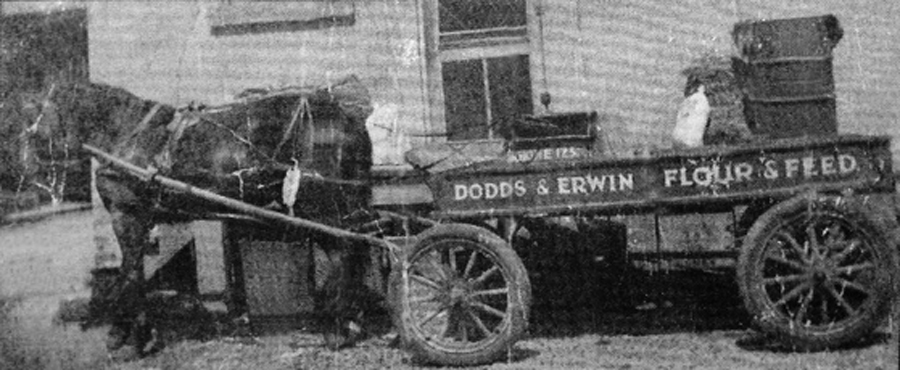
Photo: The Perth Courier
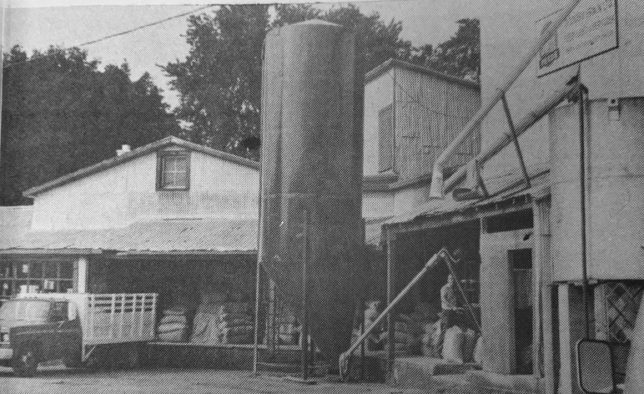
DAVID HOGG & George Thompson FURNITURE AND UNDERTAKER
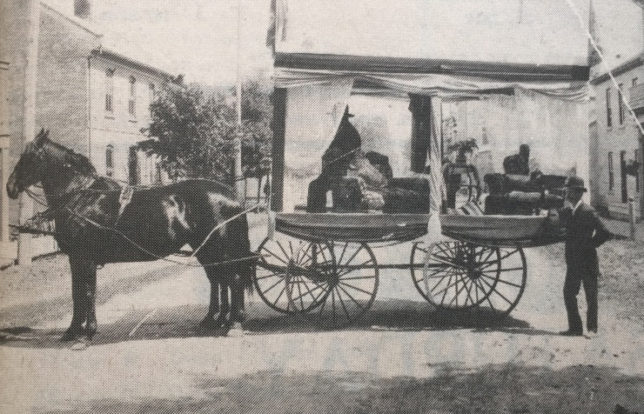
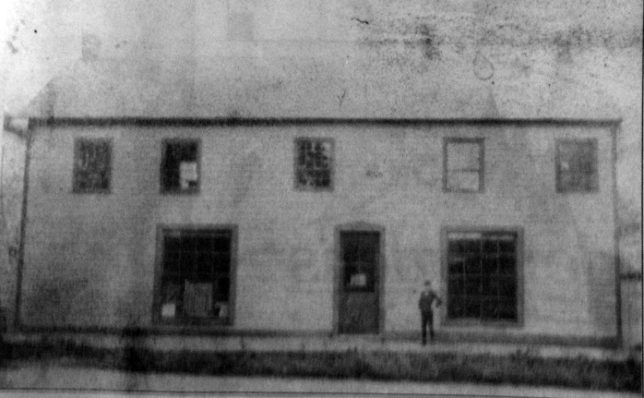
In 1839 Perth was one of the very few spots in all the province to have an established burial service. At that time a cabinet maker by the name of David Hogg had opened a small furniture business in a rambling two storey building on the east end of Gore Street. As a worker of wood the cabinet builder naturally fashioned caskets and it was not long before Hogg was considered the town undertaker by the citizens of the area. As a builder of the coffin he was looked upon as caretaker of the body that it entombed. By the time Hogg enlisted George Thompson another wood worker as a partner undertaking was a permanent part of the business.
But death and burial in those. days before the turn of the century received fare less formal ceremony than the prescribed ritual carried out in the modern era. When death struck there was no elaborate coffin etc. The local undertaker when brought word of the tragedy, harnessed up he’s hors and baggy and made his way to the home of the deceased. Here he embalmed the body which was then laid out in the casket. Friends and family paid their respects during the ‘wake’ held right in the home of the deceased. With the assistance of the undertaker the body was finally buried. David Hogg retired in the early 1900s and Alex Blair an undertaker from Westport moved to the town of Perth to take up partnership in Thompson’s growing business. From the Perth Courier files.
ALEX BLAIR UNDERTAKER AND FURNITURE

C. 1930’s. Alex Blair in front of the store with the funeral sedan, ambulance and funeral hearse. Photos: The Perth Courier
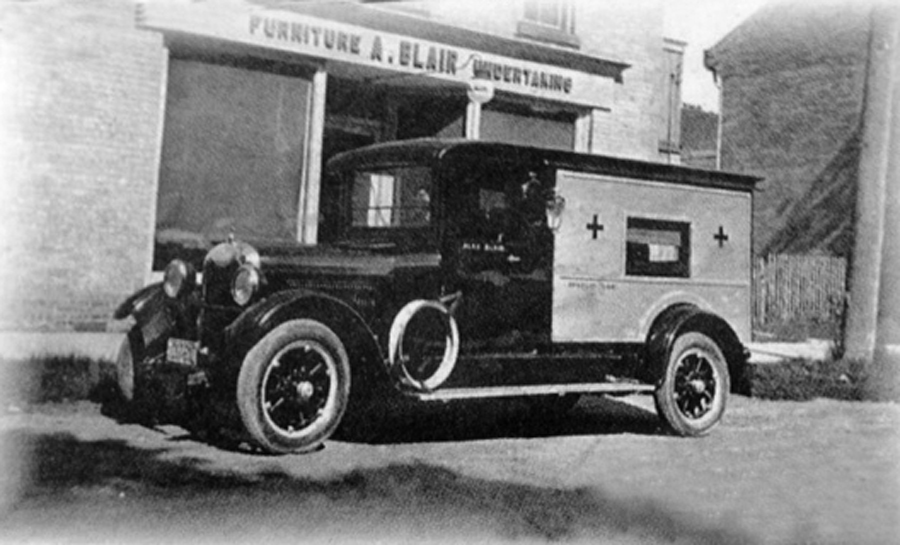
c.1920’s. Early version of Blair’s “Invalid Car”. Photo: Perth CourierThe original business was stared in 1839 by David Hogg a local cabinet-maker. George Thompson a fine cabinet-maker joined Mr. Hogg as a partner and in the early 1900s Alex Blair from Westport worked in partnership with Mr. Thompson until his death in 1920. In 1948 Blair and Son put a new ambulance into service being the first one in town and up until the early 1970’s Blair & Son operated the Ambulance Service for the Town of Perth.
FERRIER SADDLERY & RETAIL STORE at 42 Gore Street. Established 183
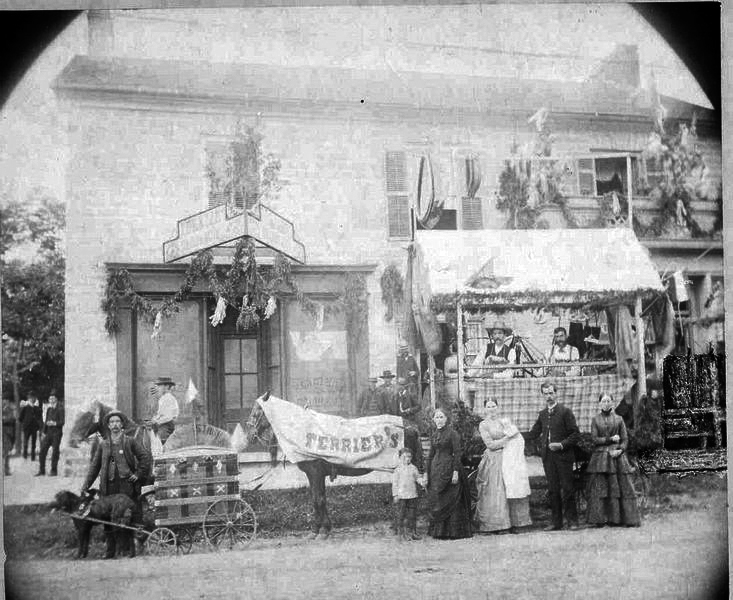
Located at the corner of Gore and Beckwith Streets. Photo also appeared in the Perth Courier, Nov. 7, 1963 and the caption reads: "Perth Manufacturing differed greatly in the 'handi-craft era' when compared with what Perth boasts today. This old 1887 photograph was uncovered by Bert Ferrier and shows the structure his grandfather built in 1847 and in which Bert was born. The Ferrier block was located at the corner of Gore and Herriott and the photo is a sort of commemoration of Queen Victoria's Jubilee. In this long-gone era, wool spinners, harness makers, book makers, furniture, wagon and carriage makers, foundries, cooperage and distillers were the main employers of labor. The builder, John Ferrier, came from Scotland in 1816 as a child and settled on the Scotch Line with his parents. Harness manufacturing was carried on in the building until 1919 when T.A. Code purchased the structure.
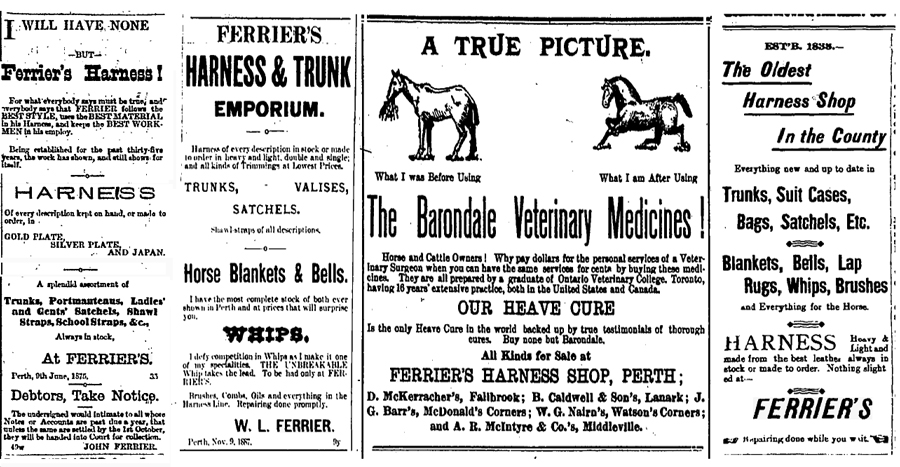
The Code Block 1915
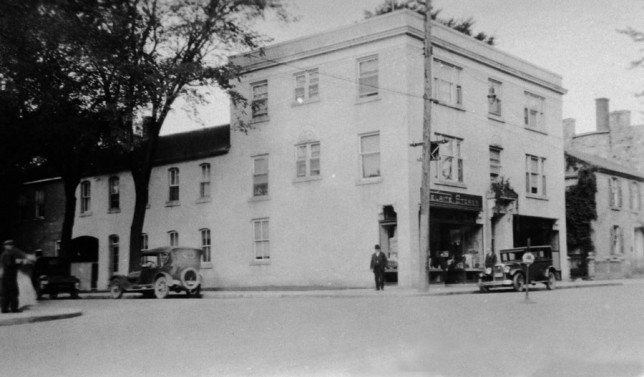
The new Code Block shown here in 1928. The original building is show in the above story on Ferriers Harness Shop. The main store here at this time was Selrite Stores 5 and 10. Lawyers offices on the second floor along with The Odd Fellows Lodge and Daughters of the Empire and apartments on the third floor.
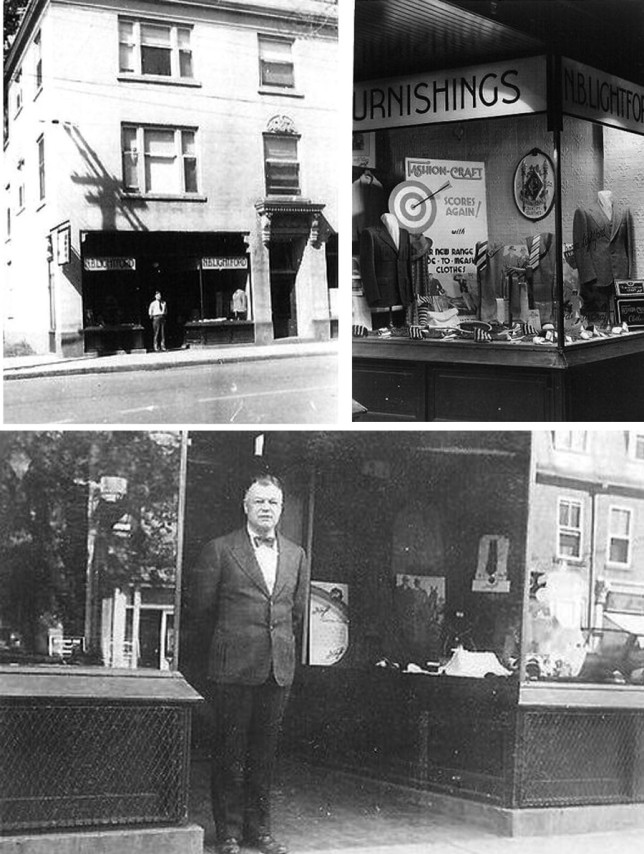
Norman B Lightford opened his mens clothing store in the Code Block in 1936. He would later move down the street by the Little River. Photos courtesy Grover Lightford.
BANKS
MERCANTILE BANK OF CANADA 1912
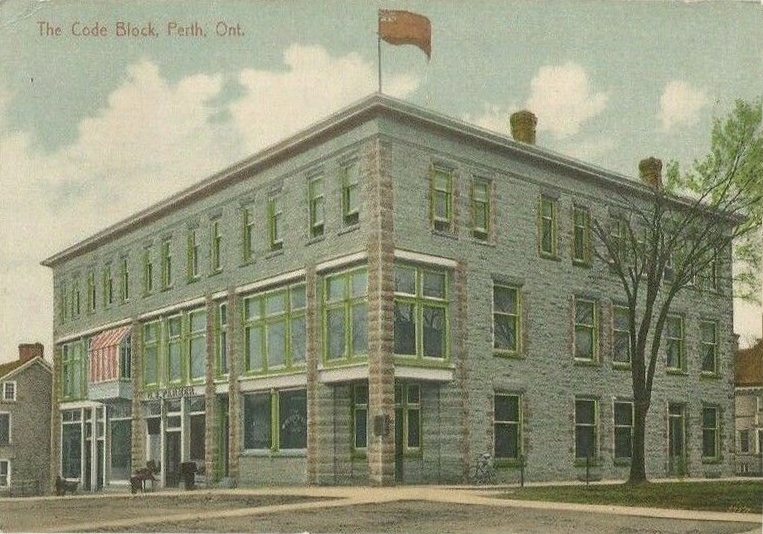
Corner of Herriott and Gore Streets in the building that was once home to James & Reid Hardware and now is home to RBC.
THE BANK OF NOVA SCOTIA
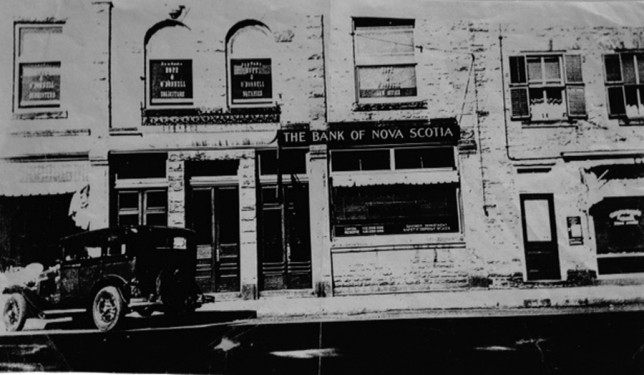
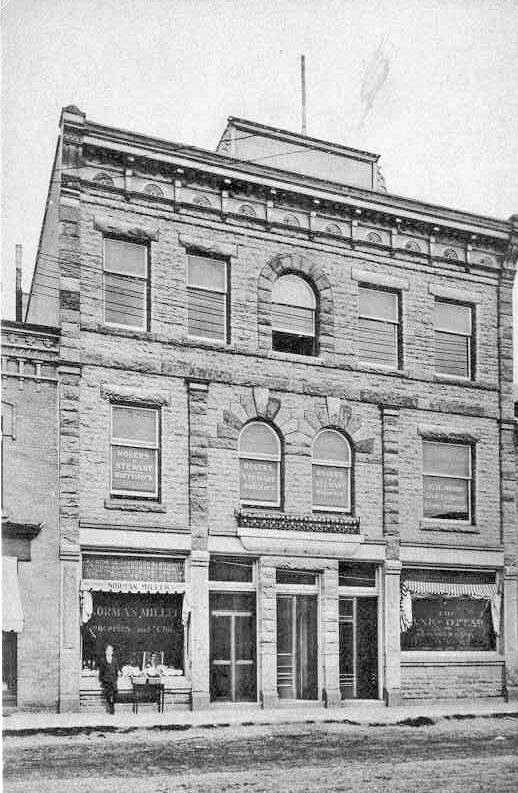
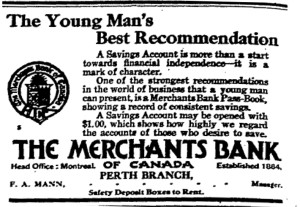
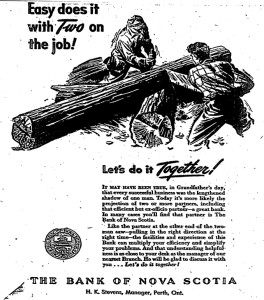
BANK OF MONTREAL
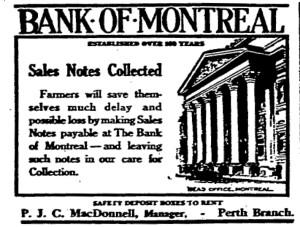
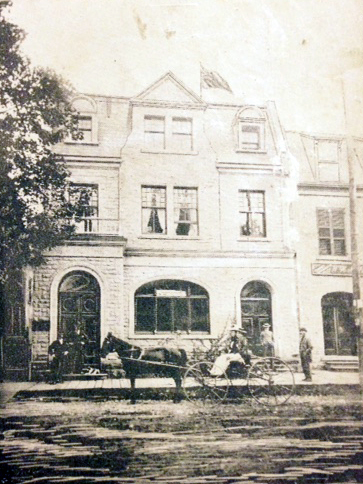
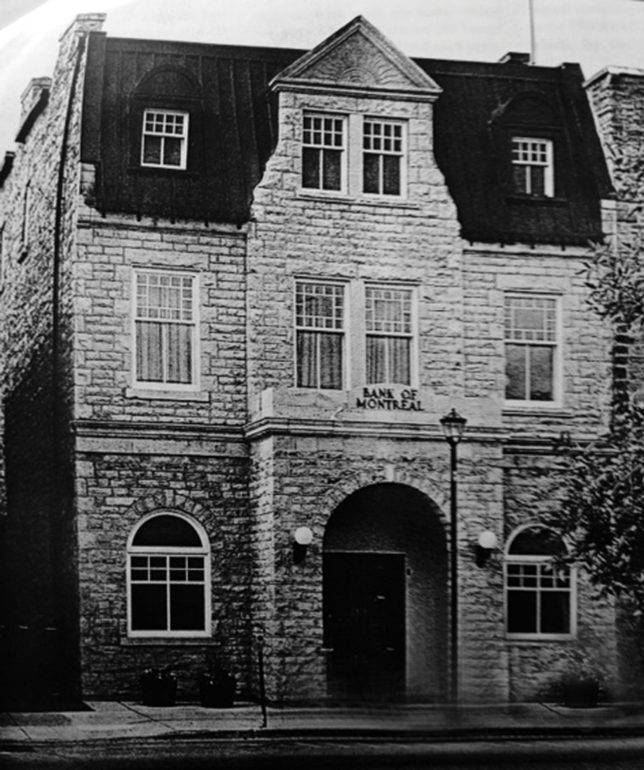
THE MERCHANTS BANK
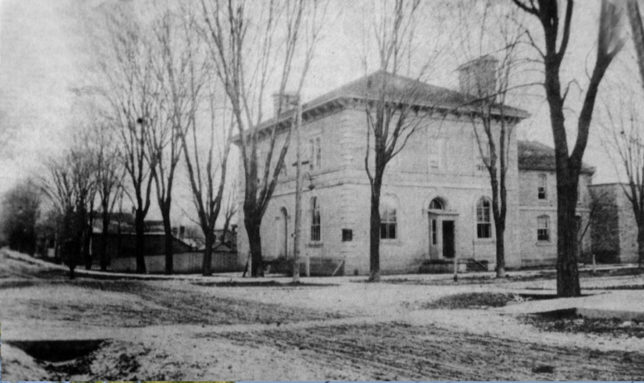
Merchants Bank 1904. St. Andrews Church purchased the building in 1921 to provide additional meeting space it served as a place of Worship from 1923 until the new Church was ready in 1928. The new church would be built on the empty lot to the left of the building. The building was purchased for $8,000.00.
THE BARRIE HOTEL
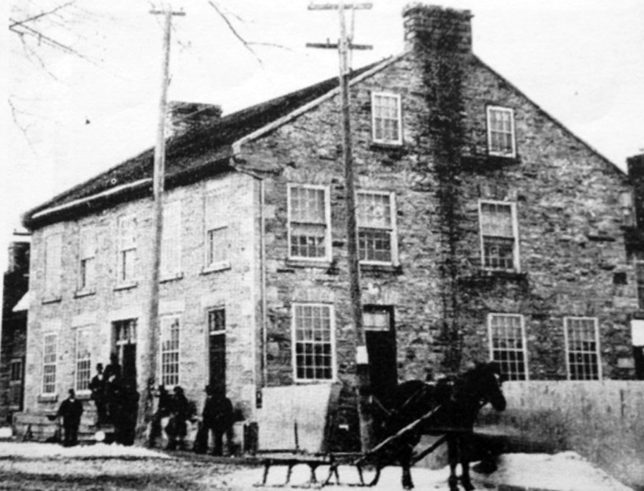
The Barrie Hotel was constructed in 1843/44. The Hotel later became The Imperial Hotel on Wilson Street. Miss Fidler’s School was next door. Photo courtesy the Perth Museum.
HOTEL IMPERIAL
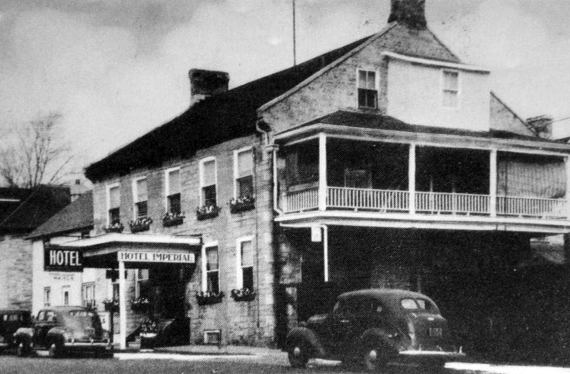
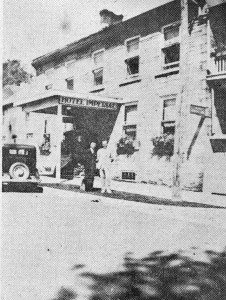
Ed Lambert Mgr., 1948
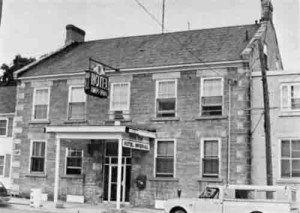
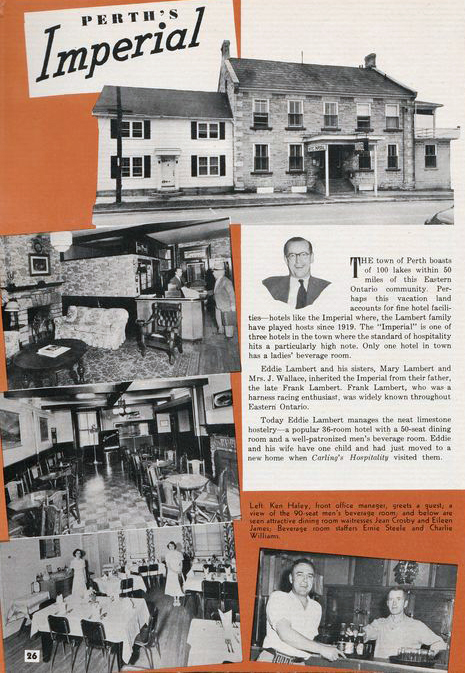
A page from Carling Brewery Hospitality Magazine c1950s
The town of Perth boast of 100 lakes within 50 miles of this Easter Ontario community. Perhaps this vacation land accounts for the fine hotel facilities – hotels like the Imperial where, the Lambert family have played hosts since 1919. The “Imperial” is one of the three hotels in the town where the standard of hospitality hits a particularly high note. Only one hotel in town has a ladies’ beverage room. Eddie Lambert and his sisters, Mary Lambert and Mrs. J. Wallace, inherited the Imperial from their father, the late Frank Lambert. Frank Lambert, who was a harness racing enthusiast, was widely known throughout Eastern Ontario. Today Eddie Lambert manages the neat limestone hostelry – a popular 36 -room hotel with a 50 – seat dining room and a well-patronized men’s beverage room. Eddie and his wife have one child and had just moved to a new home when Carlings’ Hospitality visited them.
Caption for the photos: Left. Ken Haley, front office manager greets a guest, a view of the 90-seat men’s beverage room and below are seen attractive dining room waitresses, Jean Crosby. and Eileen James. Beverage room staffers Ernie Steele and Charlie Williams.
WEST WARD GROCERY
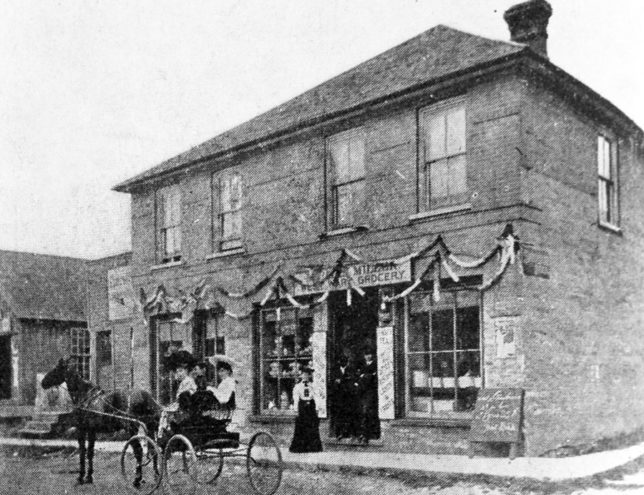
This two storey building was built in 1878 at the corner of Wilson and Glascott Streets. From 1880-1890, it was home to James Allan’s Store that dealt in staple and fancy dry goods, groceries, provisions, crockery, glassware etc. The sign in this picture says, “ West Ward Grocery”. In 1920 it became Wilson’s The Red and White Store then W. I. Smith took over the business. The building was destroyed by fire in 1960 and demolished. 1962 a B.P. Service Station owned by Harvey Moore was built and was after, owned by Bob Cameron.
D. HOFFMAN & SON
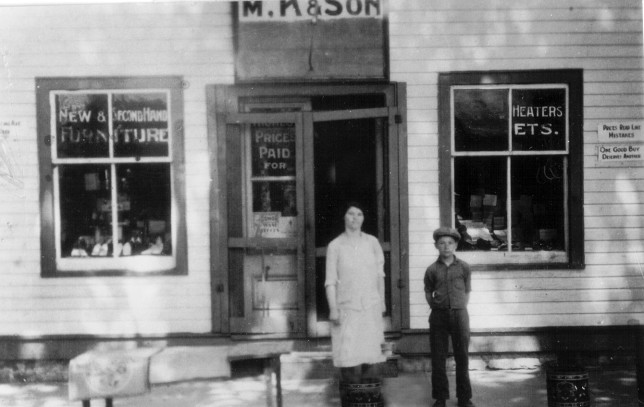
1942. Mrs. Rebecca Hoffman and son Al in front of store. Photo courtesy Eli Hoffman.May 28, 1928, David Hoffman and his wife, Rebecca, arrived in Perth to set up a dry goods store at 155 Gore Street. The business started under the name M K & Son was the forerunner to D Hoffman & Son and the start of the Hoffman family’s business in Perth. The building shown above eventually became the home of Benny K’s. In 1942 the business moved a half block north to the present location of the Perth Flea Market still under the guidance of the Hoffmans. Yardgoods, footwear, work clothes, ladies wear and small wears were among the main stock in the store handled in the 1940’s. Later Glidden Paints and floor coverings became the main focus.
RUBINO and SONS

First location on Gore Street and then expanded into the area to the right, Reward Shoe Store, c. 1957. Photo courtesy the Perth Museum.
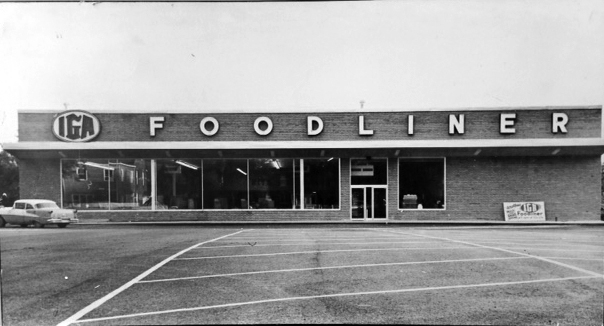
Rubino’s new location on Wilson Street early 1960’s.
THE DOMINION STORE 1922
The store at that time was on Foster Street just up from the Revere Hotel. In this picture are the store manager, Mr. Homer Fleming and the first clerk, Miss Evelyn MacLean (Mrs. Victor Young). Prices on some of the items are as follows; Shopping bags only 3 cents, Picnic Hams 19 cents, Sliced Bacon 32 cents per pound, Pure Lard 20 cents, Soap Chips 2 pounds for 29 cents, Tapioca or Sago 14 cents per pound, White Beans 3 pounds for 25 cents. The store was moved to a larger premises across Foster Street to the Meighen Block and then later out to Wilson Street beside the Brewers Retail Store.
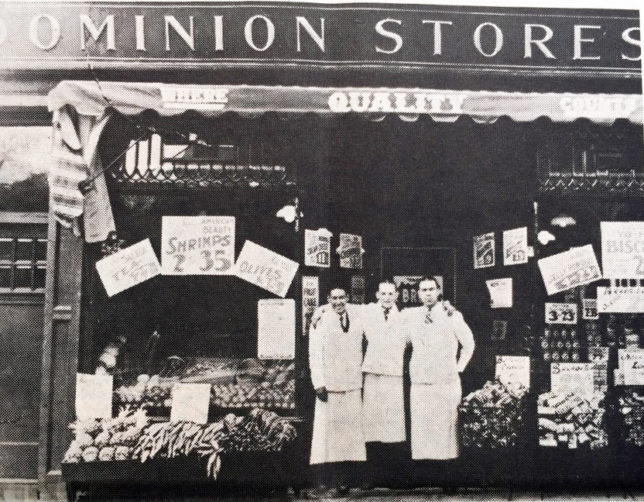
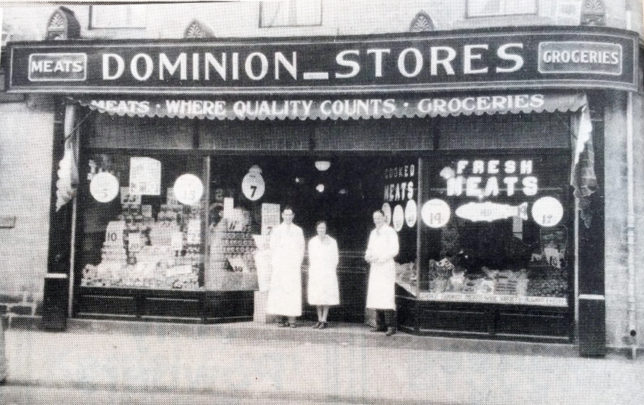
DOMINION STORE STAFF 1938. Photo in front of the Dominion Store at the larger Foster Street location. Front row, left to right; Harold Woermke, grocery manager, Arthur (Boat) Perry, Ray Bennett and John McParlan. Back row, left to right; Joe Ryan, Howard Noonan, meat manager, Jack Noonan. The little fella in front is Jimmy Noonan. Perth Courier Photo.
J. QUATTROCCHI
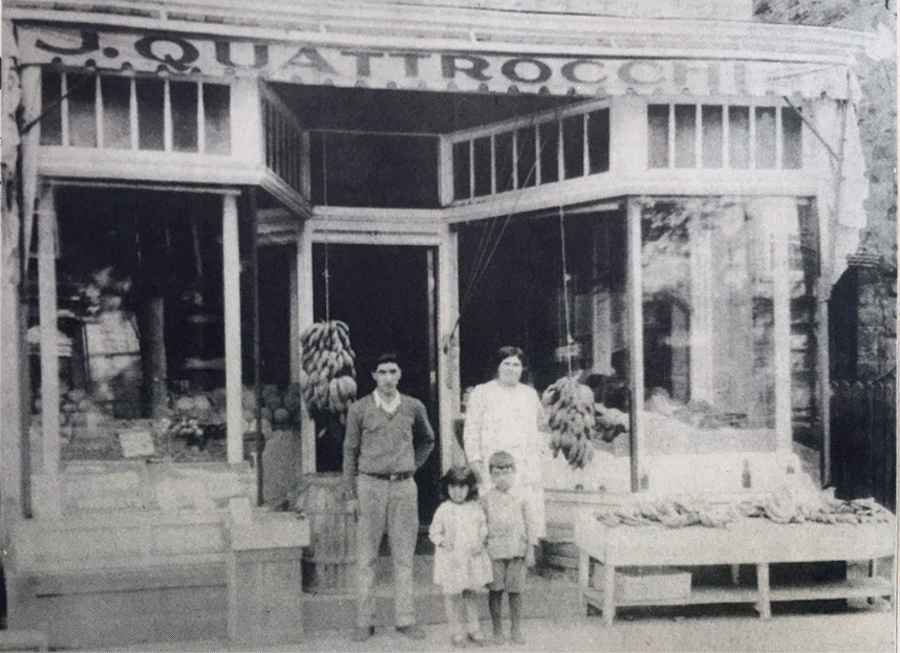
Picture taken in 1927 in front of J. Quattrocchi fruit store on Gore Street. The wall of the Bank of Montreal can be seen to the right. In the picture are Murray and his mother and in front Mary and Joe.
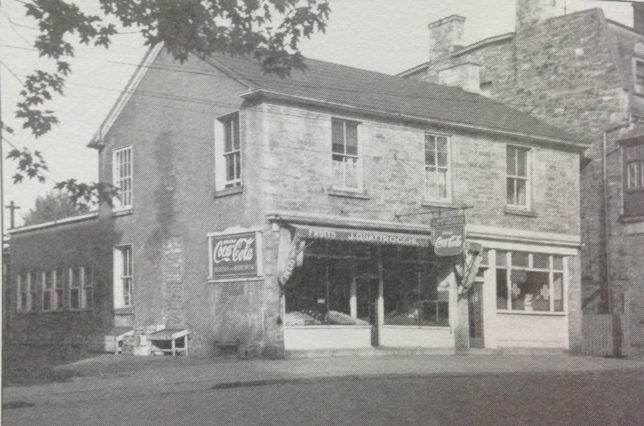
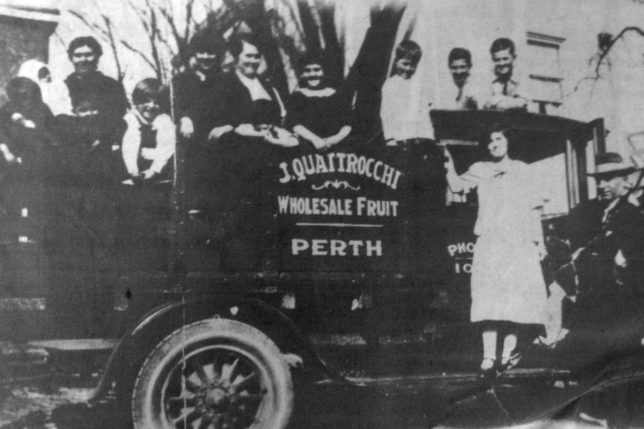
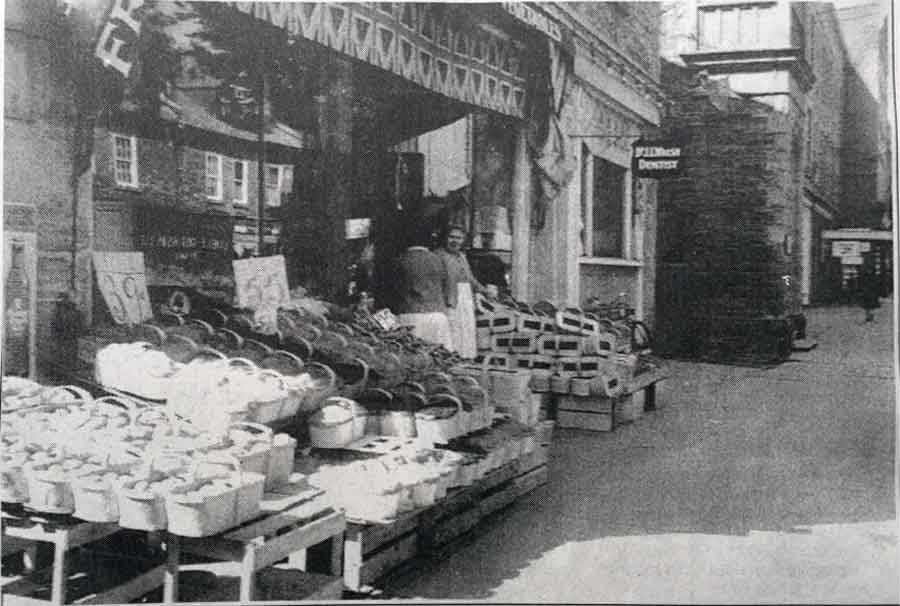
This photo was taken around 1942 and shows the front of J. Quattrocchi fruit and vegetable store which opened on Gore Street in 1922. In the photo to the far right you can see the marquee for the Perth Theatre, the Bank of Montreal and the sign for Dr. Walsh, Dentist Office, which was on the second floor of Quattrocchi’s store. With changing times in the late ’60s and the trend to chain stores it was decided to close the retail store after 47 years of business and concentrate in the wholesale from the warehouse in Smiths Falls which is still in business today.
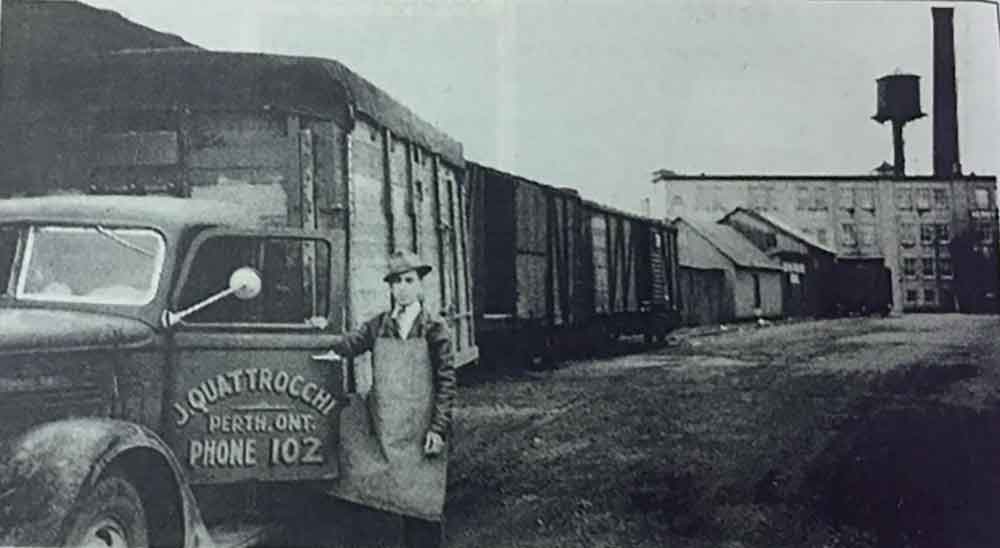
Phil Quattrocchi, of J. Quattrocchi, strikes a pose in front of the store’s truck around 1940. He was likely piking up supplies for their local fruit and produce store from the train which had pulled into the siding. This track ran right up to the Jergens plant which can be seen in the background.
DODD’S GROCERY STORE 1905
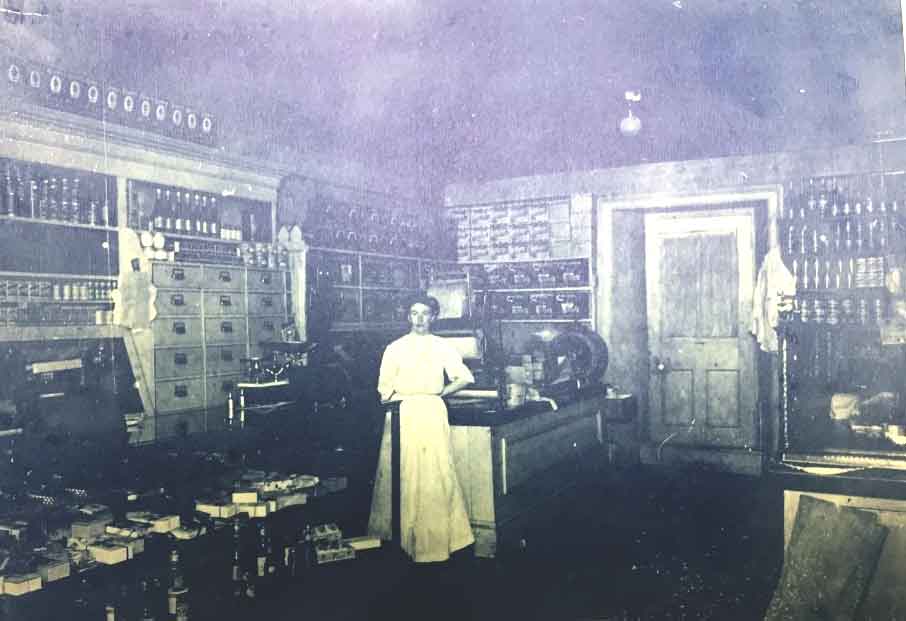
Located at 60 Gore Street. Mrs. Norman Dodds, Matilda.
NEW LIQUOR STORE OPENS ON WILSON STREET 1956

The staff of the new Liquor Store pictured left to right are Murray Norris, Gerry Osborne and Larry Brady.The Liquor Store at the time was one of the most modern in Eastern Ontario. Liquor Store was built on the site of the old Richard Wilson Livery Stable. Above the store there were three apartments. The new spacious liquor store had a Terraza floor and the walls were of pastel green. Plywood and Masonite were the materials used for the counters and storage shelves in the rear. To give colour to the interior the walls were hung with pictures depicting different scenes throughout Ontario. The general contractors were R. T. Parks and Son. The electrical intsallations were by Crawford Electric and for plastering E. Kerr and Co. N. C. McCallum and Son of Rideau Ferry provided the cement blocks (over 8,000) and the Perth Planing Mill the necessary sash and frames, Frank Cole was responsible for the plumbing and heating while all the excavation was done by J. Bingley of the Lavant Construction Co and Code Construction, Smiths Falls. The building was owned at the time was W. James Barr of Perth
PERTH & DISTRICT CO-OPERATIVE SERVICES
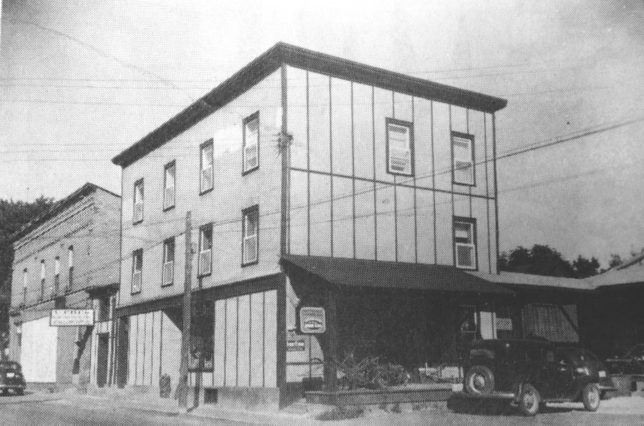
Located on Peter street The Co-op was located on the ground floor and was managed by a local farmer, Dan Hogan.
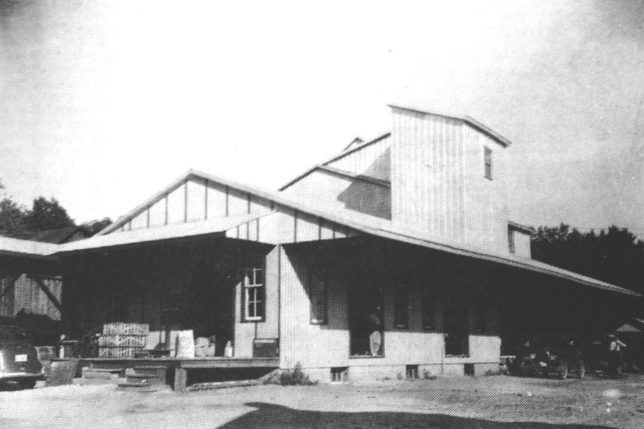
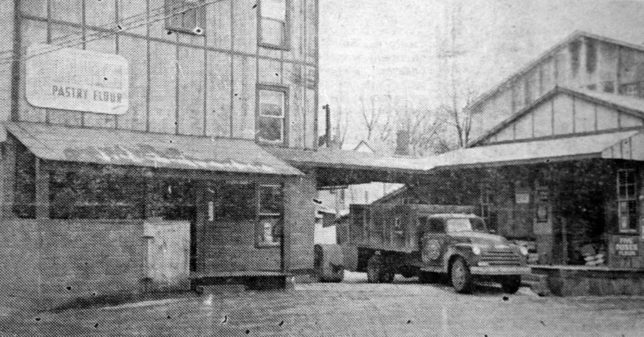
This large feed mill was constructed in 1940 to meet the growing demands for feed and fam supplies. In 1977 there was a membership of about 700.
GAS STATIONS & CAR DEALERSHIPS
PERTH MOTOR SALES
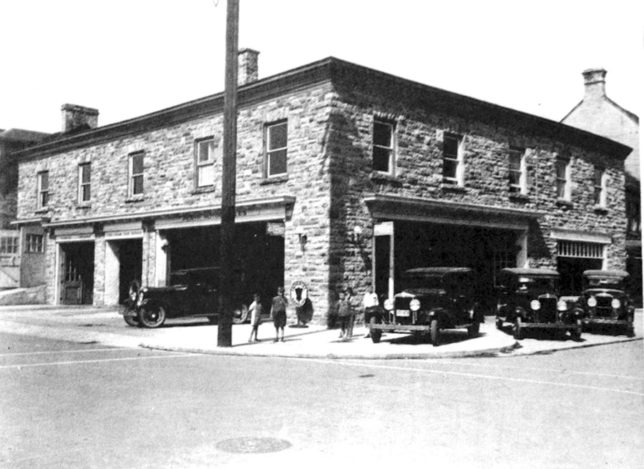
Photo taken in the late 1920s. In 1890 to 1927 this origianl site housed Cameron Brothers livery stable. In 1911 the building was renovated with coloured stone and the ground floor had 10 stalls, blacksmith shop and office. The second floor had15 stalls, store room for rigs and a hay loft. In 1927, D.W. Reid (formerly of James and Reid Hardware) purchased the property from the Camaron family who had operated a livery business there. The building was renovated so cars could drive in from either street and gas pumps were installed. A showroom was added, also a repair shop. The doors and ramp to the left was the entry to the showroom on the second floor. Through the 1920s, 20s and 40s it was a service station, fuel oil depot and auto agency. G.M., Essex, Hudson and Studebaker cars were sold. In 1933 Mr. Reid sold the property to James Brothers.
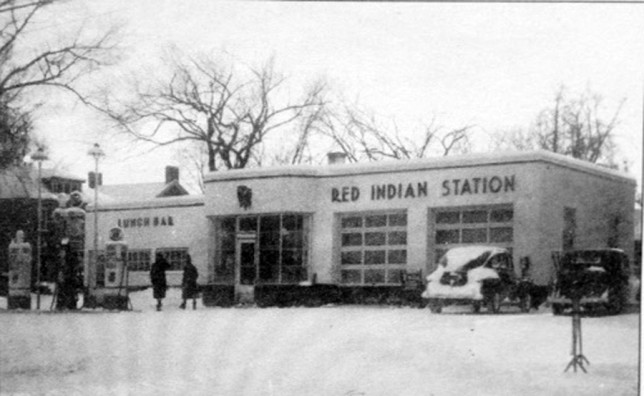
In 1928 the sheds used by Wampoles, on the property formerly Spalding and Stewart distillery, were demolished and McColl Frontenac erected a saloon service station. It became a Chrysler Dealership operated by Robert Craig. In 1935 it became the Red Indian service station. 1940-48 Craig and Ferrier enlarged and renovated and a small lunch bar was added to the left side of the building.
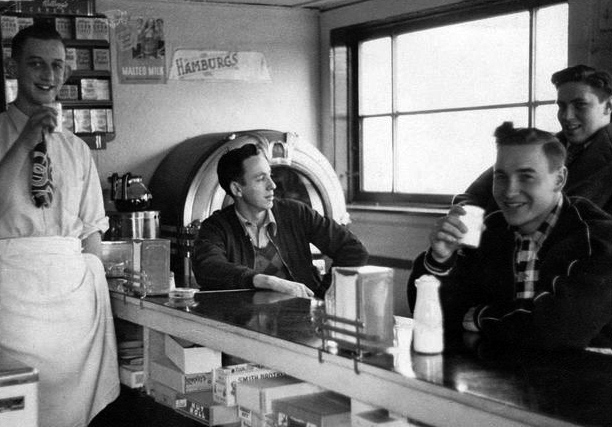
PERKINS MOTORS
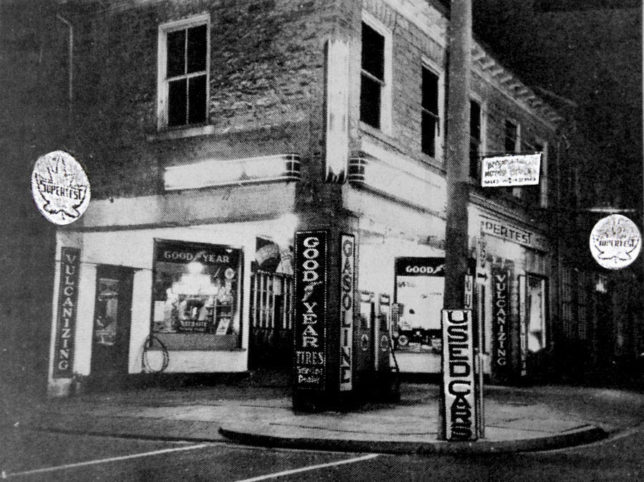
Corner of Wilson and Peter Streets. Building originally Mendels Department Store converted into Perkins first garage before being torn down in 1946 to make way for new modern building.
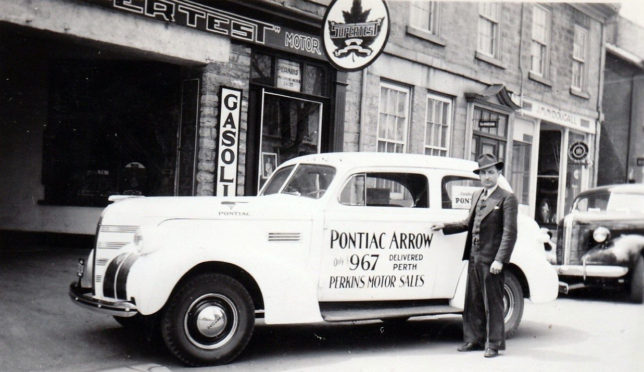
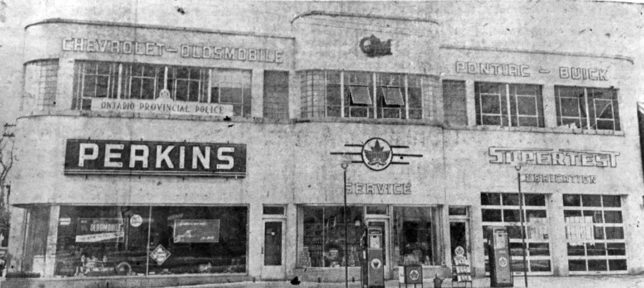
New art deco style building 1947. The ground floor had show rooms, parts department, offices and service area were all in the front area. The rear had the service area for commercial vehicles with access from both North and Peter Street.
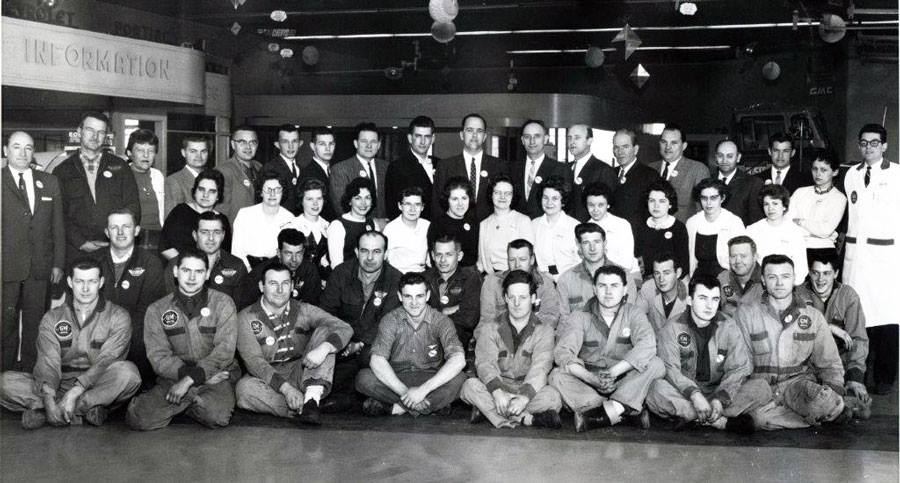
Group photo of employees of Perkins Motors c. 1962.
Front row, left to right; Burns Greer, Bill North, Bob Frizell, Jim Tryon, Roy Durant, Jack Bowes, Jim Devaney, Wally Holowaczuk. Second Row (kneeling) Vern Himmleman, Rene Van Oosten, Vince McGlade, John Paruboczy, Joe Watts, Don Rutherford, Andy Morrison, Bernard Stroud, Eric Dixon, George King. Third row; Katie Williams, Joanne Miller, Kaye Wiseman, Bernice Closs, Lois Dunham, Linda Day, Lorna Prentice, Kathy Playfair, Barbara McCord, Vera Knapp, Mary Rubino. Back row left to right; Joe Perkins, Bill Publow, Myrtle McKendry, Bill Howie, Roon Gamble, Jerry Harvey, Ross Gray, Alf Pedley, Frank Holland, Bob Dowdall, Alois Kolarik, Frits Gysbers, Morley McIntosh, Frank Tarle, Nick Madrygar, Tom Fournier, Anita Dunn, Harry Perkins. Missing: Harold Rogers, Jim Ramsay, Jerry Bennet, Don Campbell, Russ Hogan.
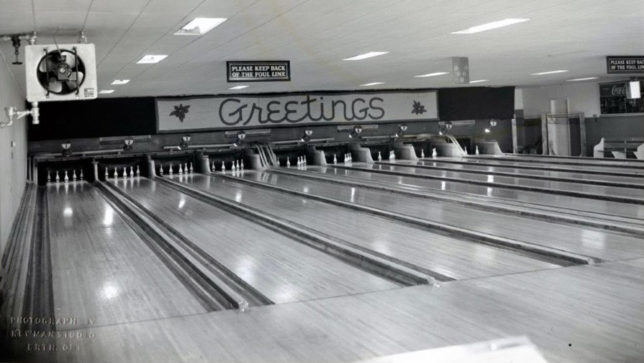
The Bowling Alley opened in the second floor rear section of the Perkins building over the garage in 1947. It was a popular place with all kinds of leagues in action.
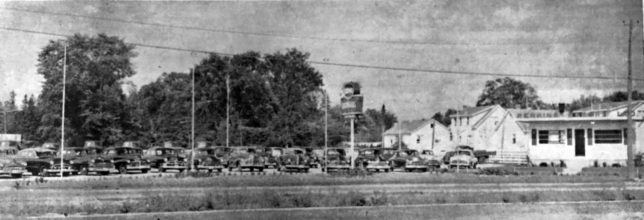
Perkins Used Car Lot on Wilson Street by the train tracks, 1951.
Barr’s Service Station
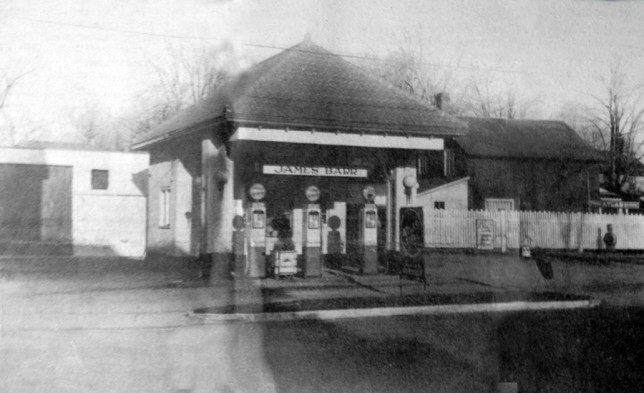
James Barr service Station c.1930, corner of D’Arcy and Wilson Streets.
Grainger’s Garage
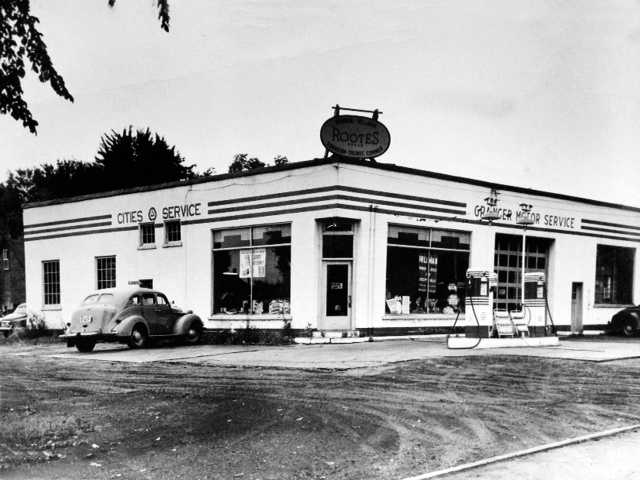
Ed Grainger’s Garage on Craig Street
McTavish’s Garage
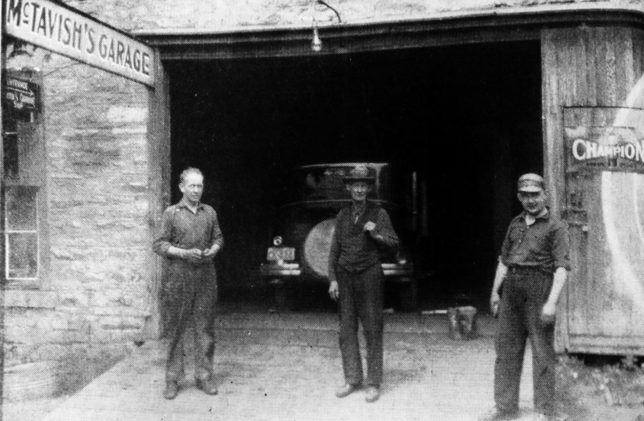
McTavish’s Garage on North Street 1920’s. The stone building was heavily damaged by fire in the late 1930’s. Nelson Kimberely, Albert (Ab) Leighton and James Gordon. Mr. Kimberly and Mr. Gordon worked in McTavish’s Garage while Mr. Leighton repaired and painted horse-drawn buggies on the second floor of the building.
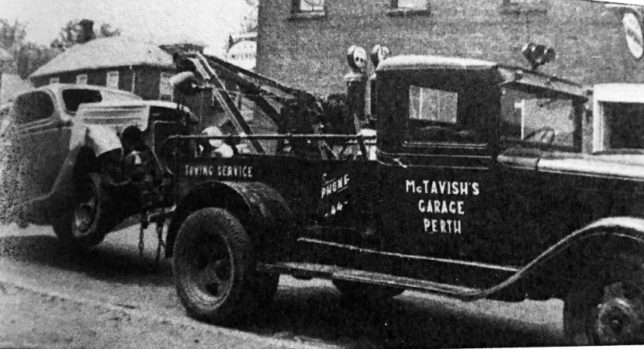

Regent Service Station
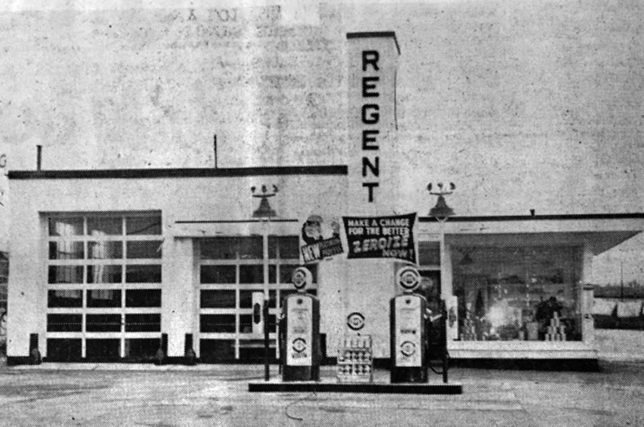
REGENT SERVICE STATION 1955. Perth’s first Regent Service Station, featured 4 pumps, special lubrication equipment and a roomy lot for fast convenient service. Jack Andison was the Lesee of this New Station.
A&B Motors
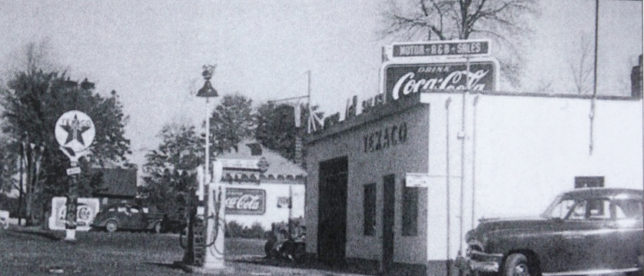
Wafare B/A Service Centre
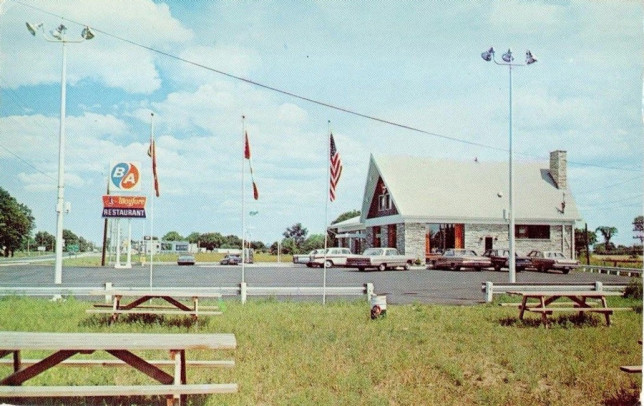
Wayfare Restaurant and B/A service center. c1964
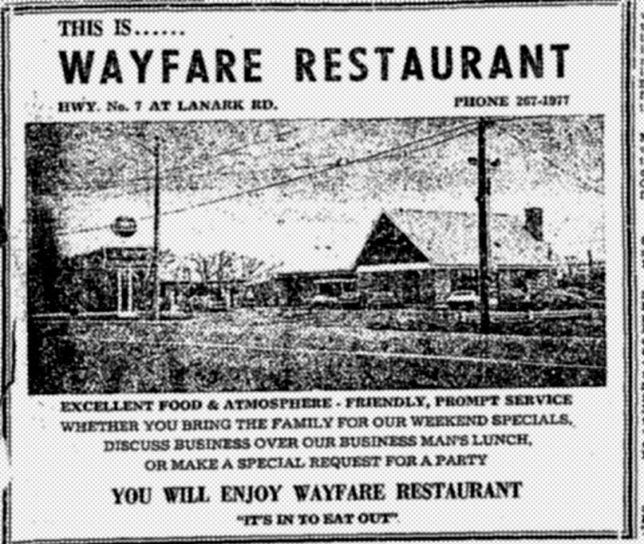

PERTH LIQUOR STORE

NEW LIQUOR STORE OPENS ON WILSON STREET 1956
The staff of the new Liquor Store pictured left to right are Murray Norris, Gerry Osborne and Larry Brady.
The Liquor Store at the time was one of the most modern in Eastern Ontario
Liquor Store was built on the site of the old Richard Wilson Livery Stable. Above the store there were three apartments. The new spacious liquor store had a Terraza floor and the walls were of pastel green. Plywood and Masonite were the materials used for the counters and storage shelves in the rear. To give colour to the interior the walls were hung with pictures depicting different scenes throughout Ontario. The general contractors were R. T. Parks and Son. The electrical intsallations were by Crawford Electric and for plastering E. Kerr and Co. N. C. McCallum and Son of Rideau Ferry provided the cement blocks (over 8,000) and the Perth Planing Mill the necessary sash and frames, Frank Cole was responsible for the plumbing and heating while all the excavation was done by J. Bingley of the Lavant Construction Co and Code Construction, Smiths Falls. The building was owned at the time was W. James Barr of Perth.
ADVERTISING WAGON 1954

TAYSIDE BAKERY 1938-1977
Frank Vice opened the bakery in 1938 in the Sheriffs House (Coutts Coffee location now). Ad from 1956.
